Davey Street is named after Lieut-Col. Thomas Davey (1758 – 2 May 1823), second Lieut. Governor of Tasmania, 1813-19. A map of Hobart Town executed by Gov. Lachlan Macquarie in 1811 shows the street as Pitt Street, after British Prime Minister, William Pitt the Younger. There is no record of when the street's name was changed and by whom. Government surveyor James Meehan had drawn up the initial survey of the town of Hobart for Gov. Macquarie, and would have allocated the name Pitt Street at Macquarie's request in 1810. Meehan retired soon after Macquarie's departure, so it is most likely that Davey himself instigated the change after Macquarie and Meehan were no longer around.
Davey was a New South Wales Marine and member of the First Fleet to New South Wales in 1788. Davey was said to be weakly, and amiable by nature, but much progress was made during his administration, including the designation of Hobart as a free port. As lieutenant governor he had encouraged humane treatment of aborigines, and strong action against bushranging. His limited official powers had a consequential and negative effect in his subsequent reputation, as did his poor choices of subordinate officials. Davey was preceded by David Collins and succeeded by William Sorell on 9 April 1817.
Davey Street, between Elizabbeth Street and Hunter Street ran along the original waterfront until Victoria Dock was formed in 1840 (it was fully created and opened in 1891) when the seawall on Davey Street was built. Constitution Dock was constructed in 1850 along with a seawall on Morrison Street which disappeared when Franklin Wharf was built.
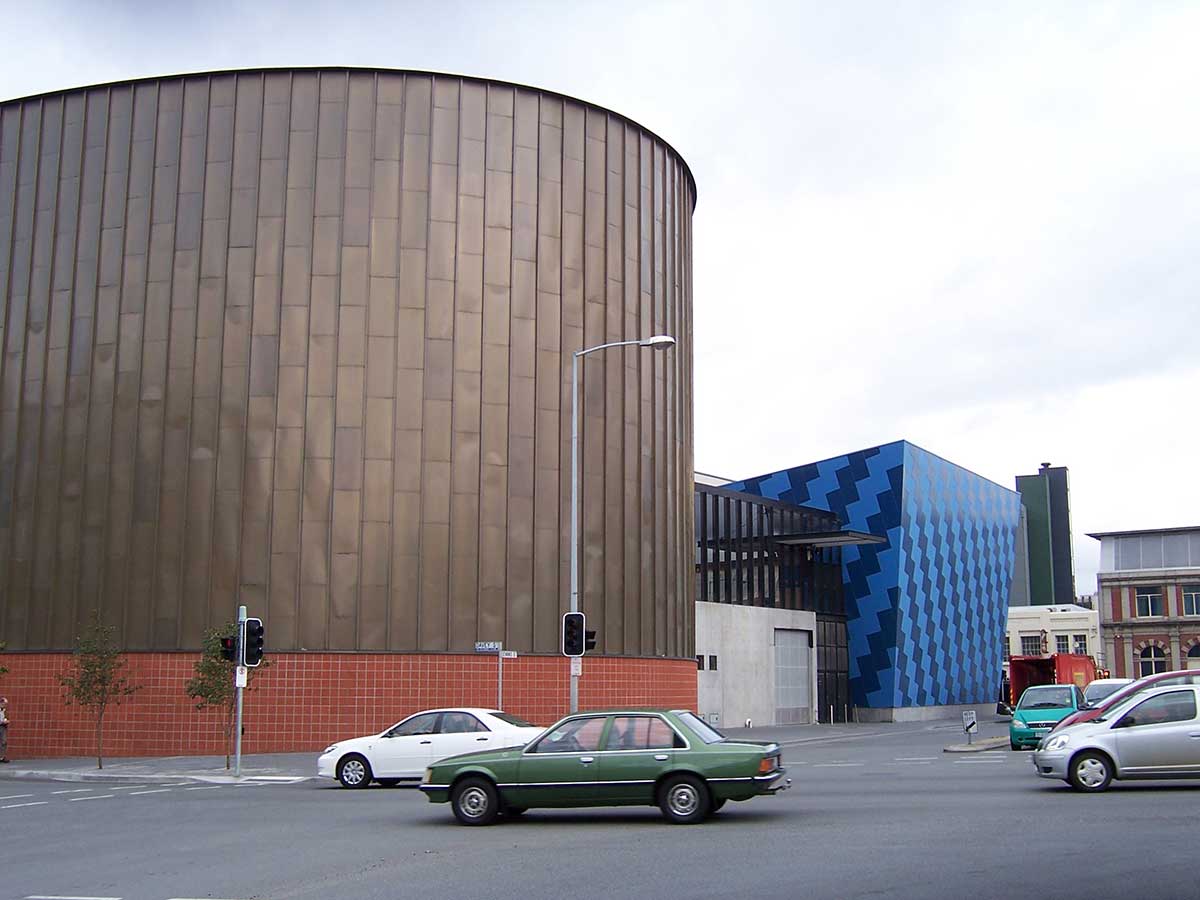
Love it or hate it—there is no ignoring the brass-clad exterior! Hobart’s striking Federation Concert Hall is a large, brass-plated Gasometer-like cylinder clinging to the side of the Hotel Grand Chancellor. Its once gleaming exterior has weathered with time (along with the hall’s controversy) and the venue has been embraced as the home for the renowned Tasmanian Symphony Orchestra. Tasmania's largest purpose-built convention facility, the Concert Hall and Convention Centre has tiered seating for 1100 people and the ballroom accommodates 1000. It was built on the site of swamplands where the Hobart Rivulet originally entered the River Derwent.

The Federation Classical style three storey Customs House, which today houses the Museum and Art Gallery Administration, was built in 1903 and designed by Shield & Baker. Built of locally quarried stone, it features rusticated stone pedestals and pilasters with a balustraded parapet, pyramidal slate dome arched pedimented porches with Doric pilasters and columns and sculptured figures. The Bond Store (1815) is one of the oldest surviving warehouses in Australia. It forms with the Customs House a group which attests to the successful development of the colony of Van Diemen's Land from simple beginnings to a prosperous State. This is reflected in the architectural styles of the two structures, the Customs House providing a strong, richly modelled facade in grand late Victorian neo-Renaissance design in striking contrast with the severe, Georgian Bond Store. The Commissariat Bond Store was built by the British Army Commissariat to store grain and bonded goods for the Colony of Van Diemen's Land.
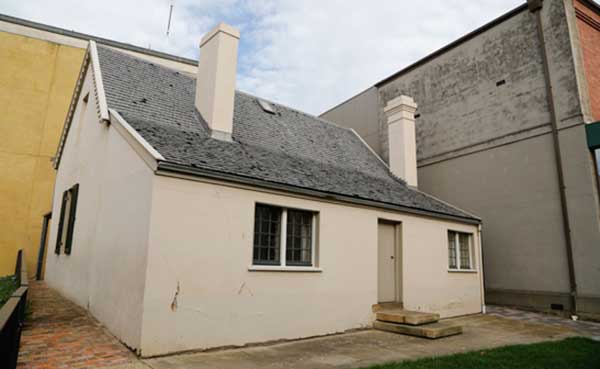
Wedged between Customes House and the 1960s Tasmanian Museum and Art Gallery wing is the last surviving building of the old Government House complex that covered the area now occupied by Franklin Square and Hobart Town Hall. It was built as a stables and quarters for the groom, then converted into a private residence in 1829 when Lieutenant-Governor Arthur’s private secretary moved in, and it was home to official secretaries and aides-de-camp for nearby Government House (located where Franklin Square now stands) until 1857. Gov. John Eardley-Wilmot died there in 1847. The house was built on what was once a low escarpment facing a small beach.
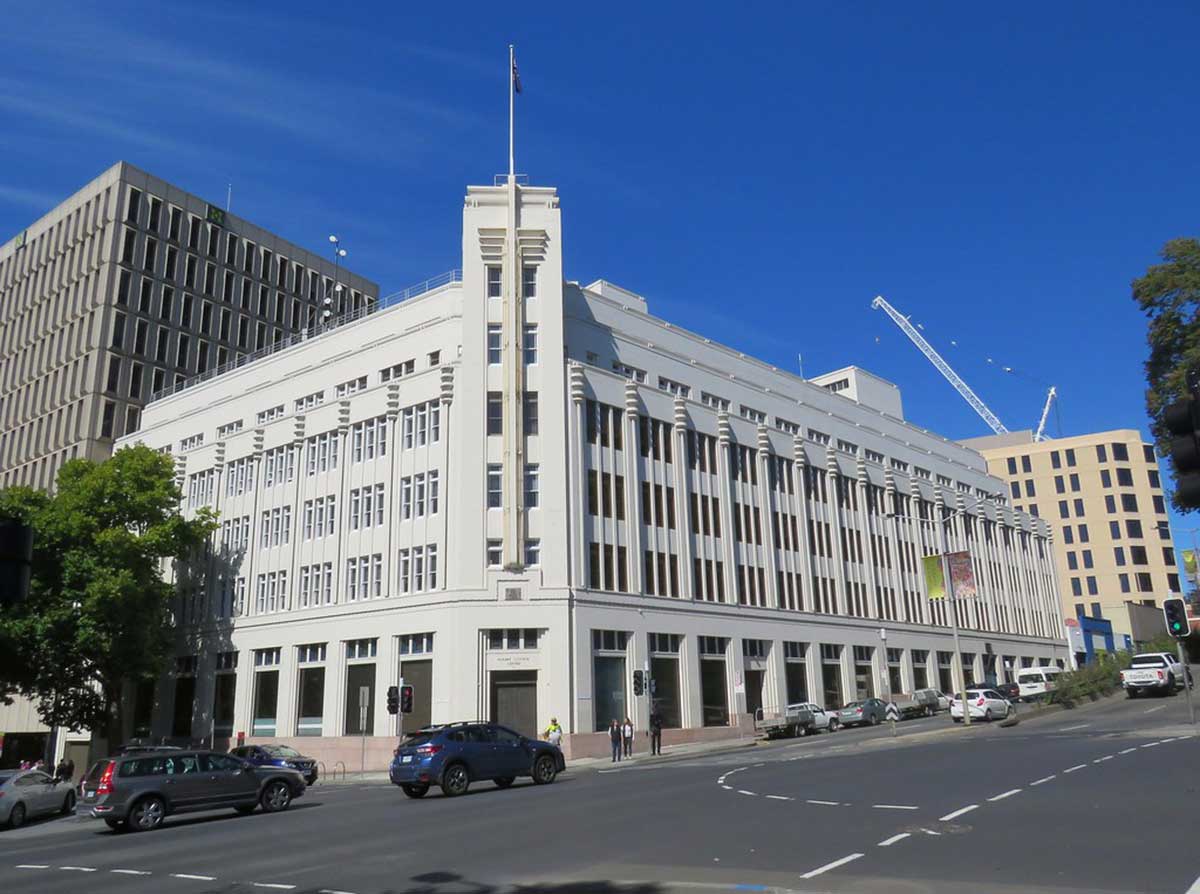
Erected as the headquarters of the Hydro-Electric Commission, this imposing six storey office block is one of Australia's finest examples of commercial Art Deco architecture. Its Art Deco features include unique laddered discs at the top of the fourth storey which suggest electrical insulators. The building's exterior was originally illuminated by neon tubing. The lobby is embellished with ubiquitous green tiles. Architect: A. & K. Henderson of Melbourne.
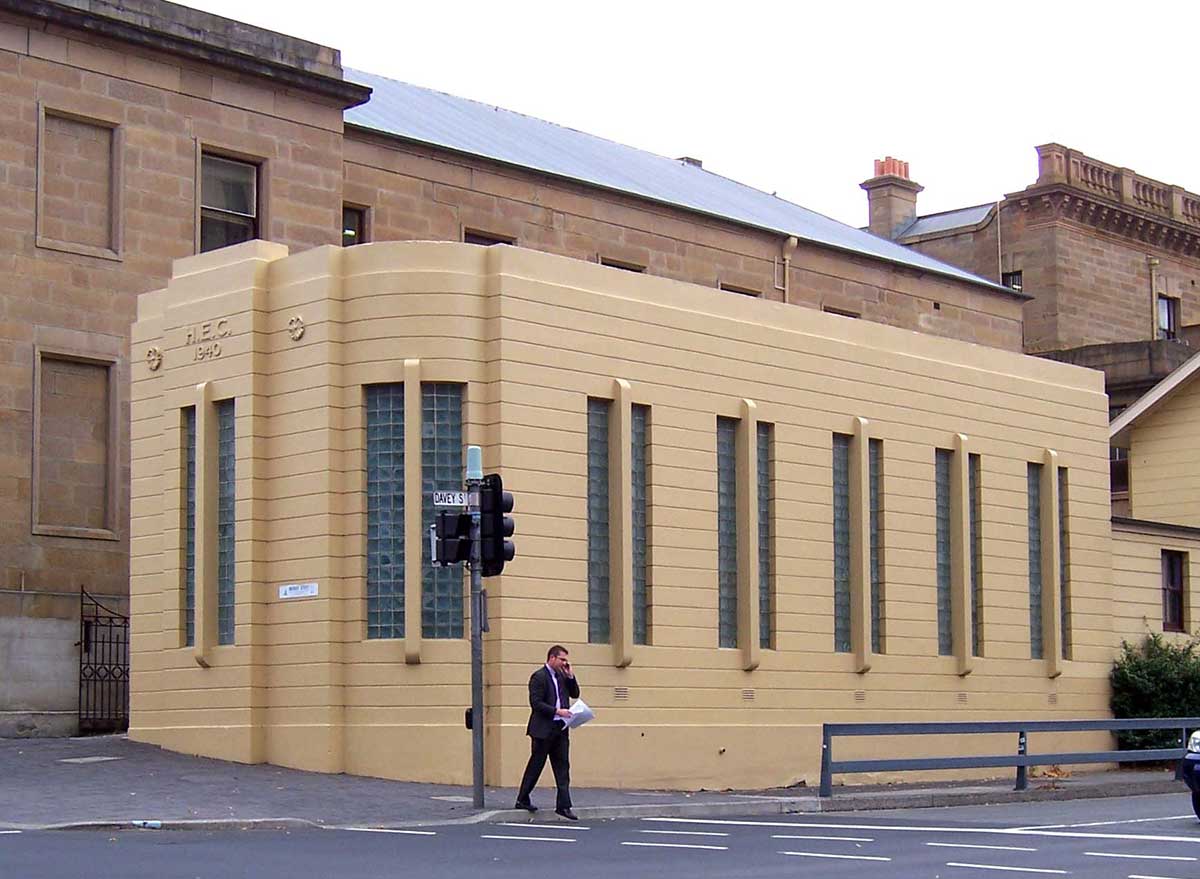
There are many great examples of sub-stations around Tasmanian towns and cities from the 20th century. This one, with its columned opaque glass brick windows and simple horizontal ribbing, is classic Art Moderne.
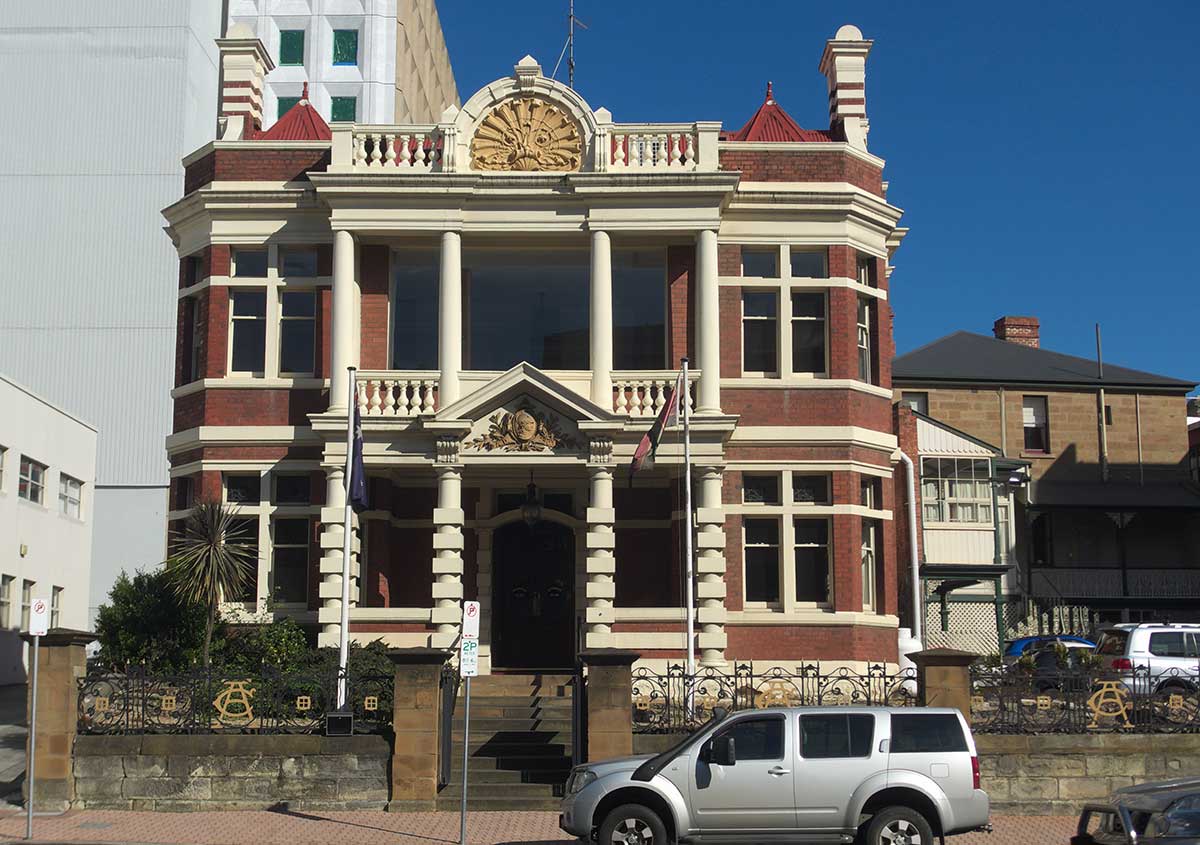
Built to cater for Hobart's gentry, this building features an unusual mix of Classical and Federation era influences. The upper floor fronting Davey Street has been extensively modified to permit the use of floor to ceiling windows. The gentleman's club was an important social-cum-cultural institution of the nineteenth century. It developed in Britain from the coffee houses of earlier times. The Athenaeum Club, Hobart, follows in this tradition. The club was founded in the 1880's and moved to its present purpose-built premises in 1904. Funds for the building came by way of George Adams, a club member who introduced Lotteries to Tasmania. Adams' cartoon appears on the logo of Tattersalls. Adams died only a few years later, and the funds were assumed as a gift. The Club was established as a social institution for a part of the Hobart establishment and membership was confined to men at its inception. Wives of the members were invited to attend only on particular occasions. As the century has progressed, and the culture become more liberal, it is now open to women.
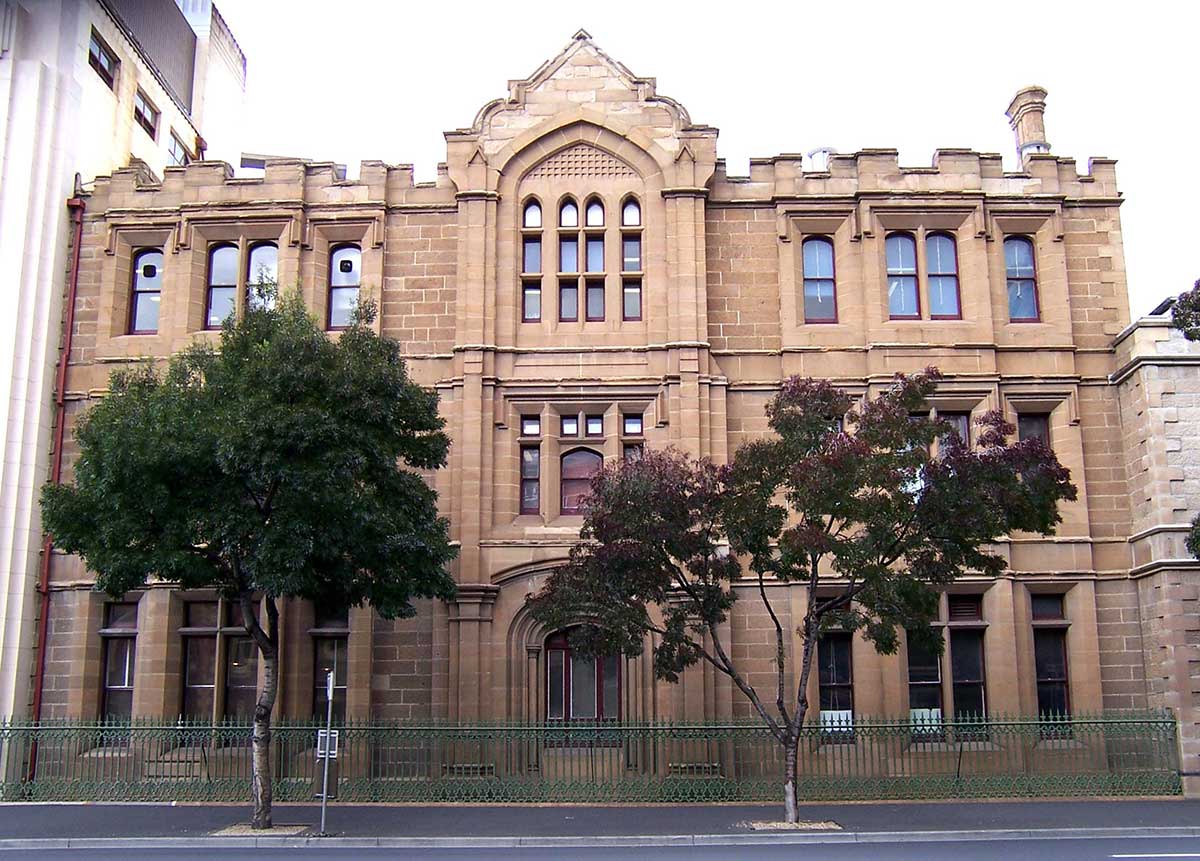
This building, formerly St Mary's Hospital, features a mix of Gothic and Tudor finishes. It served as a convict hospital between 1847 and 1860. It was subsequently used as office accommodation by several Tasmanian Government departments, most recently the Lands Department. Architect: W.P. Kay.
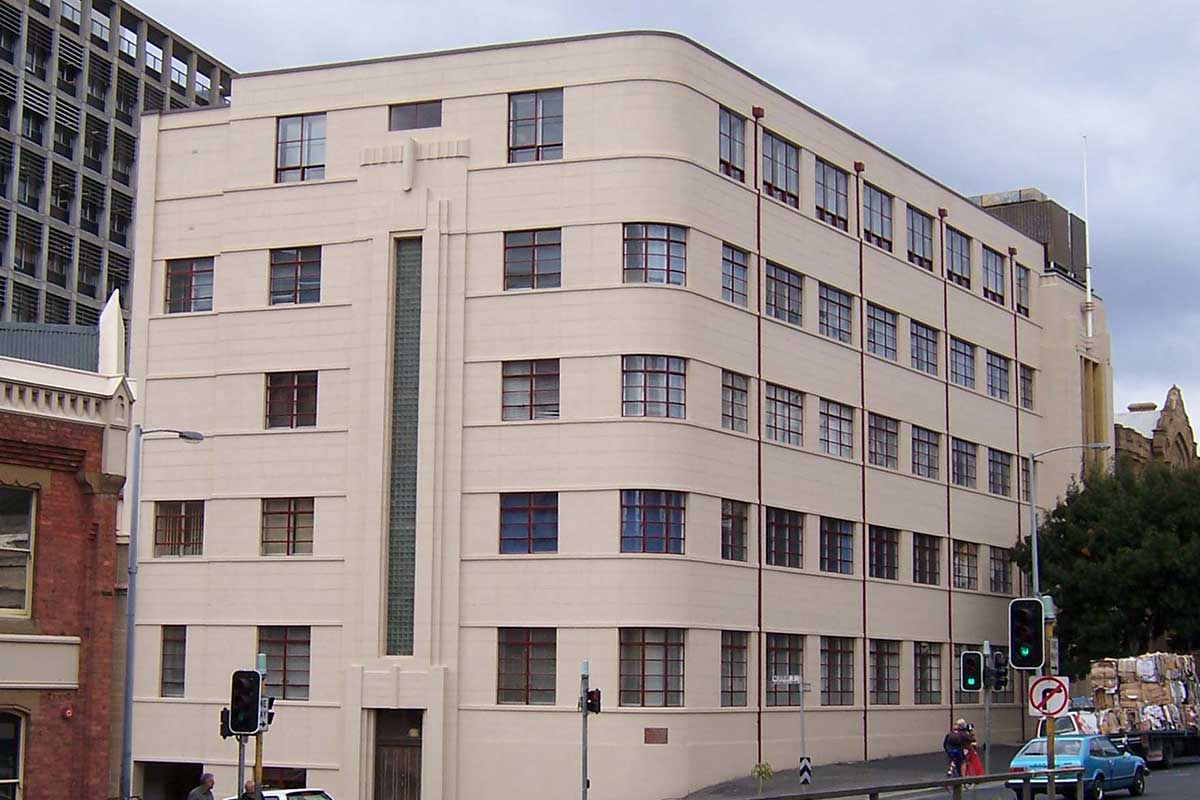
Six storey Functional style office building featuring a plain painted exterior, curved corner outer wall and a vertical glass block window which give light to the main stairwell between levels 1 and 4.
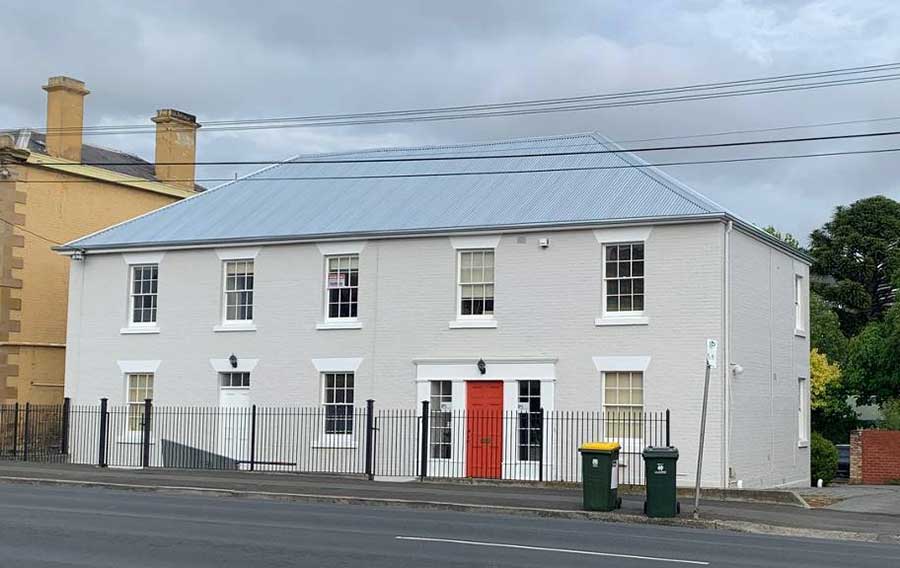
This property was a hotel for almost forty years but only had one landlord. James Priest was born on Norfolk Island in 1805 and arrived in Hobart with his parents when he was just two years old. Priest licensed these premises as the Joiners Arms in 1835 and changed the name to the Davey Street Inn in 1854. Priest’s steadiness, rectitude and perseverance allowed him to amass considerable savings but he had to give up his hotel on account of ill-health in 1874 and died the following year. The property remained in Priest family ownership until the 1930s.
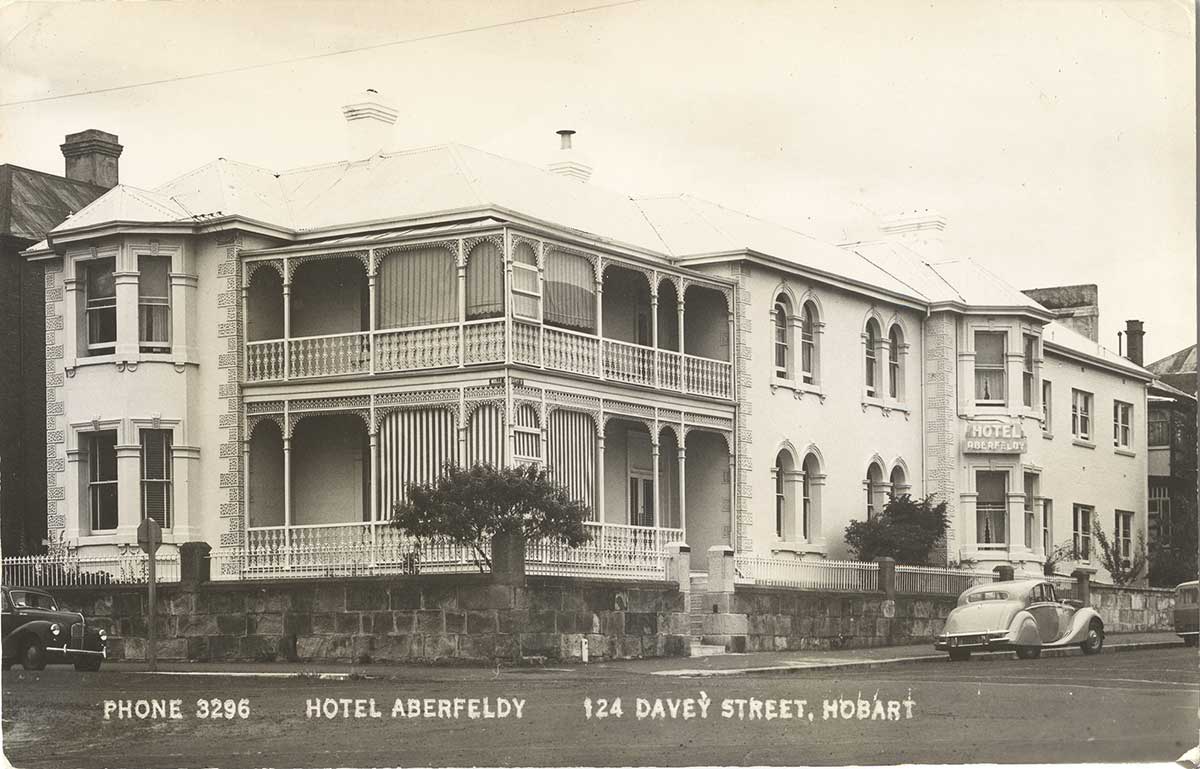
Thomas Dillon built a two-storey house on this site in 1886. It was well situated within easy distance of the city centre and contained every internal requisite for a gentleman’s residence. The property was purchased by Miss Lucy Todd in 1893 and became the Aberfeldy boarding house. It was then taken over by Russell Craw in 1915 before being acquired by the Phillips family in 1951. The building was enlarged from 22 to 50 bedrooms and modernised to provide luxurious accommodation with hot and cold water in every bedroom. In more recent years it traded as Bridie O’Reilly’s, but is now called the Hotel Soho.
The name recalls Scotsman Lachlan Macquarie, who was Governor of New South Wales 1810-1821. Macquarie played a leading role in the social, economic and architectural development of the colony, which at the time included Van Diemen's Land (Tasmania). He is considered by historians to have had a crucial influence on the transition of New South Wales from a penal colony to a free settlement and therefore to have played a major role in the shaping of Australian society in the early nineteenth century. He instituted a survey of Hobart which determined the form of the current centre of the city, and established numerous regional Tasmanian townships.
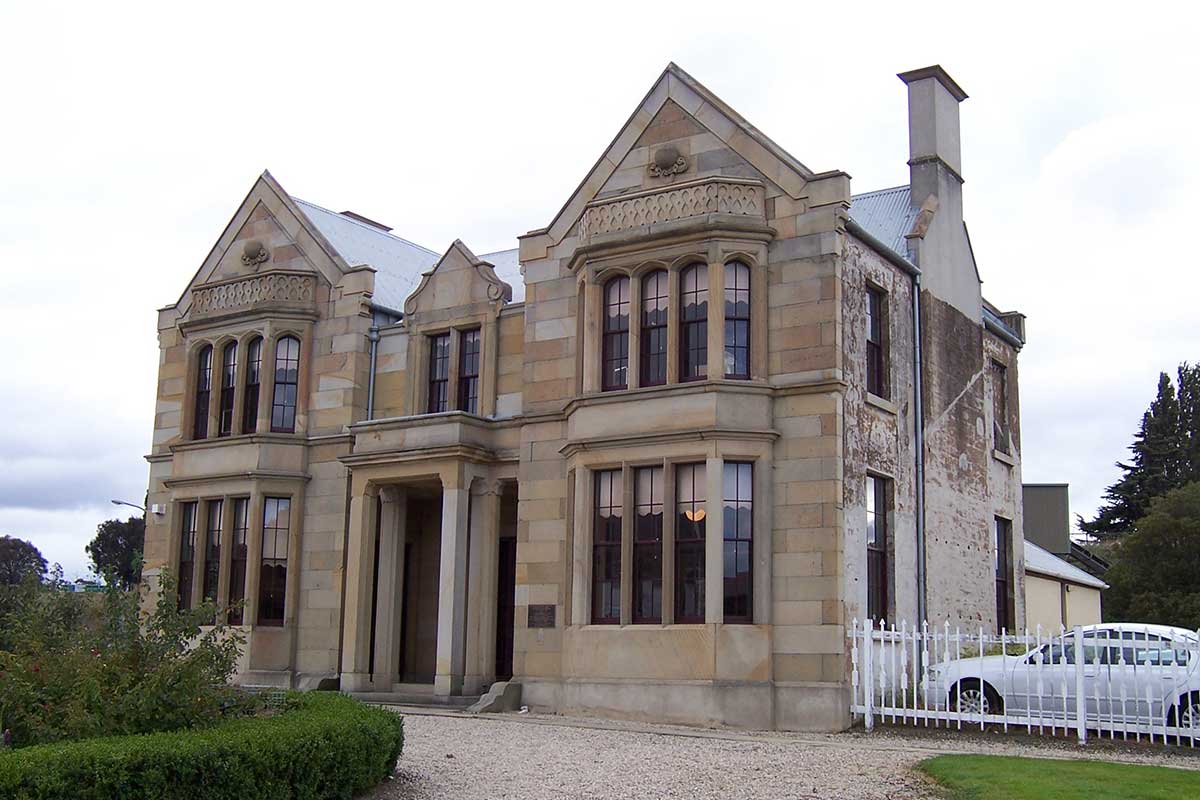
Early example of the Gothic style in a non-clerical building. The two storey stone building features projecting gables, two storey bay windows with baluster to the false terrace above and an iron roof. the building's designer in not known. From 1876 to 1890, the Tasmanian Main Line Railway Company occupied the building as its headquarters, as the building lay adjacent to the Hobart Railway Station and Main Line. In 1890, the State Government took over the T.M.L.R.C and the building remained headquarters for Tasmanian railways until 1938, when the Transport Commission was established. Thereafter it became the railway's printery and stationery.
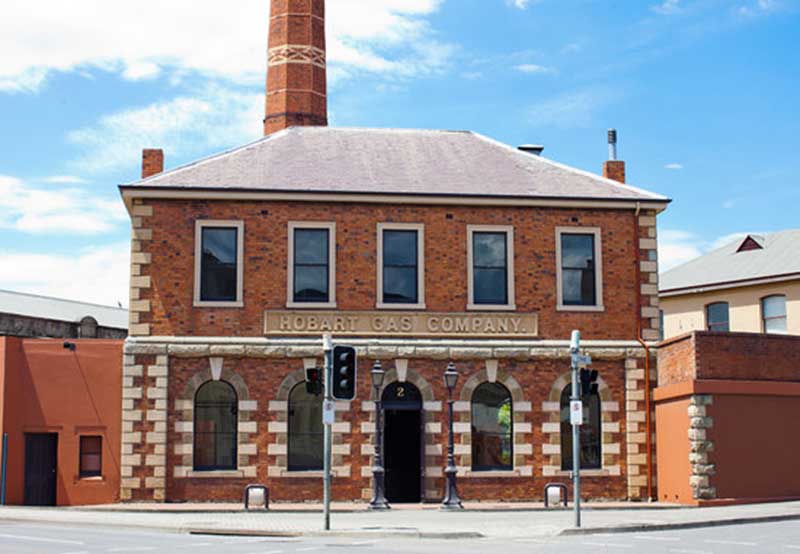
A large two storey office building of brick with sandstone quions, slate roof, and arched window at rear. The numerous buildings behind include a sandstone single storey industrial building (workshops); an elaborate brick and sandstone engine house (1898), including tall polychrome chimney; a small stuccoed single storey building (originally a stables) and the Roberts Stewart building facade.
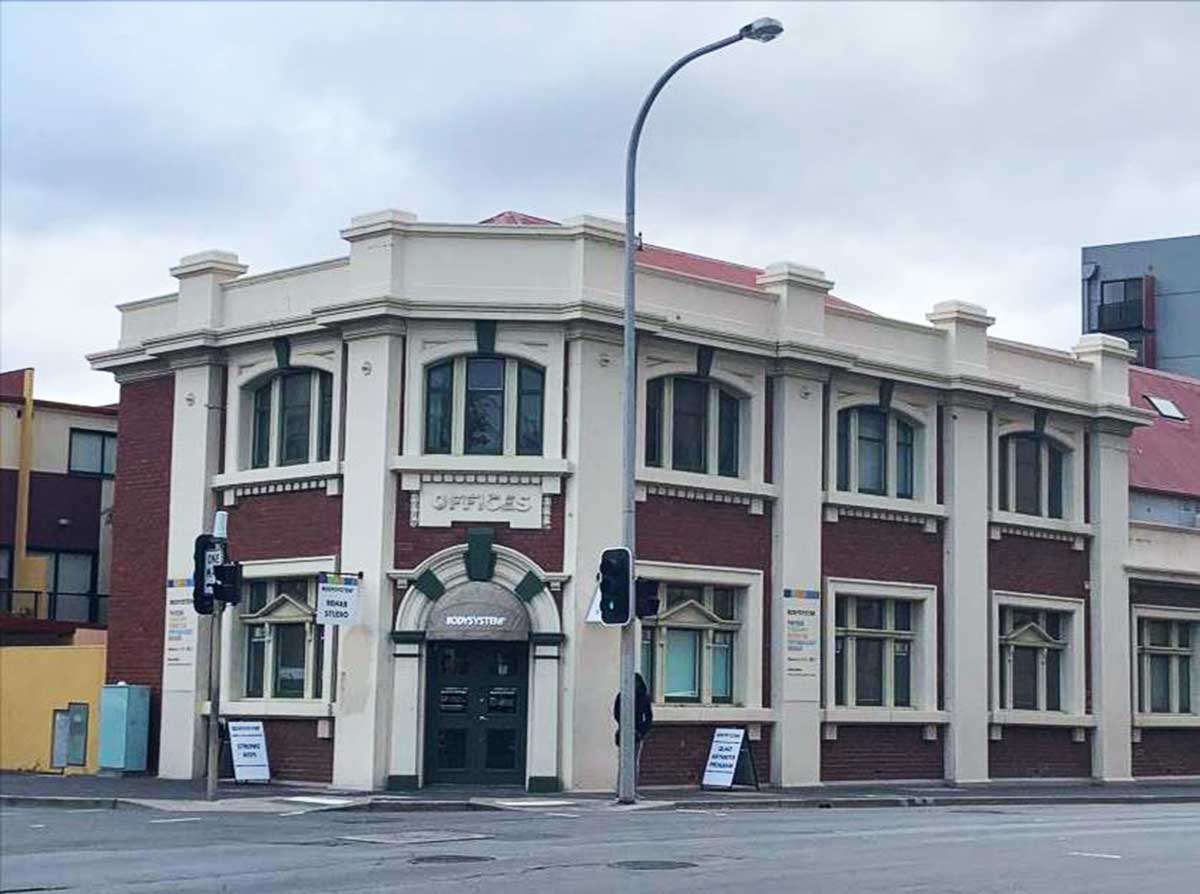
This building was Hobart’s main tramway depot. Electric trams started operating in Hobart in 1893. Initially run by a private company, the tramway system was purchased by the Hobart City Council in 1915. These offices were built in 1918. Constructed of brick with cement dressings, they complemented the architecture of City Hall on the north-west corner of the intersection. The ground floor accommodated managers and accountants while the first floor was entirely taken up by the engineering department. Two adjacent ground floor rooms were fitted up as a recreation room and a luncheon room for off-duty drivers and conductors.
Considerable difficulty was experienced in forming the foundations of the building as this was near where the Hobart Rivulet originally ran into Sullivans Cove when Europeans first arrived in 1804. The unstable ground conditions were overcome by driving down clusters of piles and then bridging over them with reinforced concrete beams.
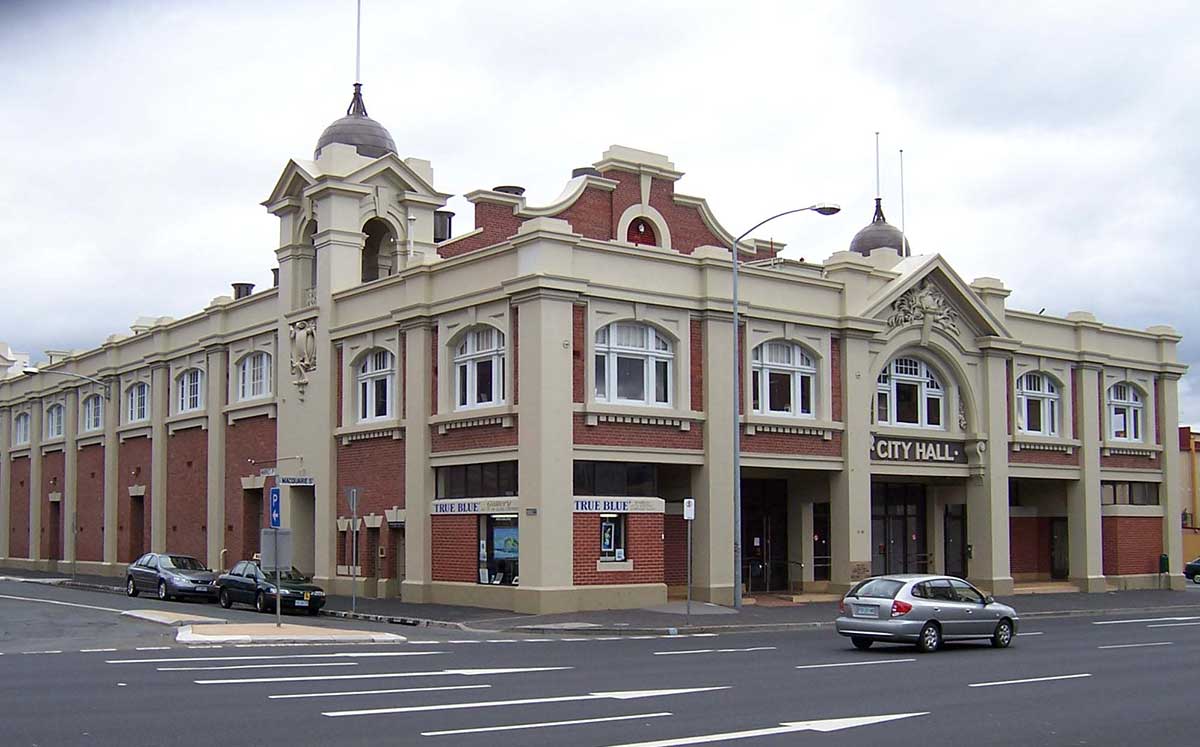
A Federation Anglo-Dutch influence is recognisable in the secondary brick parapeted gable which is stepped, scalloped and silhouetted against the skyline. Nominated as one of Tasmania's most underrated public buildings by the Royal Australian Institute of Architects, it was a competition winning design. Its site, which was formerly the city market-place, has been used for civic congregation in Hobart since the middle of the nineteenth century. The hall has been used for a range of purposes in addition to entertainment. During the Second World War, the City Hall was used as a store for the collection of "Clothes for Europe" campaign for the war effort. It has been used as a concert hall, sports venue including boxing and wrestling, ball room and for jazz recitals. The Hall has been also used for selling carpet and clothes. It has been used by members of parliament, for political rallies and as an election tally room. The hall is often the venue for school speech nights, trade and touring museum exhibitions Architect: Tasmanian Rusty N Butler.
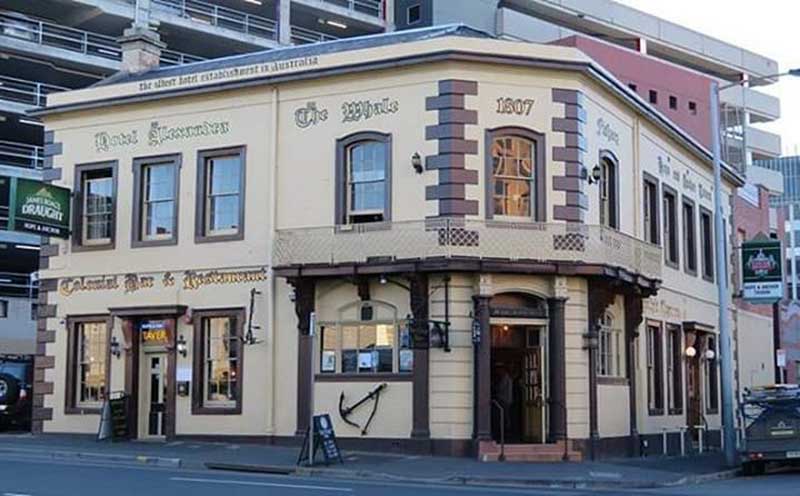
Claiming to be the oldest hotel establishment in Australia, this is a two storey brick and stucco colonial corner pub with two storey brick and stucco shop at No 71. The hotel has a hipped iron roof behind a cornice and parapet, quoins expressed, mouldings to openings, and a bracketed cornice to minor doorways. The corner entry is flanked by Doric columns terminating in a bracketed balcony above with fine iron railing. The colonial Georgian shop has an iron gable roof behind a parapet. Over the years the hotel the has been known as th Alexander, the Whale Fishery and the Hope. The Hope and Anchor Tavern was owned for many years by Gunter Jaeger, who also owns Boomer Island.
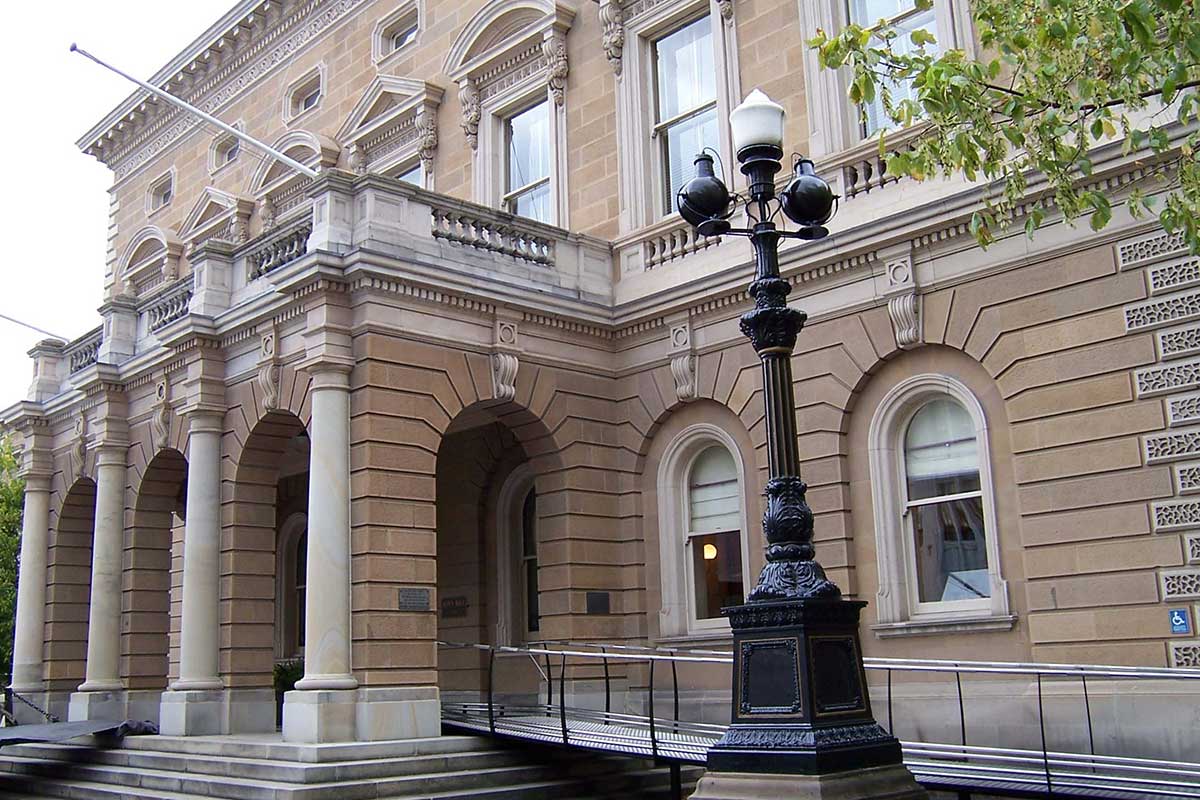
Classical Revival is style a commonly used in Australian town halls, and this is is an excellent example. It features banded rustication to the ground floor, finely detailed pediments and cornices over upper level windows, quoins, cornice with both egg and dart and dentils, bracketed eaves and chimney caps. There is a three-bay entry porch, with Corinthian columns and side porticos. The richly decorated interior features a grand staircase. Architect: Henry Hunter.
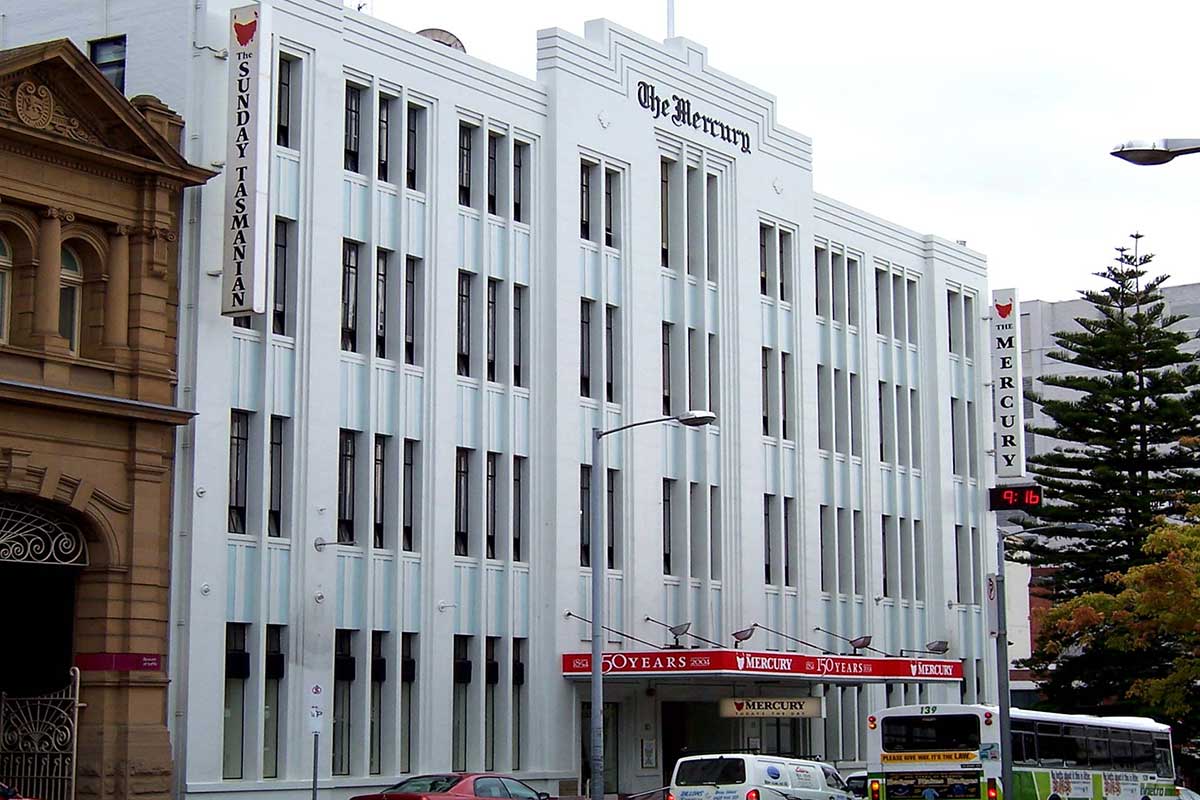
Built in the 1930s, this is a bold four storey structure which gains prominence in the streetscape because of its simple yet imposing design. Its facade features vertical piers between narrow window bays. Designed by Tasmanian architect Archie Johnston. The completion of the building allowed the installation of a Goss rotary press, capable of printing in two colours.
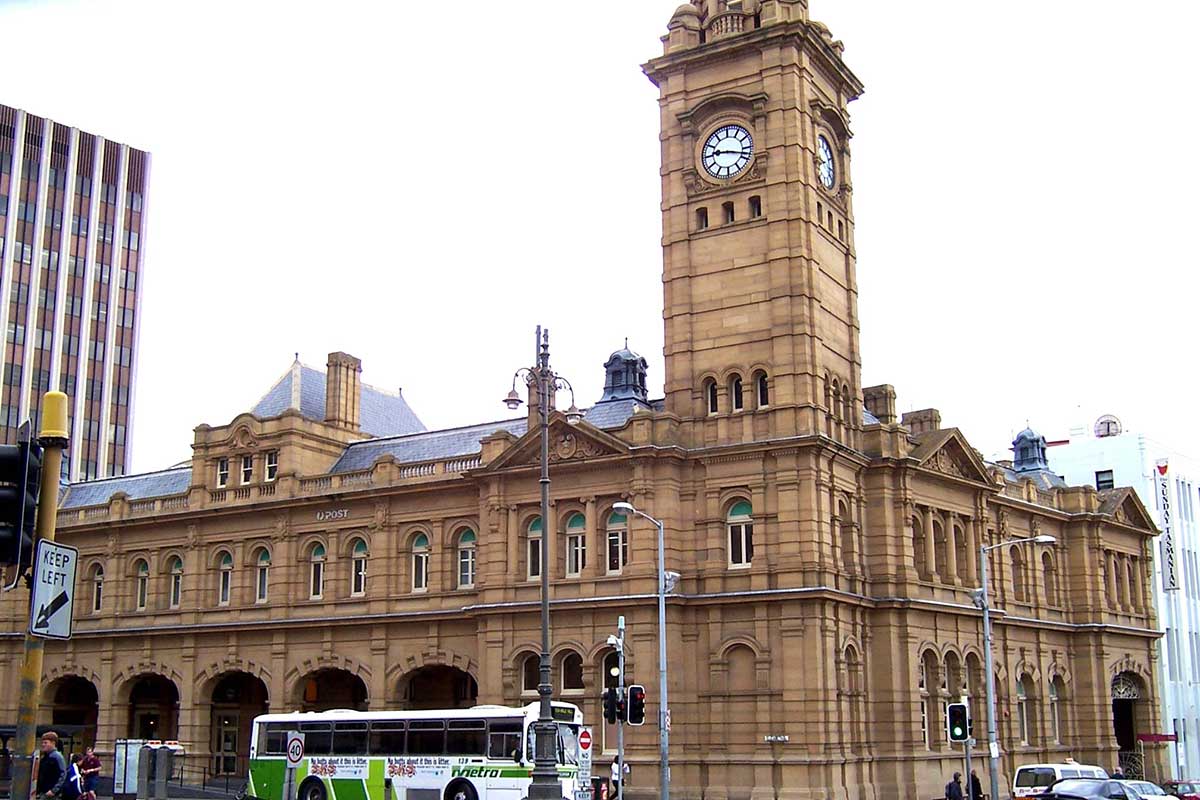
A two storey building, designed by A.C. Walker, with corner tower and five bay arcade entry. There are ashlar facades to Macquarie and Elizabeth Streets, the remainder is brick on stone foundations. The pronounced strings and rustications between the openings give horizontal emphasis. Terminal and corner pedimented pavilions have pilasters defining bays. A rare example of Classical Italian Renaissance in Tasmania.
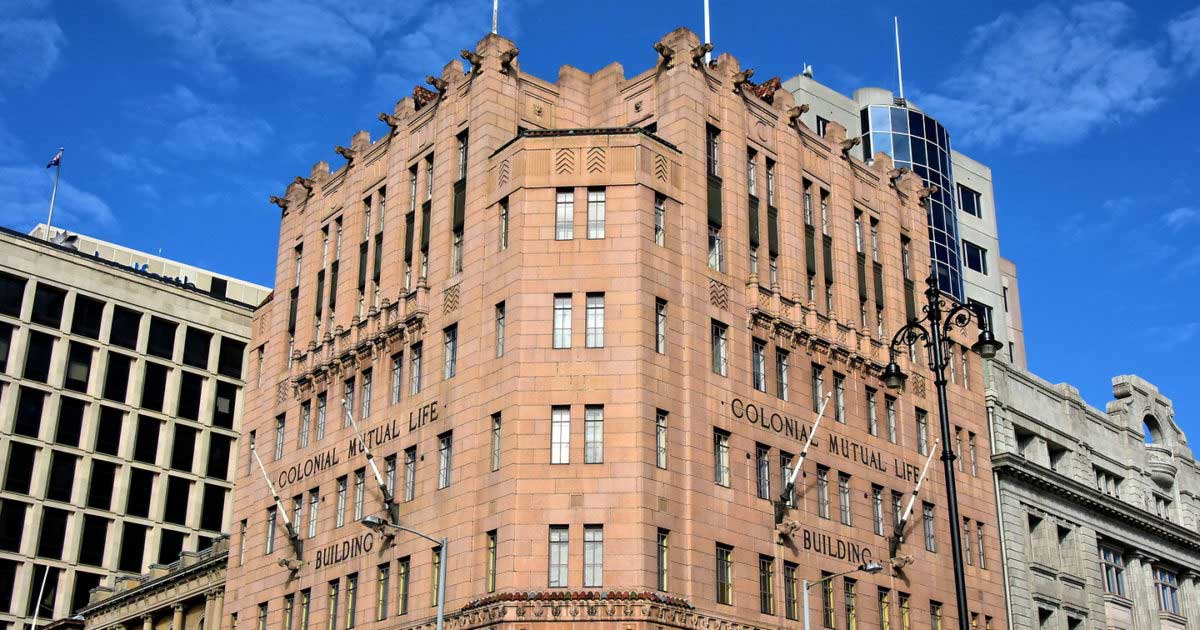
A landmark seven-storey building, similar in design and colour (salmon pink brickwork) to offices built by this insurance company in Perth and Adelaide during the 1930s, all being of the same model. It is a seven storey office block with shops on street level. The structure is of steel frame with reconstituted stone cladding from Queensland. Benedict Stone, was one of the earliest reconstituted stone claddings available. This building example is exceptional in it's ecelecticism, incorporating Art Deco elements which was fairly usual in Stripped Classical buildings in combination with English Picturesque elements evident in the terracotta roof tiling. This is one of the few that escaped the demolition hammers in the 1970s and 1980s when many buildings of this size and vintage were replaced by larger buildings. The design has numerous gothic details such as gargoyles. Architects: Hennessey & Hennessey.
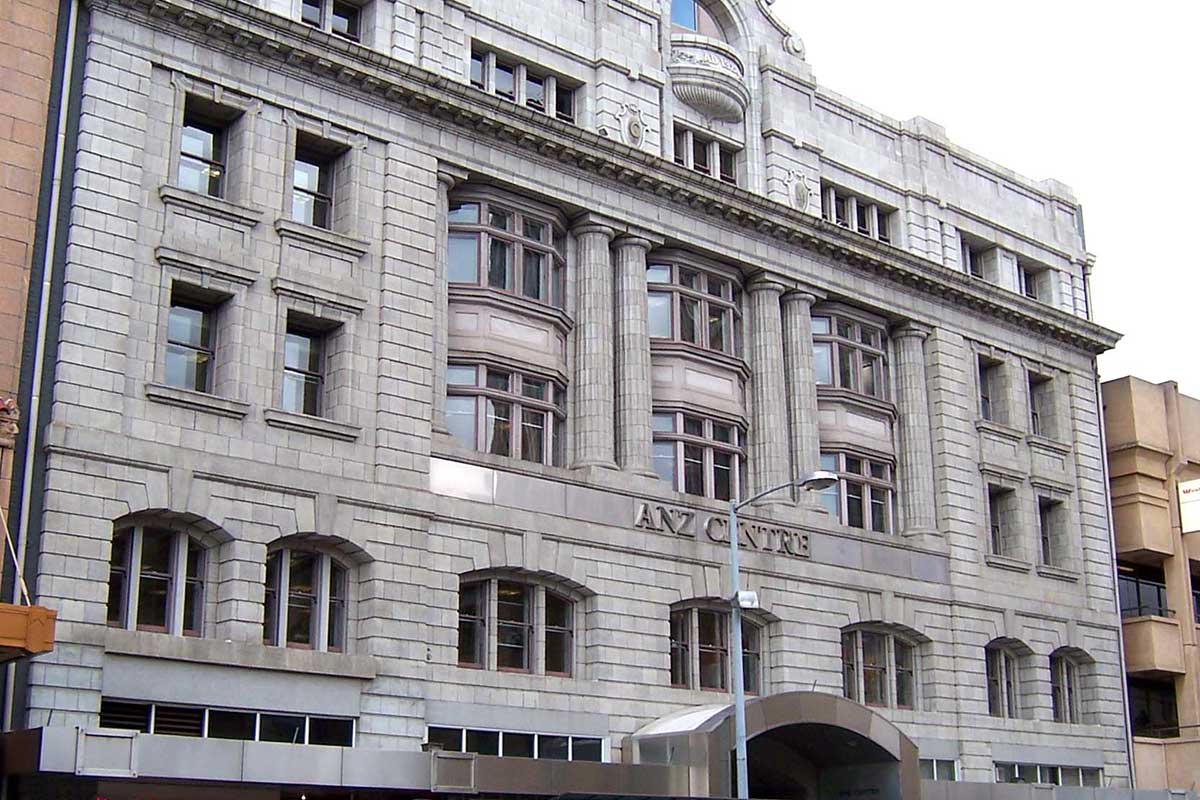
The facade of a fine example of Inter-War Beaux-Arts style architecture is situated opposite the General Post Office. The building it belonged to was constructed in 1926 as the Bursary Board Building. The revenue earned from renting out the shops and offices was used by the Bursary Board to assist deserving children from the country to secure the advantages of a secondary education. The building’s completion was celebrated as 'an outward and visible sign that Hobart is not in a state of stagnation as seems to be imagined by some people in other parts of the State and on the Mainland.'
The present day twelve storey building behind the facade presented many engineering challenges. It occupied an irregularly shaped block of land and including recycling of a 1920s concrete office building on one street frontage and a nineteenth centre stone building on another. Structural features include large span cantilever frames overhanging the old buildings and extensive use of precast concrete in the facade and core.
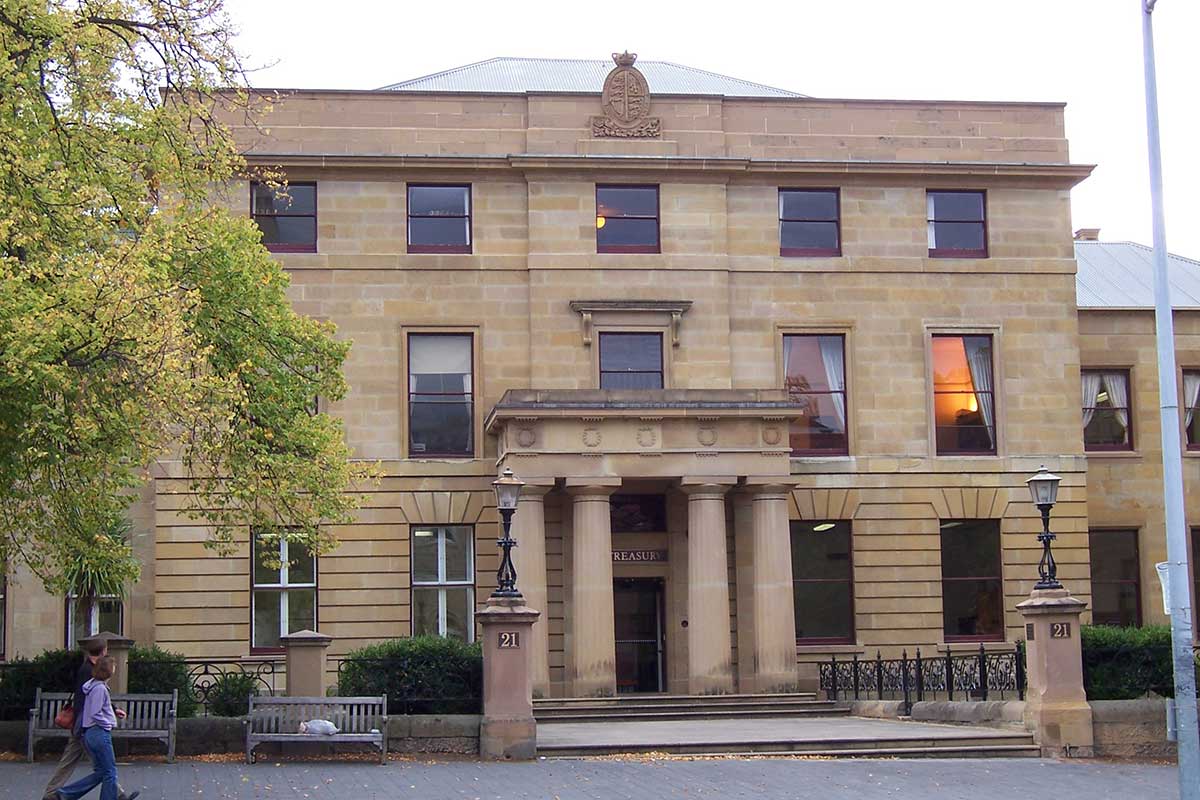
The government administration of Tasmania has been centred upon this complex of buildings since colonial times. The first building, the Court House, was built in 1824 and rebuilt in 1860-62 as the post office. John Lee Archer designed the Post Office/Treasury (1836) (above) and the Murray Street public offices (1841). Convict architect James Blackburn added the massive Doric portico. Other wings such as the Executive Council Offices were completed in 1860, 1887 and 1914. The Supreme Court was designed by W.P. Kay and built in 1860-1910. It is constructed of fine sandstone with rustication at the ground level and smooth ashlar above.
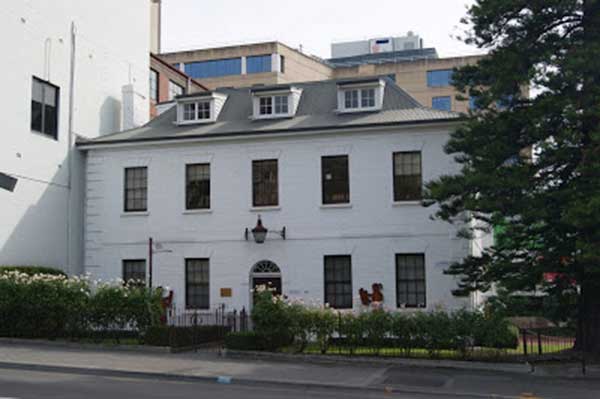
Ingle Hall is a Georgian townhouse built in 1814 by John Ingle, a free settler who had quickly become a leading merchant. Gov. Macquarie was irritated by Ingle’s success, an opinion shared by many of Ingle's contemporaries. Much to their delight, Ingle left Hobart in January 1818, never to return, though he retained ownership of his vast property portfolio in the colony. 1892 saw Ingle Hall turned into firstly the Orient Coffee Palace. Under successive proprietors it was renamed Tasmanian Coffee Palace (1898), Anderson’s Coffee Palace (1902), Norman’s Coffee Palace (1910).
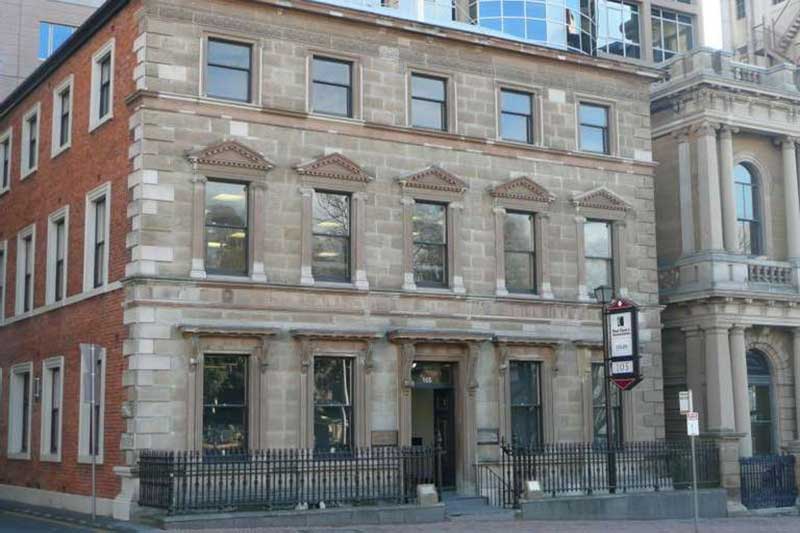
A three storey Victorian era Academic Classical commercial building, designed by J.A. Thomson with a front facade in ashlar, the rest in brick and a hipped iron roof. There are expressed quoins, bracketed cornices to ground floor openings, Ionic pilasters and pediments to second level windows, string courses, a decorative frieze and a cornice to the roof.
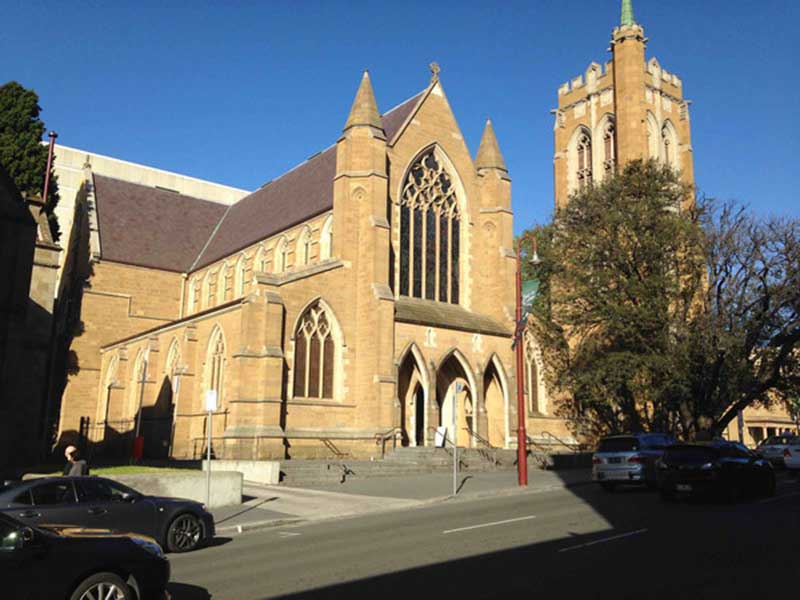
A stone Norman Gothic Revival cathedral built over a period of 68 years to the original design of English architect G.F. Bradley. The foundation stone of this Anglican church was laid by HRH, Prince Alfred, Duke of Edinburgh, in 1868. The arcaded entry features a large west window with fine tracery in the gabled-end balanced by buttressed towers. Other features include a simple square tower, erected in 1936, in Oatlands sandstone, with a castellated parapet and quatrefoil tracery to the openings. The tower has a peal of eight bells. The cloisters were added in 1929. It is the second church on this site.
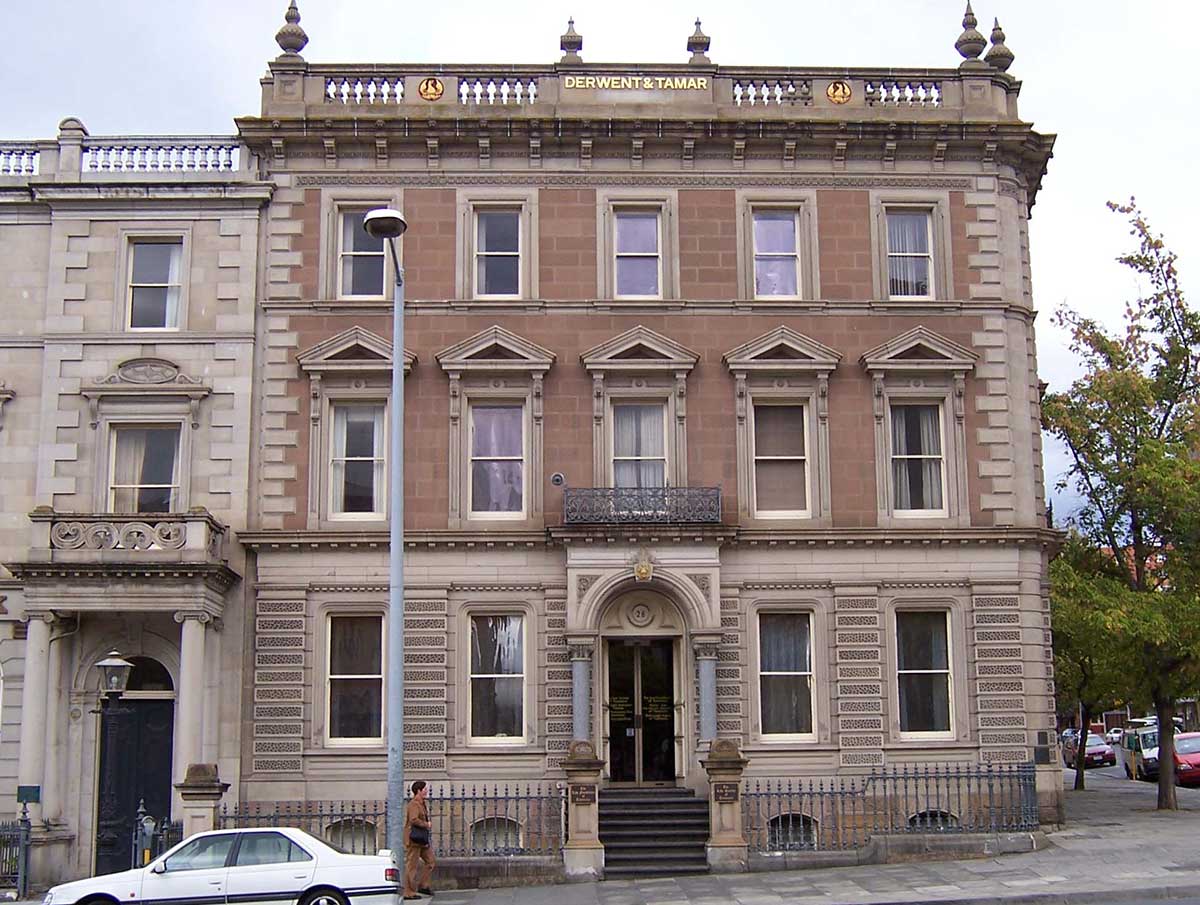
This three storey building, the former Savings Bank of Tasmania head office, was designed by Henry Hunter. It features a full basement, light well and iron railing to Murray Street. It is constructed of two different sandstones, with vermiculated pilasters and surrounds to ground level and pink stone to upper levels. The fine stone detailing includes rounded corner window reveals, bracketed pediments, bracketed cornice, balustraded parapet, parapet urns and quoins. The entrance portico features polished granite columns and an iron balcony to the second level. The building, with its richly detailed facades, is part of a particularly attractive and uniform streetscape on Murray Street.
The bank building occupies the site of Hobart's Town Gaol. This small, two-story building was built in 1816; its bricks were of a very poor quality, and the soft damp ground of the locality always meant its life would be limited. The gaol became so crowded, it had to be replaced in 1826 by the Campbell Street Prison, where William stayed. The Murray Street gaol was used for executions from 1825 until 1857, when it was finally demolished. “Gentleman” bushranger Matthew Brady and the notorious cannibal convict Alexander Pearce were among hundereds whose lives came to an end on its gallows. As the stonemasons filed past in 1846, they might well have seen the dead bodies of executed prisoners strapped to the stocks on Murray Street, left there so the townsfolk could throw rotten fruit at them, or be reminded of the fate that awaited them should they be contemplating breaking the law. Aptly, the current building on the Gaol site is occupied by some of Hobart's top barristers.
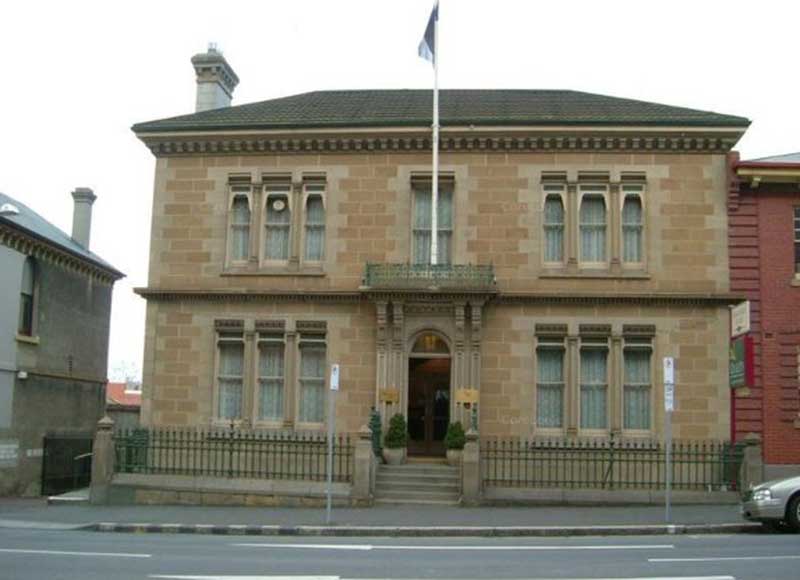
A two storey Regency style town house constructed of pecked ashlar with smooth stone quoins. Windows are in groups of three with carved mullions representing columns, there is decorative stonework carving at the head of the decorative iron infill canopies.
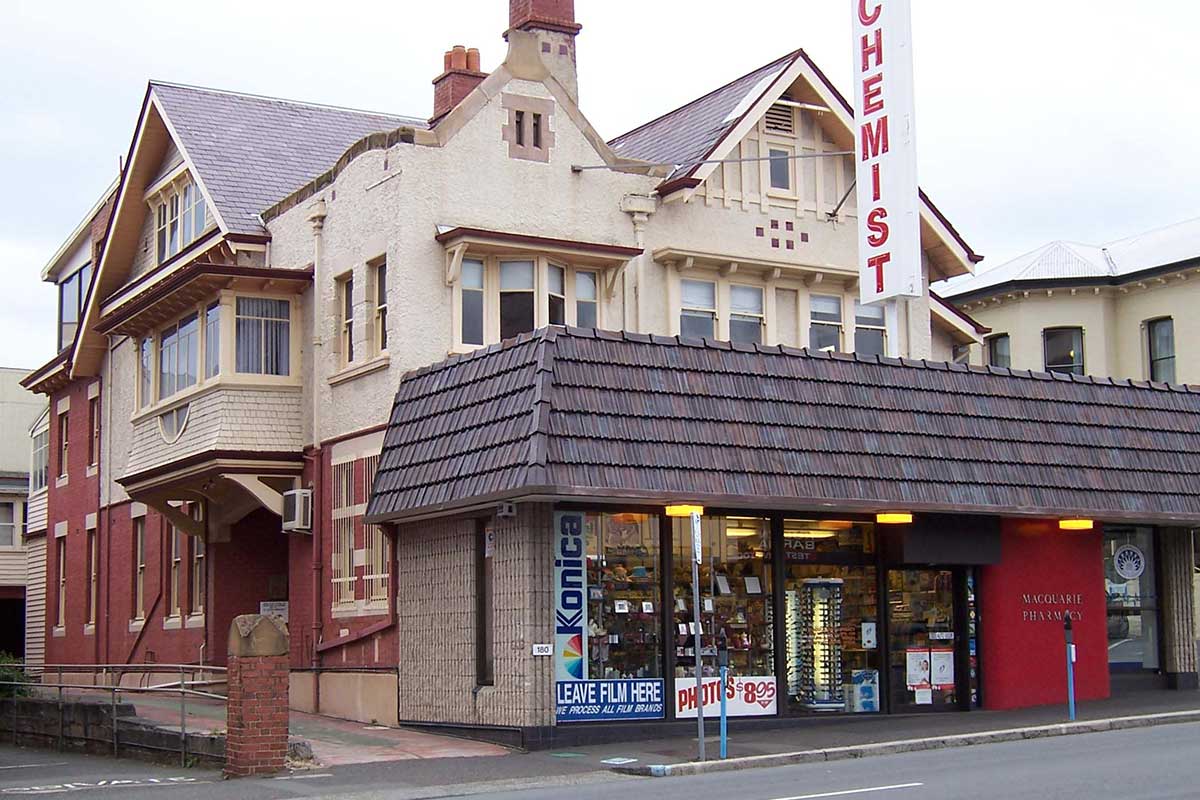
A significant demonstration of the Federation Arts and Crafts style displaying a strong influence of Lutyens. The building features brick, stucco sections and sandstone details. The interior features well detailed, fine Arts and Crafts timber work, the stairwell features timber wall panelling and geometric Arts and Crafts decorated newel posts and railings, the principal room, at the front of the building features timber panelling to picture rail height, a timber mantelpiece and brackets, mirror designed for the room with decorative timber frame, glazed and timber fixed cabinets in the corner of the room. The unsympathetically designed shop was added to the street front in the 1970s.
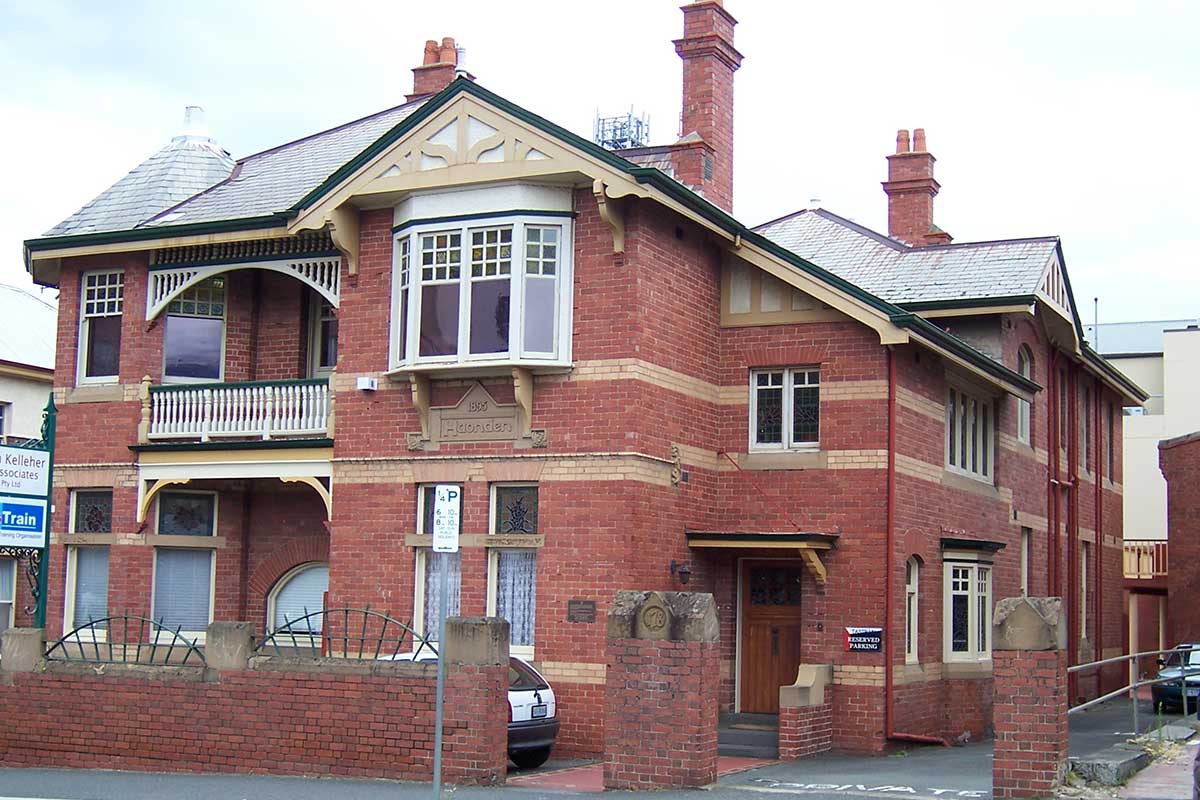
A large guesthouse, which served as the RAAF Recruitment Centre No. 6 Personnel Depot between 1935 and 1945.
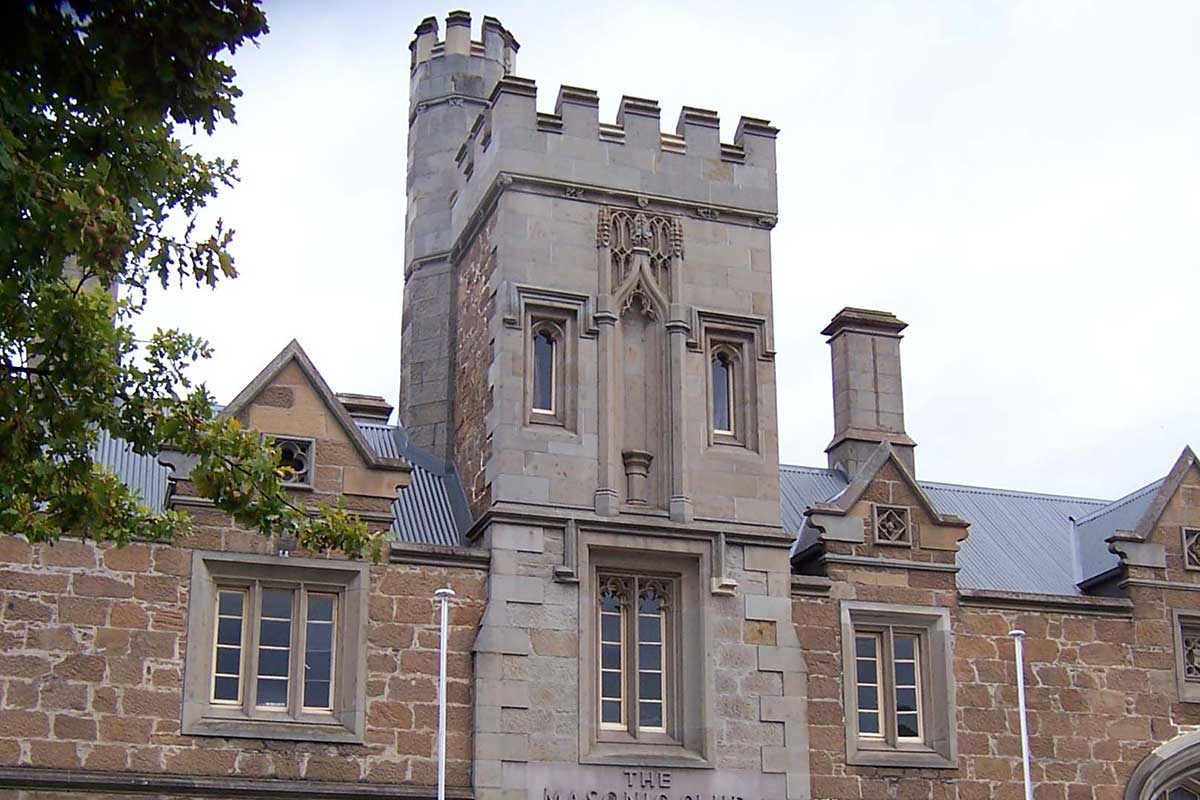
Erected as a school building, it is constructed of bluestone with sandstone trimmings. The central square tower has a castelated parapet and a turret to the north-west corner. The unusual facade composition includes a major window with tracery at ground level and unequal gable-ends at roof level. Its Tupor Gothic style was possibly inspired by the Colleges of Oxford & Cambridge. The so called Christian Style of architecture has in this case resulted in a pleasing building with a facade of delicate complexities. A picturesque building whose impact is heightened by the foreboding tower. Designed by John Lee Archer, built by Cleghorn & Anderson. .
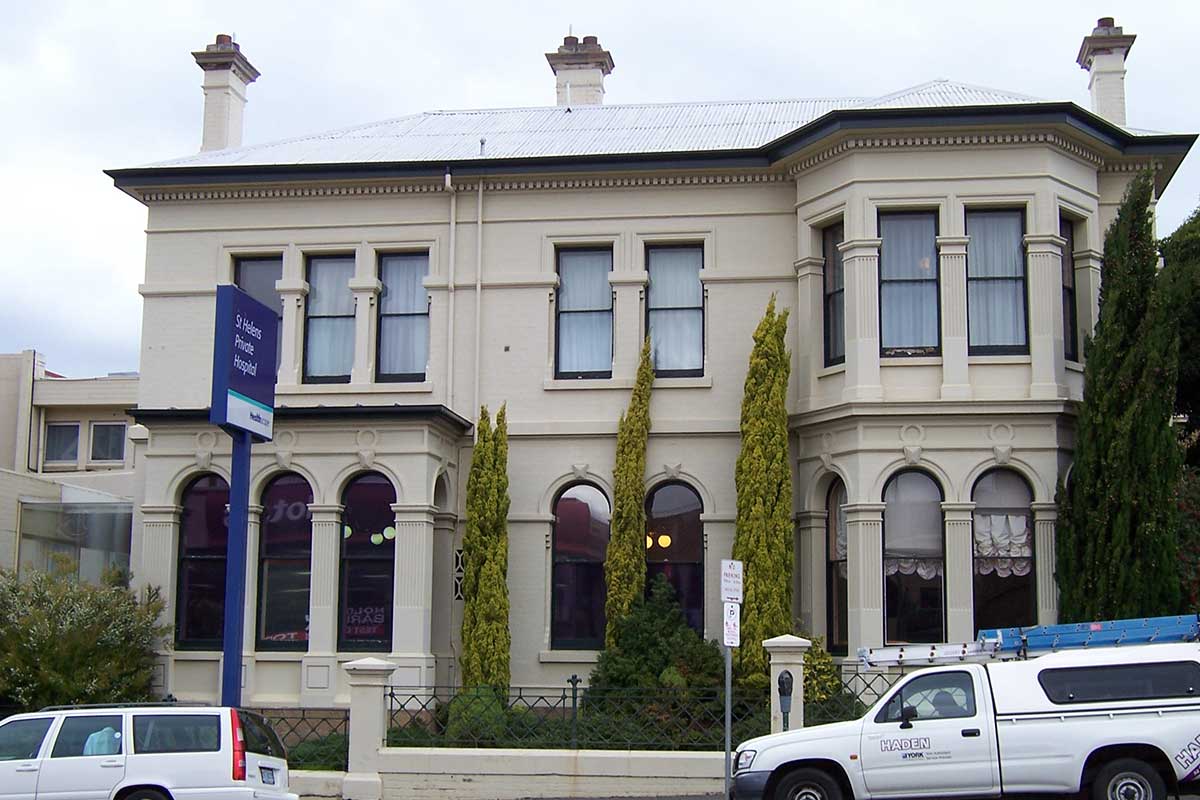
Between 1839 and 1878, this site was occupied by the Royal Oak public house. The property was subsequently acquired by Dr Edward Owen Giblin, a medical surgeon, and he constructed a large stone and brick mansion in 1887-88. It was designed by Henry Hunter and built by W H Cheverton. The St Helen’s Private Hospital began operating from the premises in 1919.
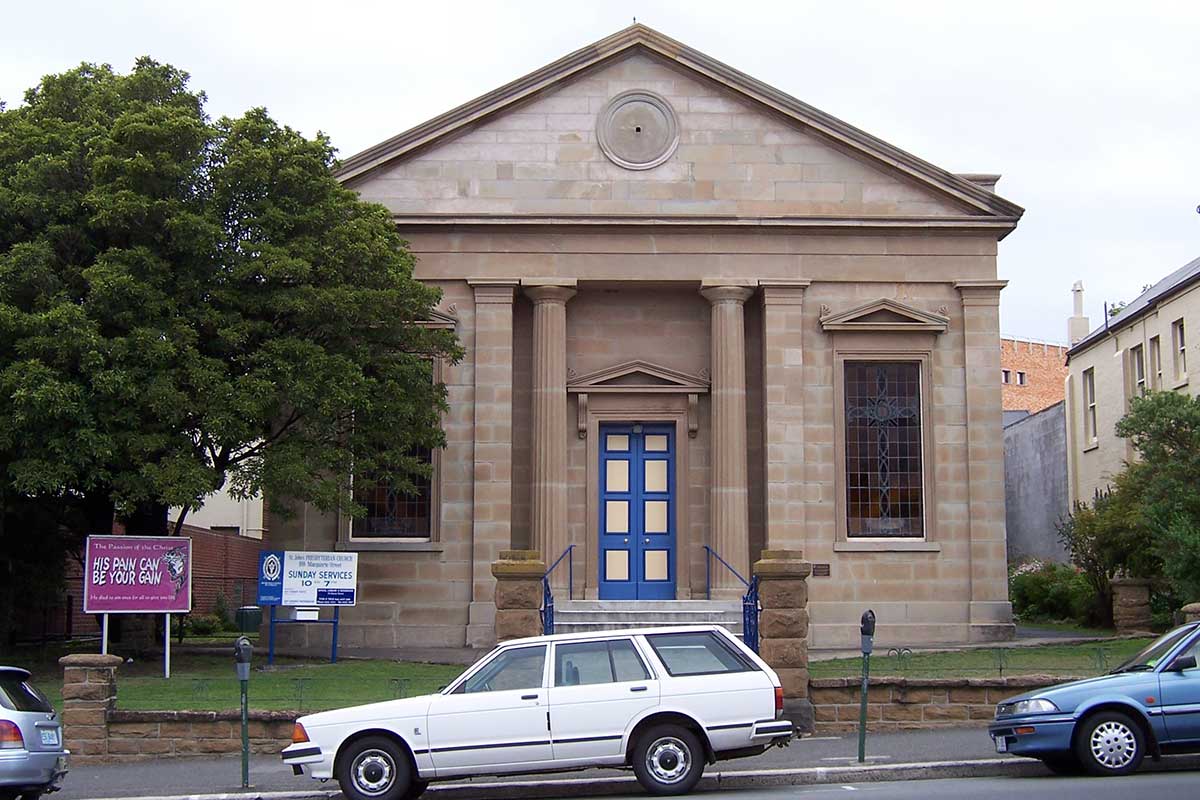
Set behind a rock-faced stone wall and pillars with spherical lamps on iron standards, this Regency Greek Revival stone church features two engaged Doric columns and an eight panel front door with bracketed pediment. Above is an entablature, triangular pediment and protruding coping. A controlled but striking imitation of a Greek temple, though the proportions of the Doric columns are wrong.
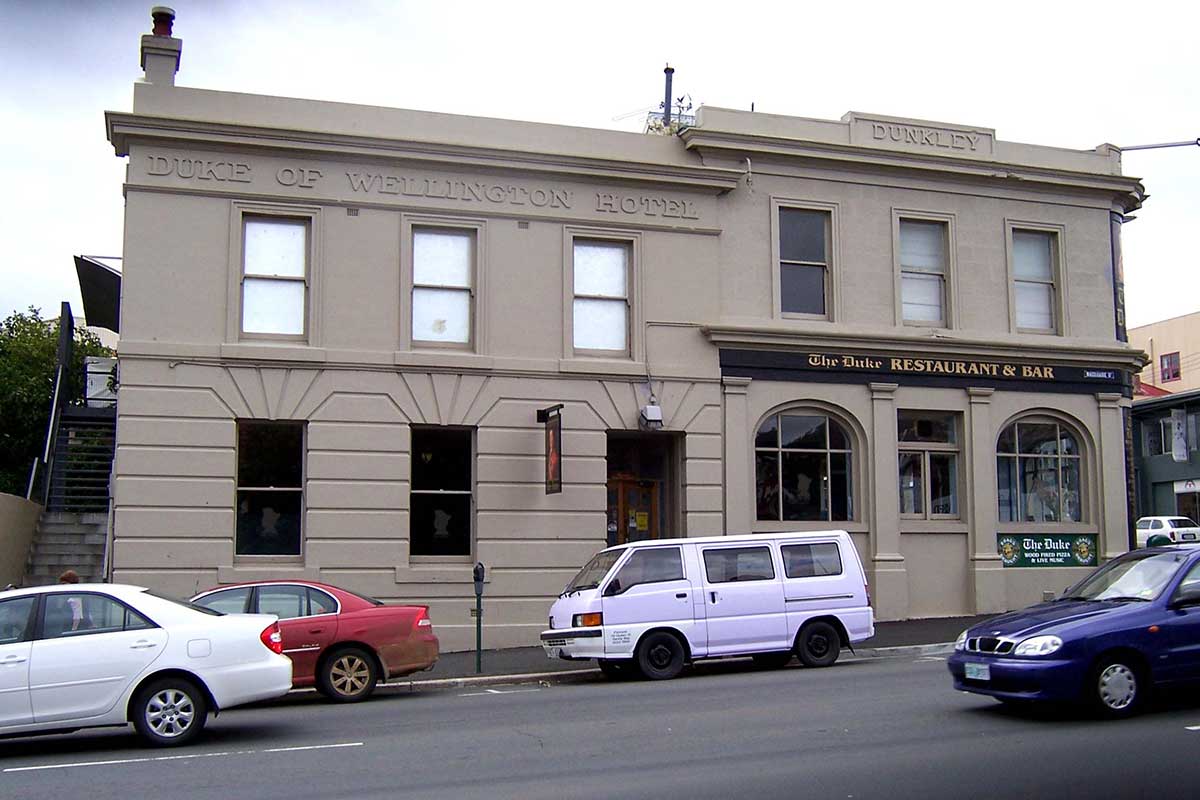
One of the surviving hotels from the colonial era, the hotel was built for the Dunlop family in 1846 and has been a licensed vanue ever since. It was later owned by David Dunkley and his name appears on the building’s parapet. Naming the hotel after Britain’s greatest military commander was probably designed to encourage patronage from the nearby barracks. Many of Hobart’s old public-houses were re-modelled during the Inter-War period but the Duke of Wellington has survived with its original handsome appearance unblemished.
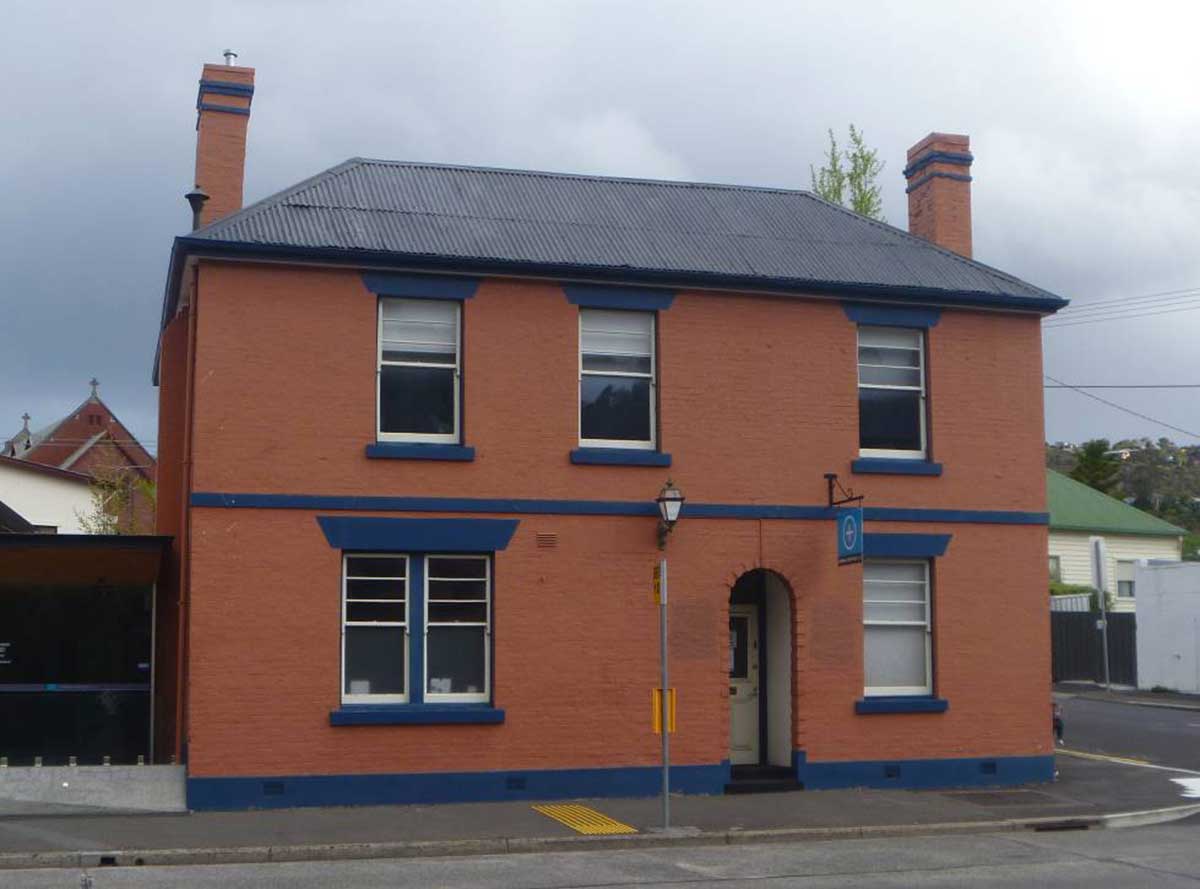
This building was constructed in the 1850s and was licensed as the Mountain Retreat in 1861. The operation of public-houses was heavily regulated in colonial times and in 1866 the Mountain Retreat’s landlord was charged with permitting music and dancing in his house. The Police reported that between 15 and 20 disorderly characters had remained on the premises after 11 o’clock on a Saturday night, creating a nuisance to the neighbourhood. The landlord was fined ₤2 and if he failed to pay he was to be imprisoned with hard labour until he did.
The Mountain Retreat closed its doors for the last time in 1917. The building subsequently became a shop, before being converted into two flats, and then became a medical centre.
Named after George James Molle (1773-1823) who, in 1815, was Lieutenant-Governor of New South Wales. While in India Molle had met and become friendly with Governor Lachlan Macquarie, who gave a dinner in his honour the month after he arrived; but the governor did not allow Molle the authority he considered was his due, and in his public activities he became an opponent of Macquarie.
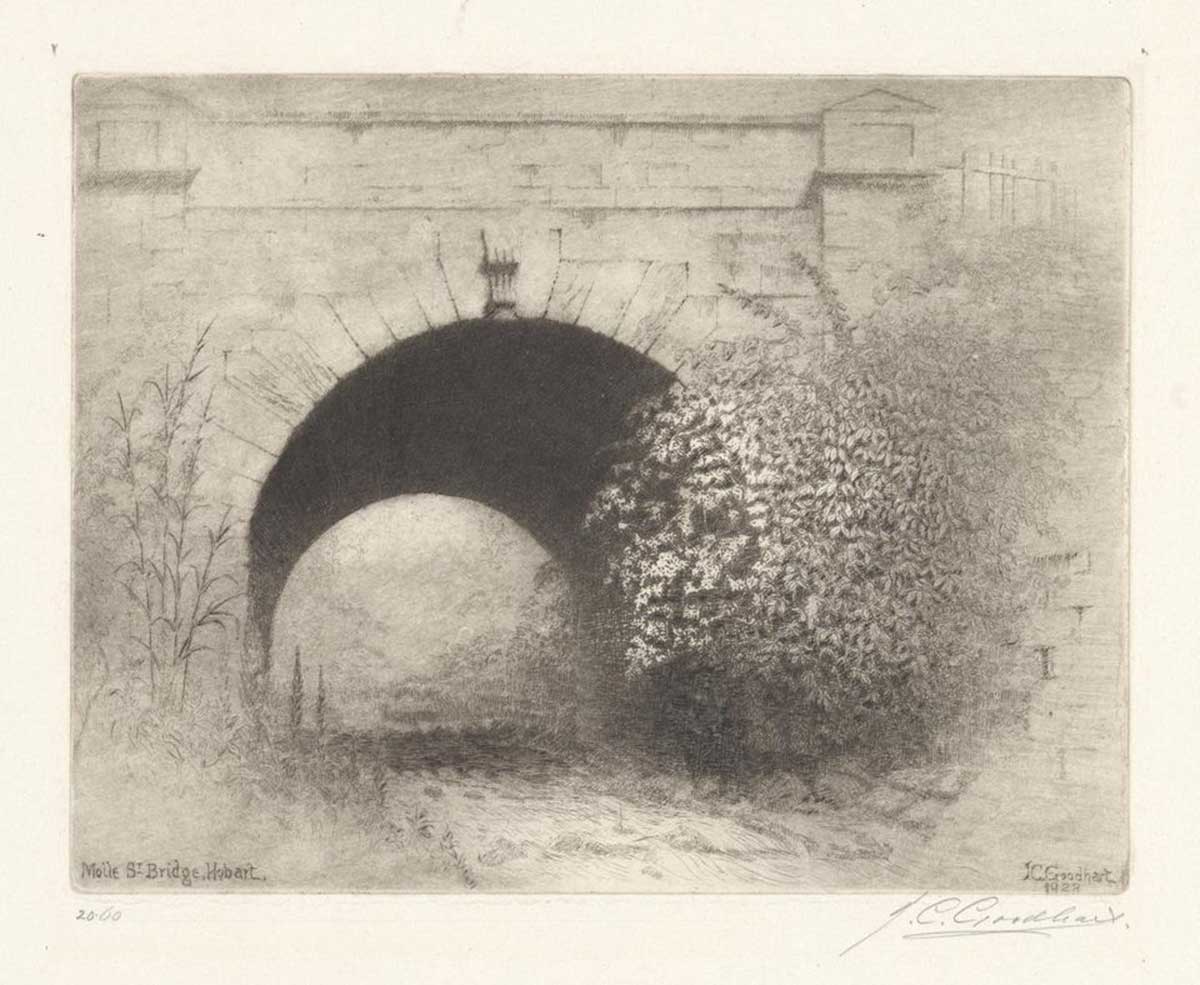
The thousands of people who use the Molle Street bridge to pass over the Hobart Rivulet each day may occasionally notice the fine stonework on either side of the roadway, but few would realise how handsome the structure is when viewed from creek level. The Molle Street bridge was constructed by Robert Barter Wiggins in 1866. The stone for the bridge was sourced from a quarry on Forest Road, West Hobart. Some people claimed that Wiggins’ workmanship was unsatisfactory but the structure has staunchly withstood the test of time, including some significant floods.
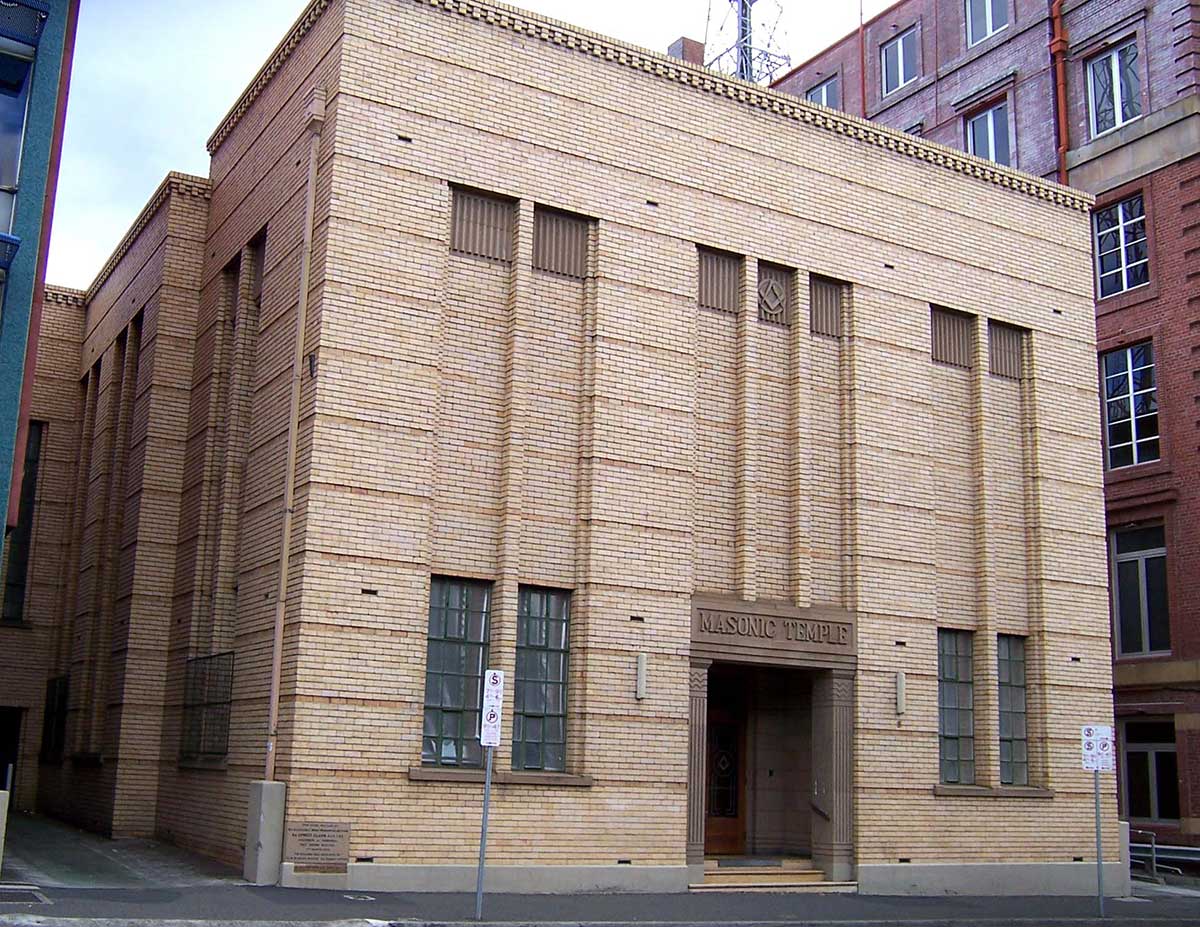
Distinctive three-storey Stripped Classical design with Art Deco details, built totally of brick, with the few windows on the street front being of opaque glass. The building consists of five bays that are symmetrically and vertically proportioned with a minimum of detail or adornment. It is viewed as the finest work of its architect, A. Laurston Crisp. The building was dedicated on 15th January 1939.
Recalls Sir Thomas MacDougall Brisbane (1773-1860), Governor of New South Wales, 1821-25. Named by surveyor George Frankland.
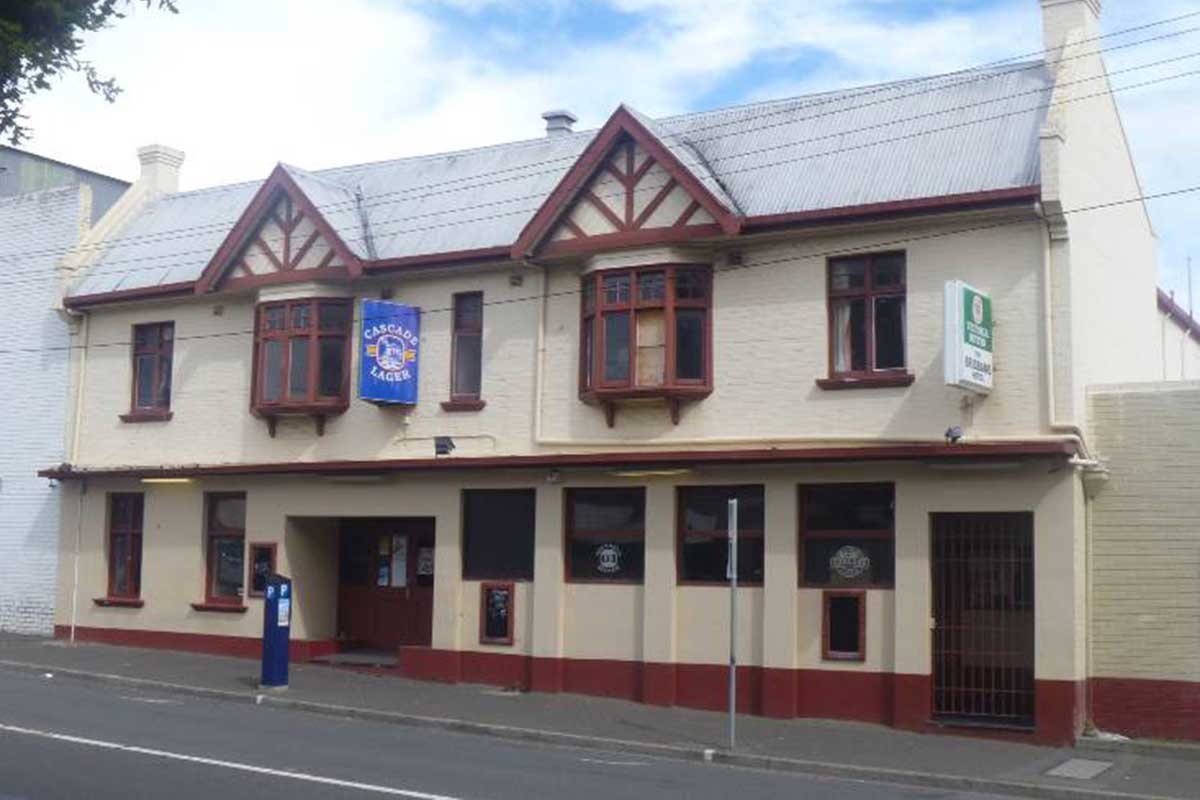
A public house, known as the Old Commodore, was established on this site in 1833. It was outside this hotel that Martin Cash, the notorious bushranger, was apprehended in 1843. Cash had been spotted on the other side of town, in the upper part of Murray Street, and had sprinted off, pursued by a noisy crowd. Peter Winstanley, an off-duty policeman, had been enjoying a quiet drink at the Old Commodore when the approaching ruckus was heard. Winstanley went outside and tried to stop Cash as he came down Brisbane Street. Tragically, Cash was armed with pistols and he shot and fatally injured Winstanley after he had attempted to grab him. However, this gave the mob enough time to catch up and Cash was subdued and captured in the ensuing melee. Cash was sentenced to death for the murder but this was subsequently commutted to imprisonment on Norfolk Island.
The public house was thoroughly renovated by new owners in 1922 and its name was changed to the Brisbane Hotel. Adverts stated that it would be run along Continental lines with its dining room under the supervision of Mons Vivier, a leading French chef.
There are more streets, towns and geographical features in Australia named after Gov. Lachlan Macquarie and his wife, Elizabeth Henrietta Macquarie, than any other person. Macquarie had a habit of naming things after the pair wherever he went, and Tasmania is no exception. Campbell Street recalls his wife's maiden name.
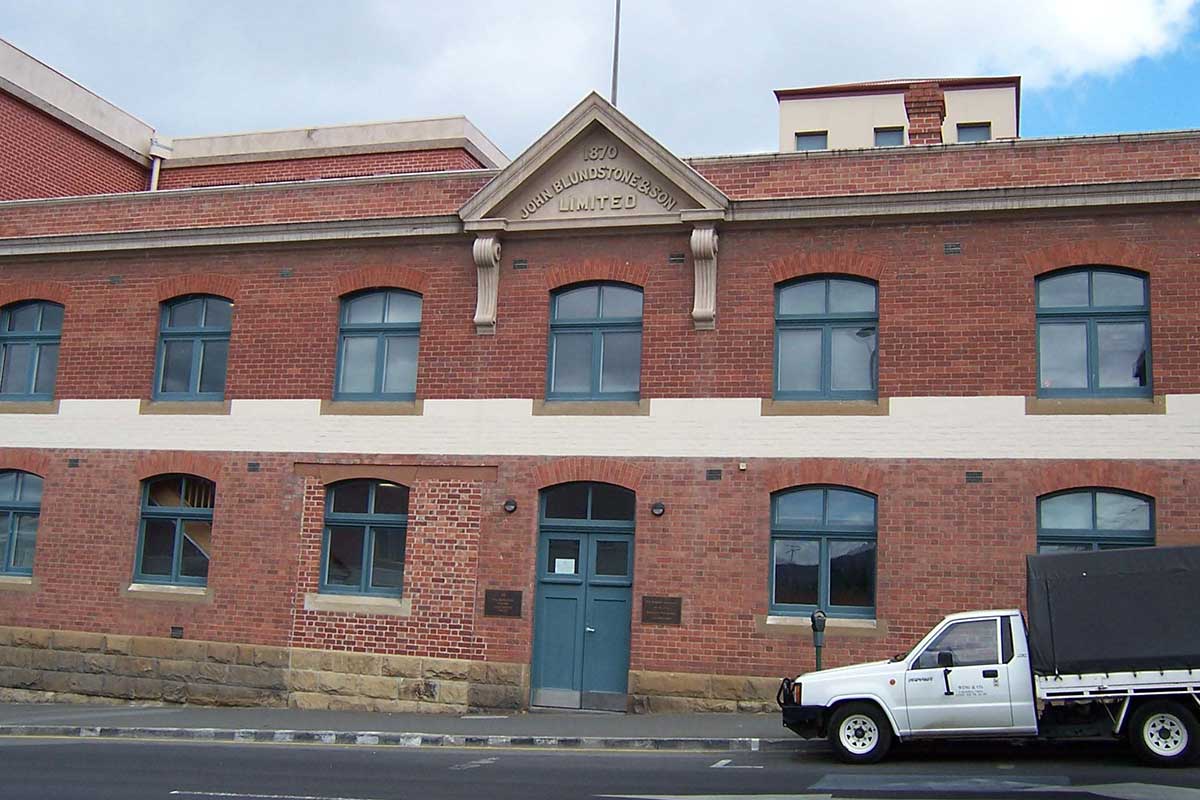
This two storey Federation warehouse was built for shoe and boot maker John Blunderstone. Its products became very fashionable in the boutiques of Europe after World War II. The business relocated in 1980 when the building was taken over by the Children's Court.
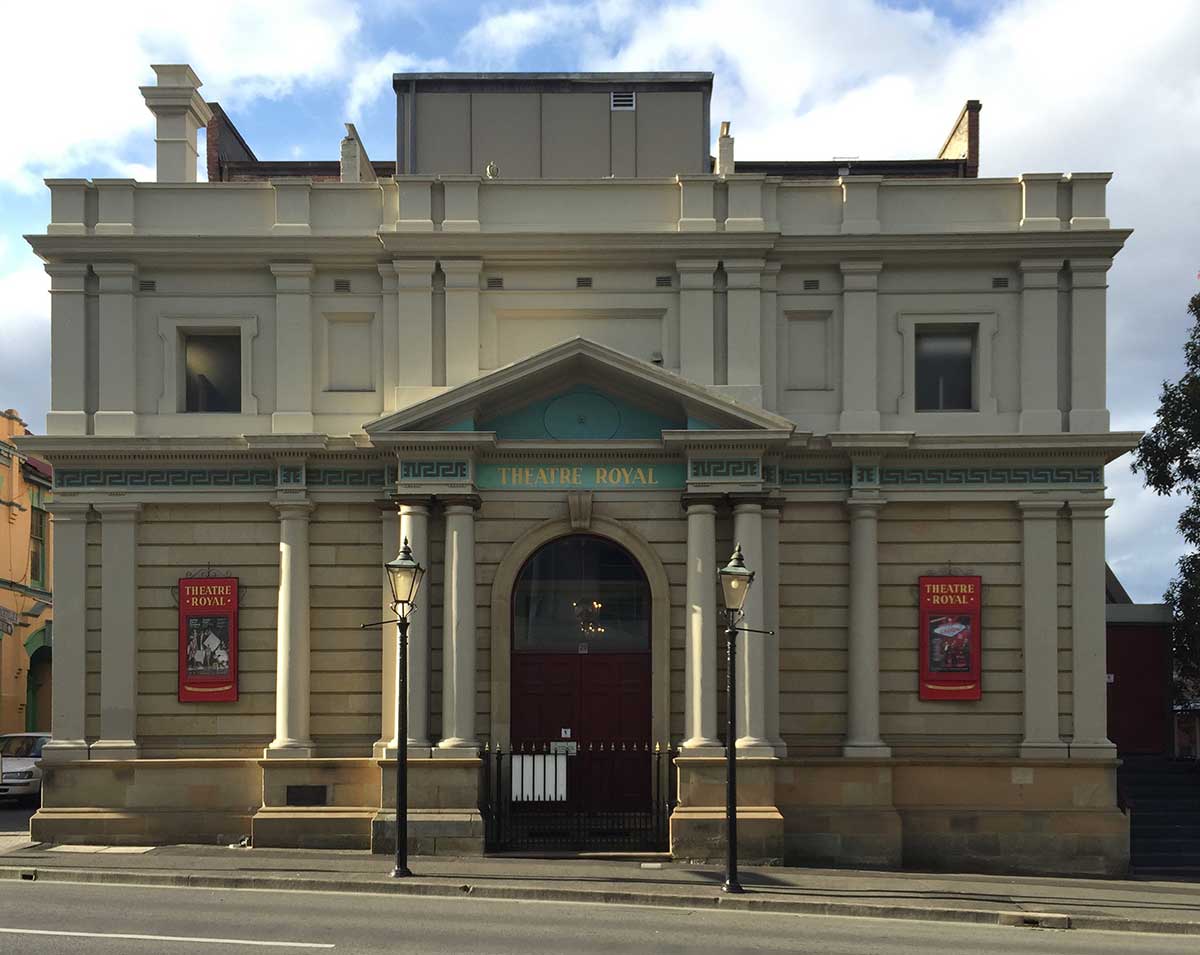
A rare example of an early colonial theatre still continuing its original function. The Theatre Royal is the oldest remaining theatre in Australia and still retains its spectacular interior. It provides a strong streetscape element and has some relationship with the adjacent hotel. Dame Sybil Thorndyke rated it as the finest theatre she had played outside London. The facade is of major external interest and comprises banded rustication to level one and brick and stucco to level two. The central entrance portico features Tuscan columns supporting pediment, double pilasters at corners. frieze and stringcourse. At level two short pilasters support cornice with parapet over. The interior is spectacular. The theatre was designed by Peter Degraves, founder of Cascade, Australia's oldest brewery, and has walls of convict-carved stone. The building design was approved by John Lee Archer, Colonial Engineer. Built among the public houses, brothels, factories and tiny workers' cottages of Wapping, the theatre opened in 1837.
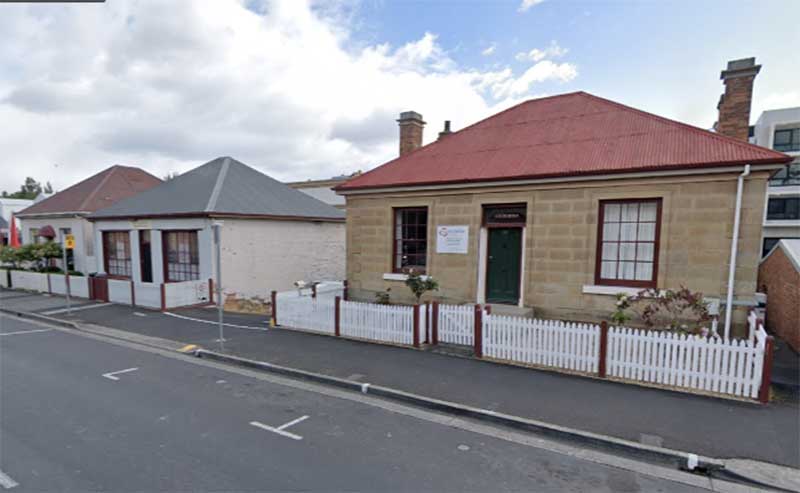
This small group of cottages displays many of the qualities of early simple Georgian domestic architecture in Tasmania. The freestanding stone cottage (No. 95) with central doorway and flanking 12 pane windows. The conjoined brick cottages (No. 97-99), with the same arrangement of fenestration, are the essential features of early Tasmanian architecture. The buildings are intact and complement the nearby old Criminal Court and Scots Church.
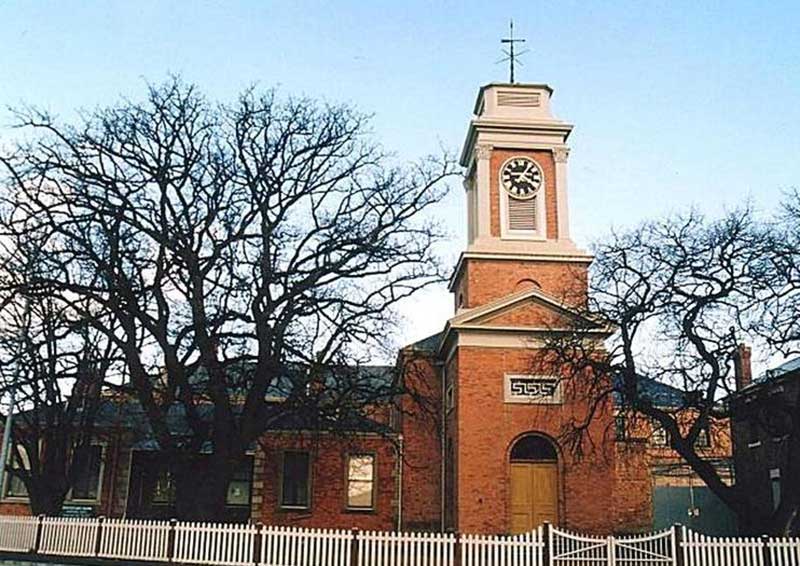
Penitentiary Chapel
The complex consists of the old Trinity Church or Penitentiary Chapel, Criminal Courts, Gaol Offices and Sheriffs Office. Designed by John Lee Archer, the buildings are important for being an example of Old Colonial Georgian architecture, as is seen in the symmetry of the main facades, the exposed brick walling and the medium-pitched hipped roof. Additionally, it is one of the few examples of Georgian ecclesiastical architecture in Australia, and it is an exceptional example of this type of colonial building from the convict period. The Irish-born architect was Tasmania's Civil Engineer and Colonial Architect for eleven years.
Development of the site began in 1821. The tower was added to the chapel in 1833-34 and an entrance in the tower was made to allow free people to worship in the chapel (due to overcrowding at St Davids Church); the free worshippers had a separate entrance to the convicts and were screened off from convict view. Solitary confinement cells for offending convicts were built beneath the raked floors of the chapel. The building cost over 2000 pounds, and the clock in the tower was manufactured by Thwaites and Reed of Clerkenwell, London.
Building a church above solitary confinement cells was Colonial Architect John Lee Archer’s innovative solution to the need for both as Hobart’s convict population continued to grow in the 1820's. It has one of the finest Renaissance towers in the Commonwealth, the brick and stonework asre perfectly blended, and is acclaimed for its excellent proportions of the early bricks and the masterly use of freestone. From 1857 part of the Church housed the Tasmanian Supreme Court, while more recently it has been used as a Magistrate’s Court.
In 1857 the Penitentiary became the Hobart Gaol, replacing the original gaol in Murray Street, and in 1859 the chapel became the city's Criminal Court with two courtrooms, although one transept of the church remained in use as a chapel. Various alterations were made to the building at this time, including construction of the two storey office section, and the single storey section on the street corner. An execution scaffold was also installed (the last Tasmanian hanging occurred here in 1946). Most of the cells beneath the chapel were demolished and tunnels were built to convey prisoners to the docks in the courtrooms. The chapel functioned until 1961 (the year the prisoners were transferred to Risdon Prison) and the courts until 1983. In 1961 the Deputy Gaoler's residence was converted to a daytime holding block with wire cells for prisoners awaiting trial; to gain access to the tunnels, the chapel was badly damaged and a wire cage runway installed.
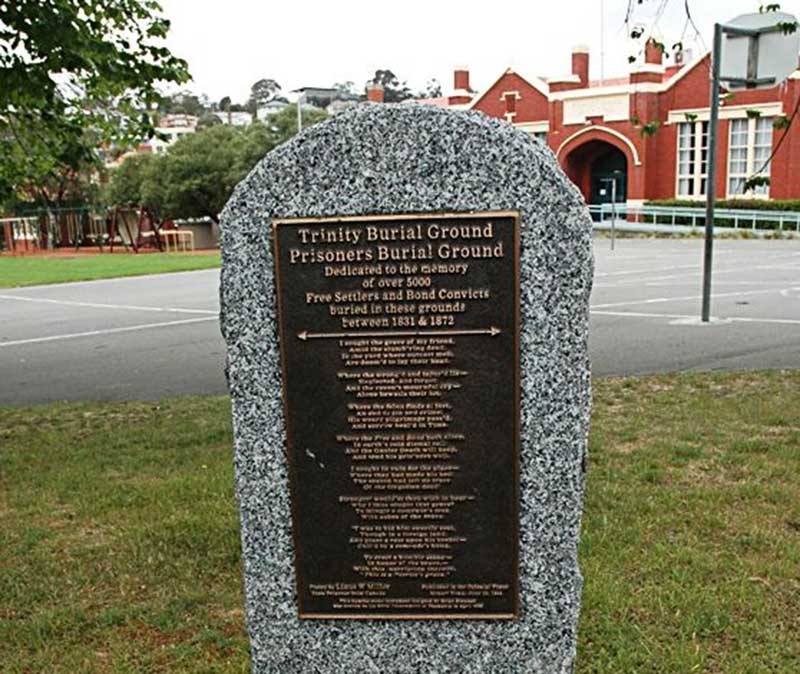
Campbell Street Primary School was built in 1926 on the site of the Holy Trinity Burial Ground. It is believed there are about 5,000 convicts buried beneath the grounds. The burial ground was used between 1831 and 1872 for convicts who died at the Campbell Street Convict Penitentiary, located just a few hundred metres down the road. There were less than 20 bodies exhumed and moved to the Cornelian Bay Cemetery, three years before the school was built.
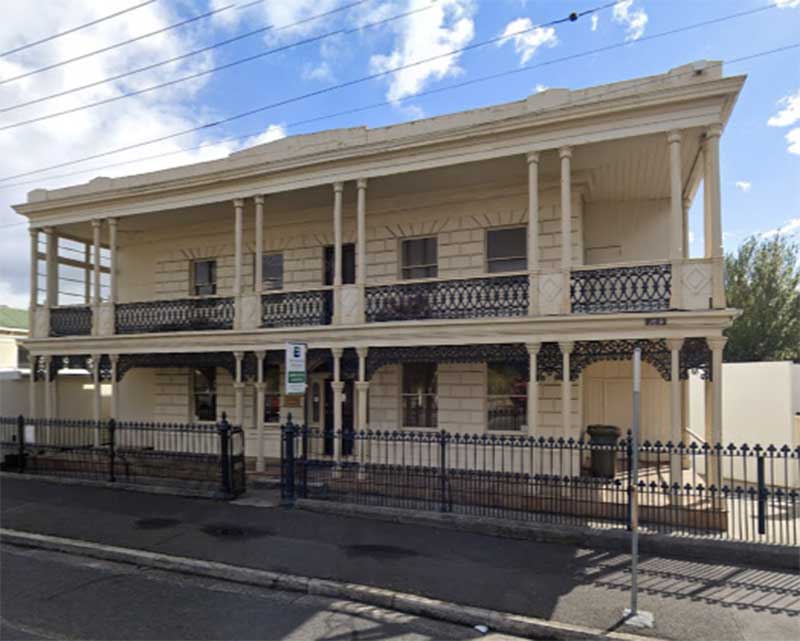
A fine, imposing Victorian townhouse in early original condition, it dominates the streetscape in the immediate vicinity. It is one of very few such houses in Hobart, particularly this close to the city centre. The building features slate hipped roofs behind a parapet. It is stuccoed brick, the front being elaborately margined to simulate stone. It has fine cast iron lacework verandahs at front and sides at both levels, and a cast iron picket fence at street.
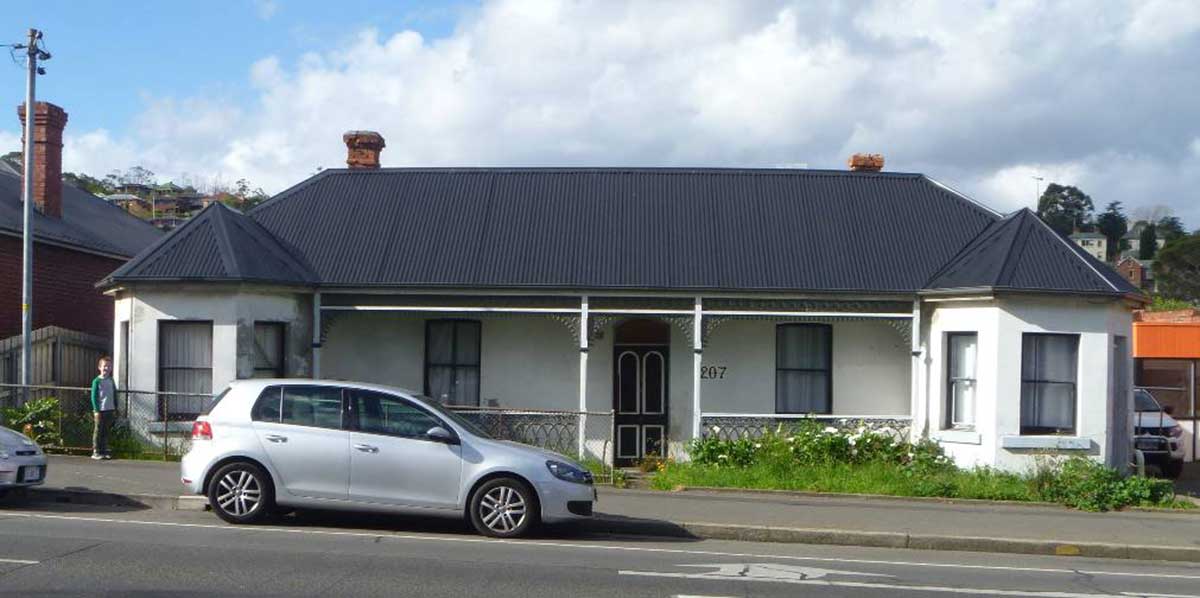
The Tasmanian Inn was first licensed in 1851 but was originally located on the eastern side of Campbell Street, a couple of doors up from Warwick Street. The license for the Inn was transferred to a large ‘brick-built house’ on the corner of Campbell and Warwick Streets in 1872. The operation of public houses was regulated by the Licensing Act and this stated that the only people allowed in on Sundays were lodgers and travellers. In 1920 the Police charged the landlord of the Tasmanian Inn for allowing a milkman to enter the pub on a Sunday morning. It was argued that the case should be dismissed on the grounds that the man entered the premises for a lawful purpose, namely, to deliver milk. While the Magistrate acknowledged that it was a curious case, he could see no difference between the milkman and someone obtaining liquor and he imposed a ₤1 fine on the landlord and fined the milkman 10 shillings.
Brooke Street is ppossibly named after an engineer, Thomas Thorniley Brooke (1837-1871).
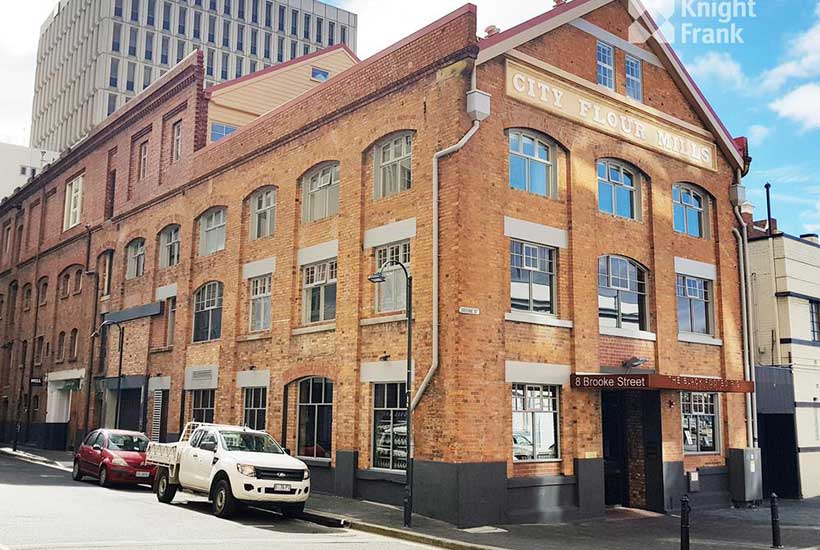
When The City Flour Mill was built, the first in 23 years, the site was chosen with care. It was built on the waterfront to take advantage of the proximity of the wharf for importing and exporting. The central location, also close to the railway station to come later, gave the Mill a competitive edge which led to the Mill becoming the longest lasting of all Hobart’s mills. William Gibson built the mill and continued to run the business until December 1871 when, while supervising the construction of new machinery, his leg was fractured.
The name recalls Capt. John Murray of the 73rd Regiment, Commandant at Hobart Town in 1810 in succession to Edward Lord. The street was named by Gov. Macquarie.
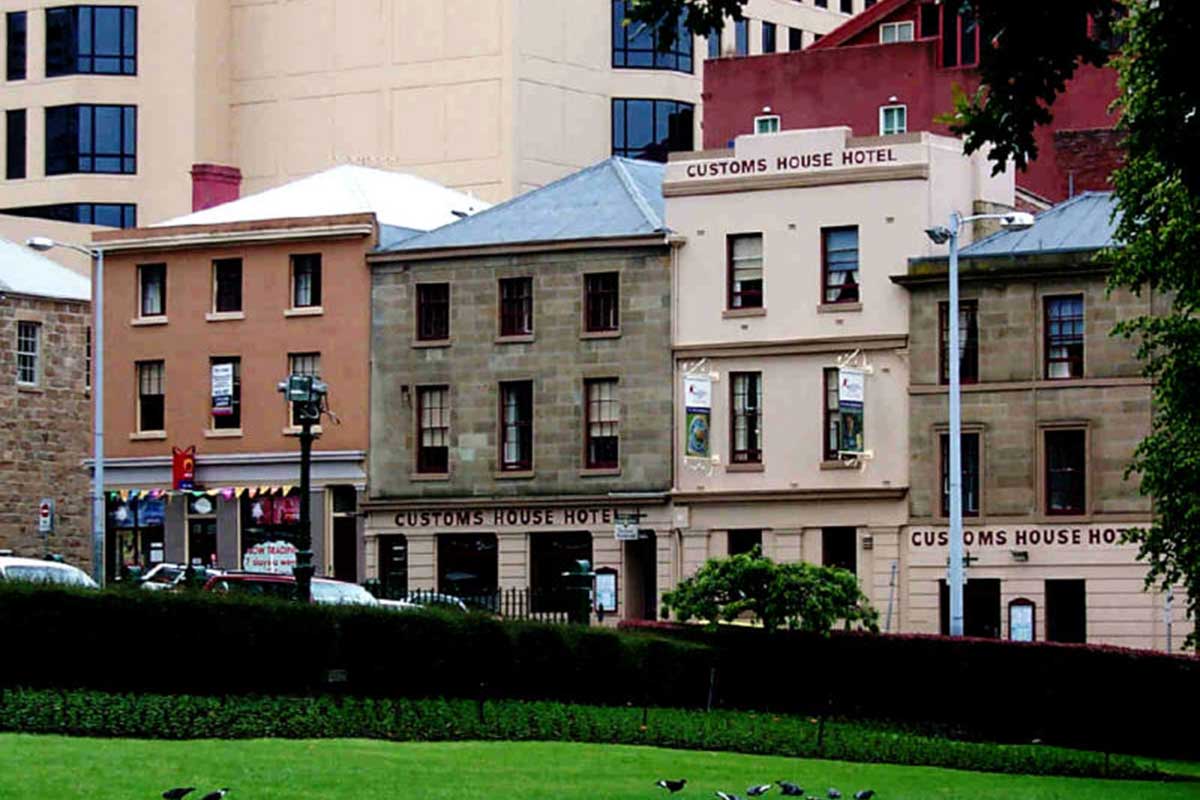
At the lower end of Murray Street towards Morrison Street are three beautiful examples of Colonial Georgian style hotels. The Customs House Hotel, on the corner of Morrison Street, was built for Charles Gaylor (his name is carved in stone above the door) in 1846 as the Customs House Tavern and Chop Shop. The Custom House Hotel was opened in August 1846. At that time, Hobart's Custom House was situated on the opposite side of Murray Street, in the building which now houses the Tasmanian Parliament. The complex is comprised of three co-joined three storey buildings with iron roofs, banded rustication to the first floor and ashlar to the second and third floors. The central building is cement rendered. The ground floor openings and mullions are intact, but glazing bars and fitments have been removed. The central building has a dominating parapet, the corner building has a cornice.
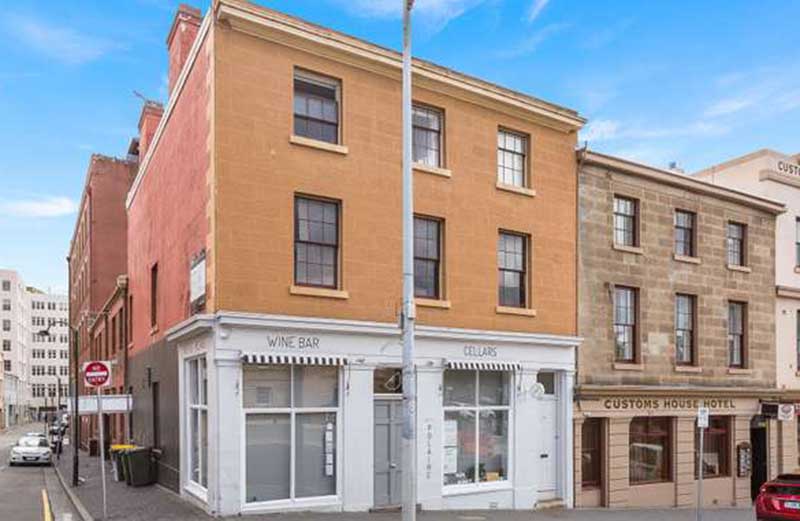
This building was constructed in 1846 and licensed as the Sailors Delight, its name reflecting its proximity to the harbour. In addition to good beds and airy bedrooms there was a large stock of choice wines, spirits, cordials and ales, both in draught and bottle. In 1856 the pub’s name was changed to the New Constitution Hotel, celebrating the passing of the Constitution Act which had established Tasmania as a self-governing colony with its own Parliament. The name of the pub changed again, to the Blue Boar, in 1861 but it closed down the following year.
The premises were subsequently purchased by Frederick Moore who converted them into a tailoring establishment which offered a large assortment of ‘trouserings and suitings’ from the best manufacturers. In the 1920s the building was acquired by Tasmanian Orchardists and Producers Ltd, a growers co-operative who negotiated low-price shipping and export contracts and delivered substantial savings to its members by purchasing orchard sprays and manures in bulk.
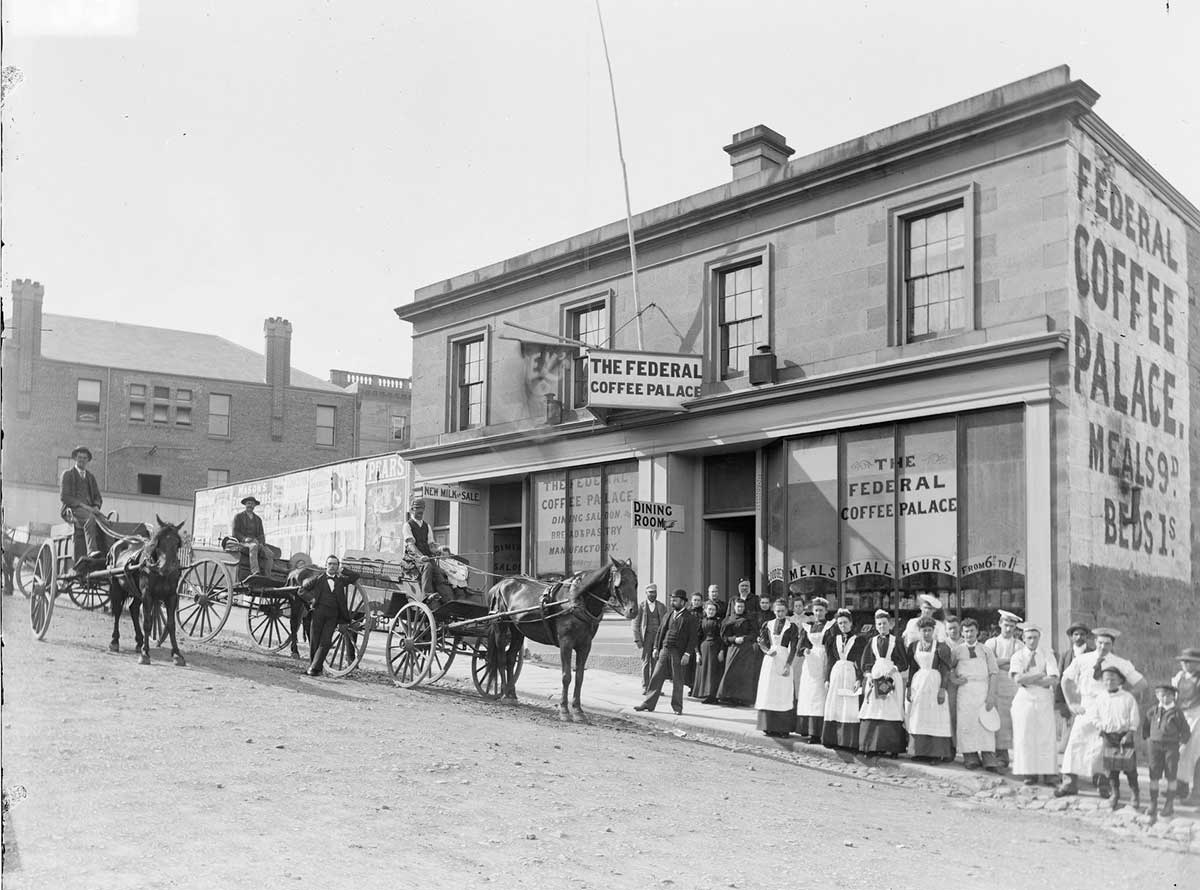
The temperance movement was concerned about the evils to society being caused by excessive alcohol consumption. In the late 19th century they encouraged the opening of coffee palaces where meals and accommodation were provided in an environment free from the temptations of alcohol. The Federal Coffee Palace operated during the 1890s. Coffee palaces turned out to be a bit of a late Victorian fad. The Federal Coffee Palace became a bakery but, ironically, some of the other coffee palaces turned into licensed hotels.
dominating parapet, the corner building has a cornice.
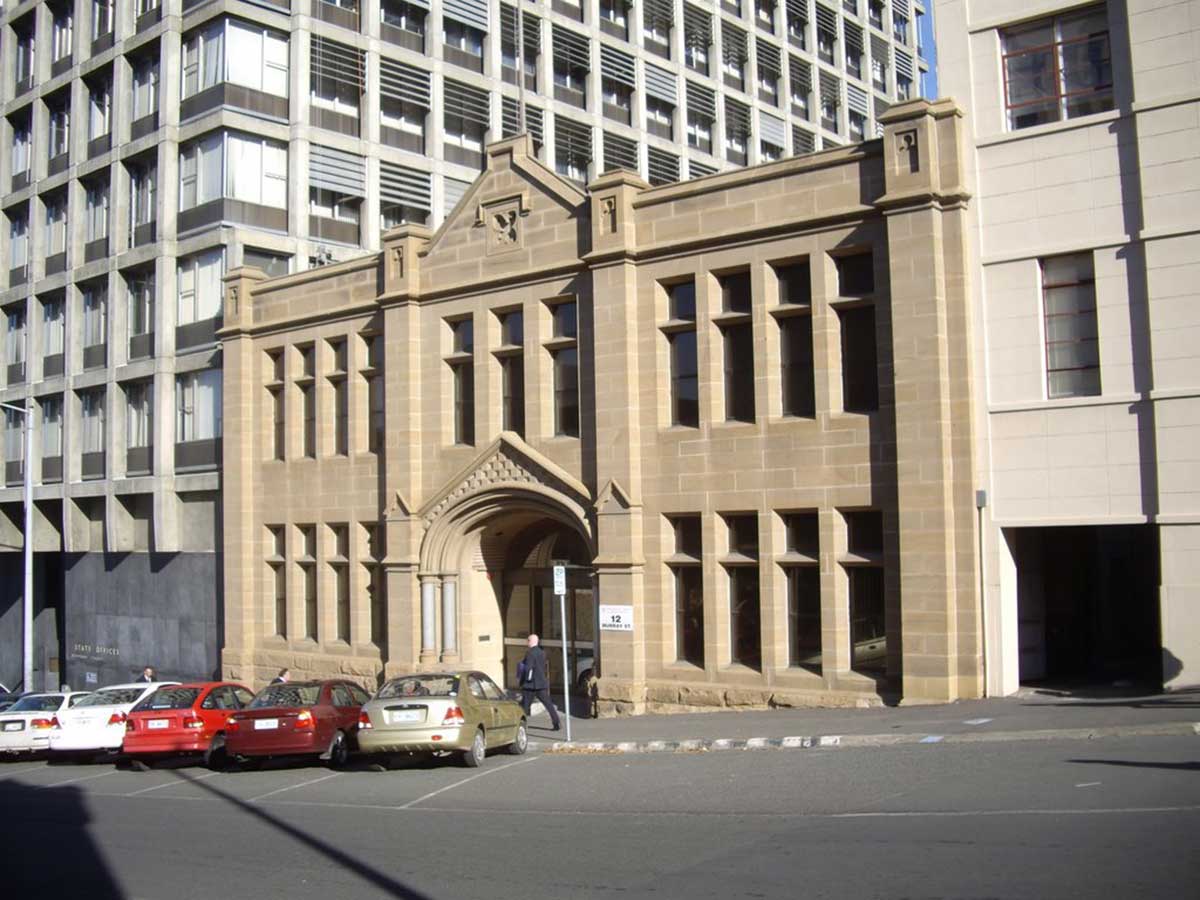
All that is left of this handsome sandstone building is its facade. Its design showed both Gothic and Classical influences.
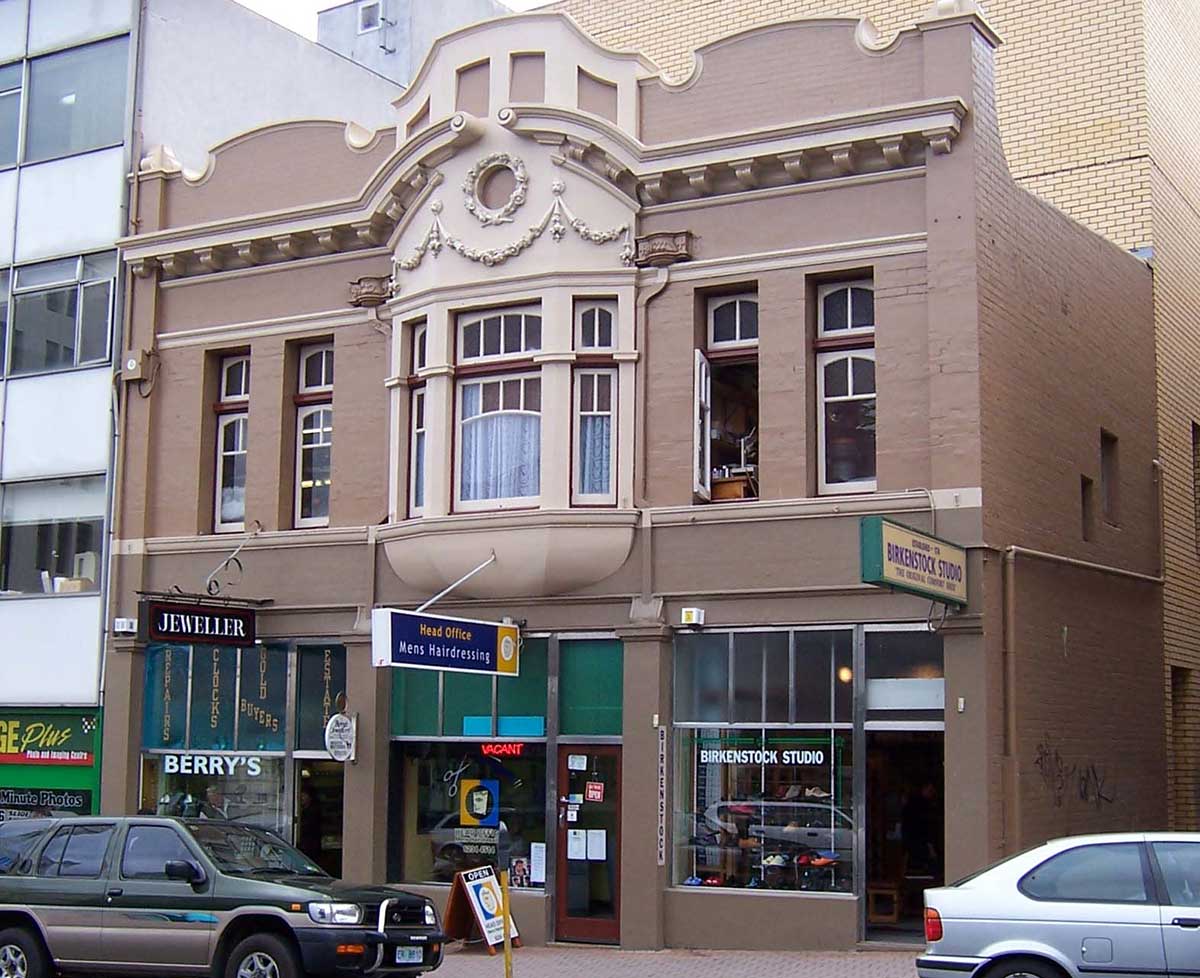
The predominant feature of this Anglo Dutch style two storey commercial property is its highly decorated second storey oriel-style bay window.
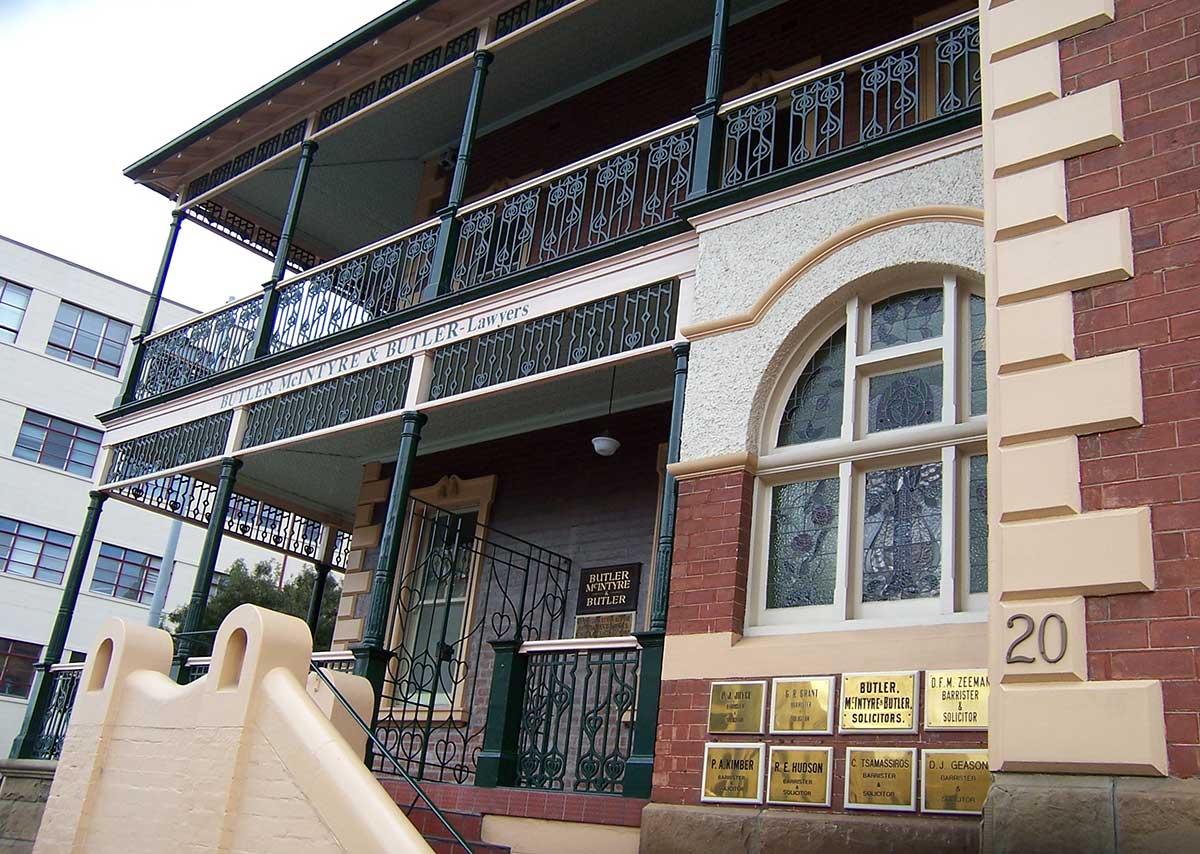
An Edwardian two storey building on a stone base built with hipped iron roofs and bracketed eaves on protruding wings, and elaborate iron balustrading to the two storey return corner verandah. Construction is red brick with white stuccoed window surrounds and quoins.
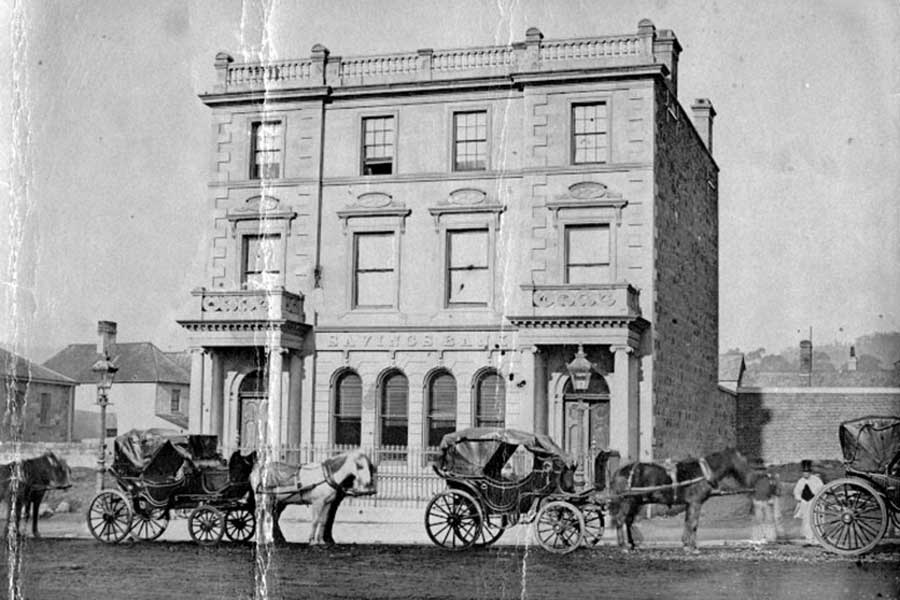
The Hobart Savings Bank was established in 1845 to encourage industry, frugality and prudence among the working class. Their premises were constructed using white sandstone from quarries at Kangaroo Point (today’s Bellerive). The bank was designed by Edward Rowntree and constructed by John and Robert Meikle. There was a cab-stand in front of the building and the vacant blocks on either side were not developed until the 1870s.
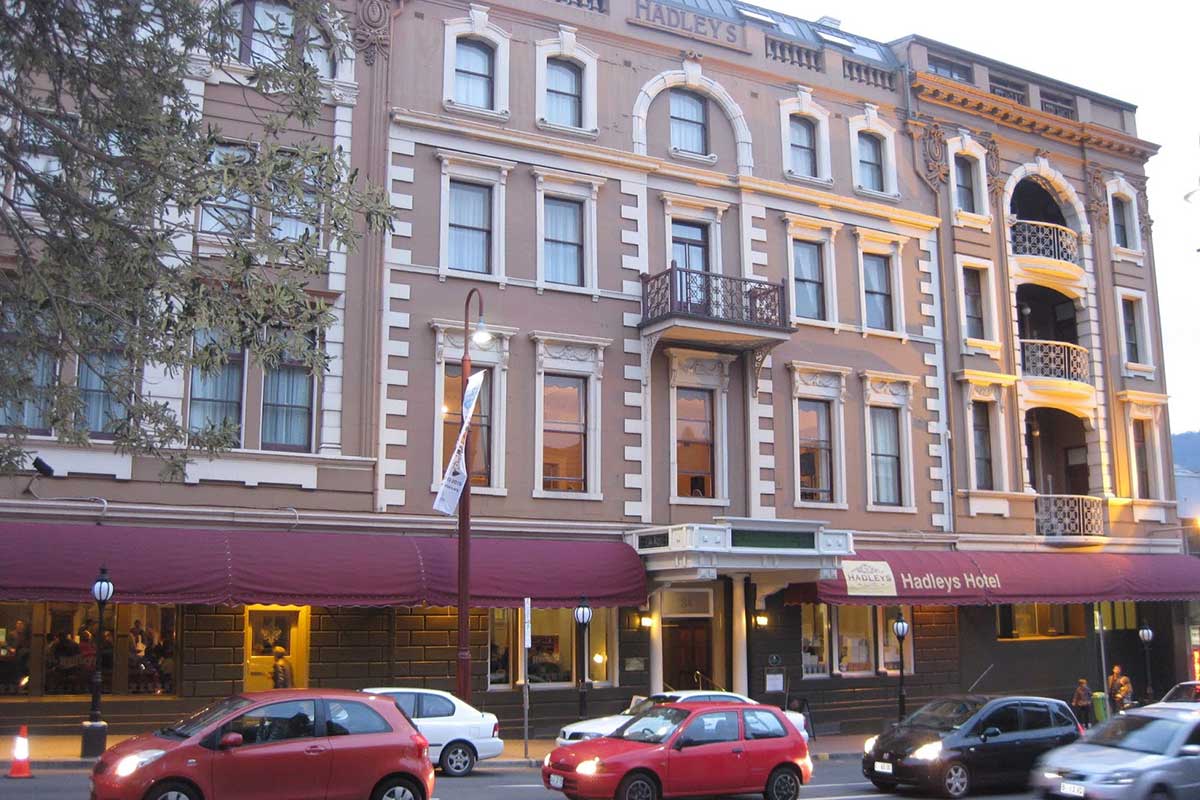
The former Hadley’s Orient Hotel dates back to 1834, when it was established as the Golden Anchor Inn, and has the longest continuing hotel license. It has played an integral part in Tasmanian and Australian history, noted in the Constitution minutes as the venue for meetings in Tasmania on the formation of the colony. Many famous Australian and international guests including Tasmania’s famous son Errol Flynn (movie actor), entrepreneur Henry Jones ('King of Jam') and (antarctic) explorers Australian Douglas Mawson as well as Norwegian Roald Amundsen. "Legacy" was founded in the Bowen Room at this hotel by Sir John Gellibrand in 1923. The current building was built by convict labour and began trading as the Marquis of Waterford in 1849, later to be known as Webb’s Hotel after being purchased by a pardoned convict, John Webb.
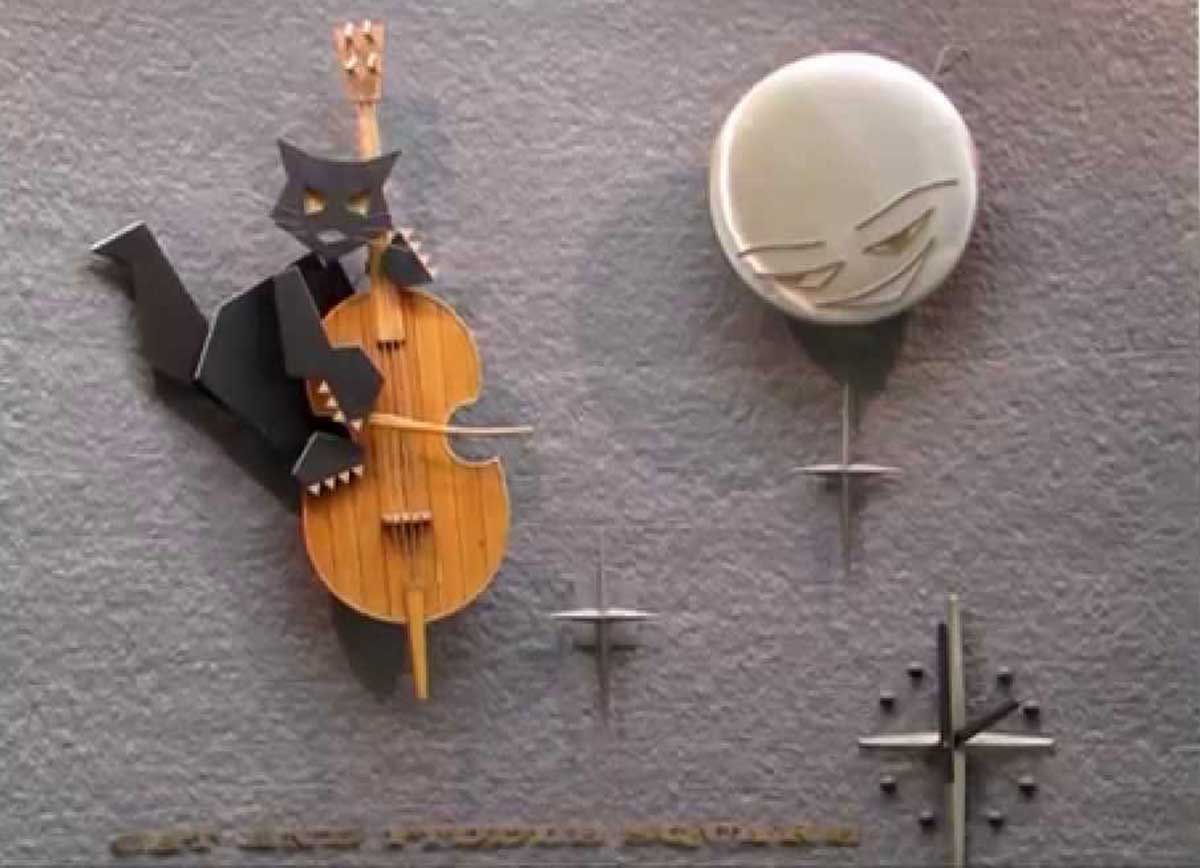
The alley can be traced back to 1817 during the reign of Governor Sorrell. An inn called the Cat & Fiddle did a roaring trade down this little side street. In 1862 Cat & Fiddle Alley (now renamed Elizabeth Lane) became the new address for Charles Davis & Semple General Merchants. The inn had long since ceased to operate. The alley once consisted of some 20 houses, stables and a fellmonger’s yards.
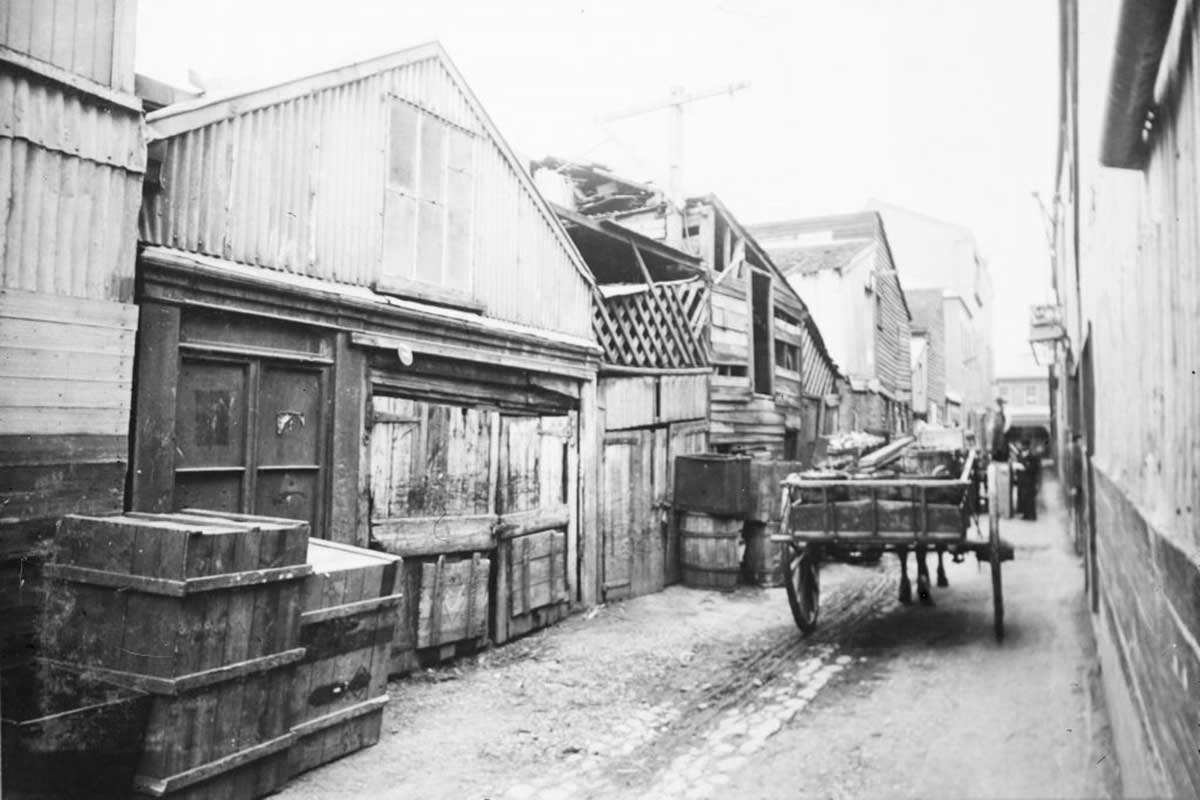
An early description of the ‘Alley” – “In the past it had echoed the echoes of hard fisted whaling men of a dozen nationalities English solidarity stamped its cobblestones. It knew gentlemen of leisure and let’s admit it, ladies of pleasure. Its attraction was a low roofed ill lit tavern called the Cat and Fiddle”. The Albion Hotel side entrance was located in the lane way. The Albion Hotel in Elizabeth Street was the Terminus for Cooley’s Coaches 1825-1835.
More >
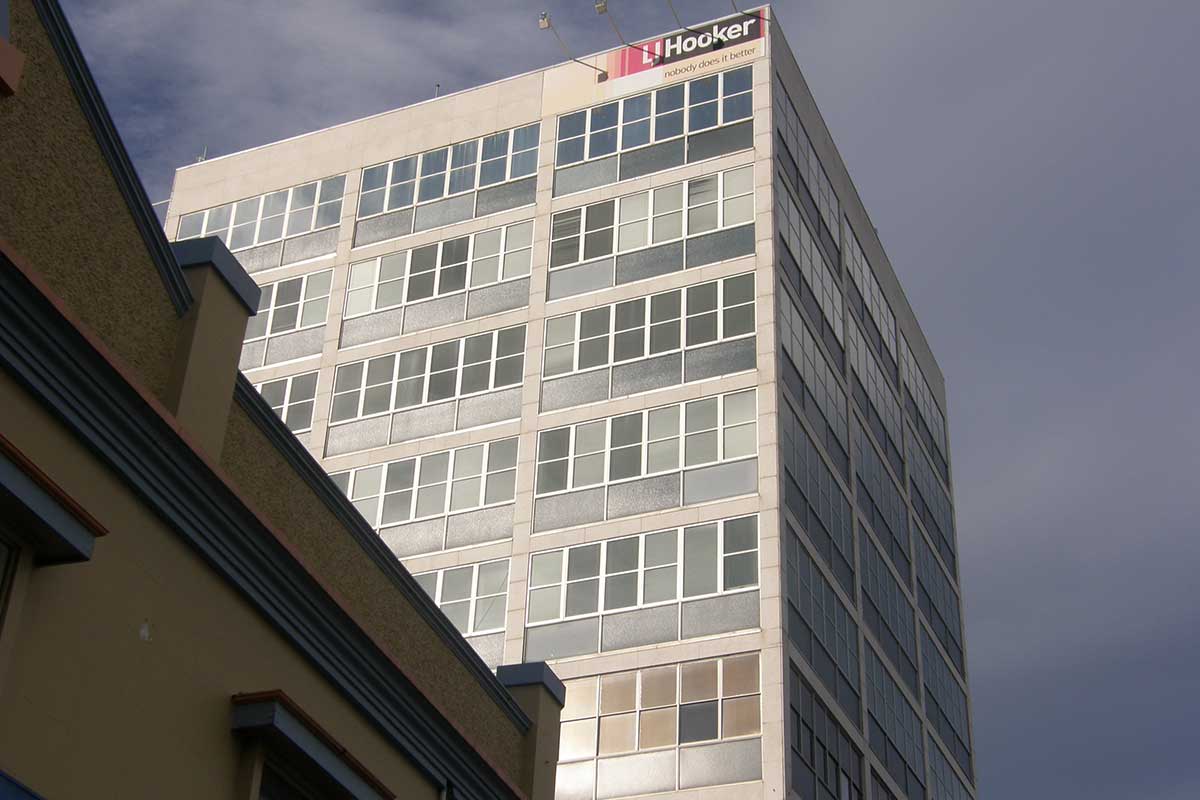
This office building in the Hobart CBD graphically illustrates the simplicity and minimalistic nature of modernistic architecture. The exterior walls are merely glass fills between the building's exterior rectangular concrete and steel framework.
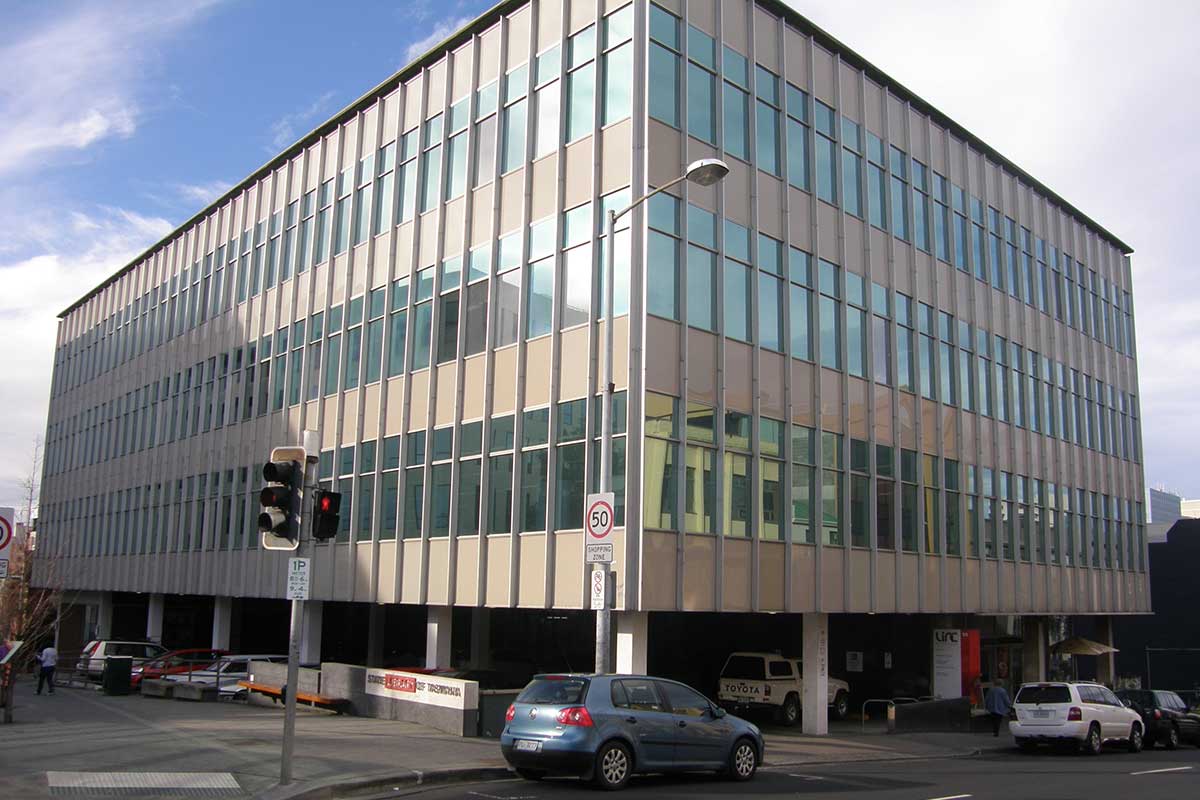
This was one of the earliest curtain wall designs in Hobart city and Tasmania. One of the most interesting and intact example of post war Modernism, the four storey building has a major part of its ground floor dedicated to car parking. The structure is steel framed with concrete columns and floor slabs. The building envelope is primarily a curtain wall of extruded aluminium sections, which are vertically aligned and project from the glazing of each facade. Externally, the base to Murray Street is formed as a low garden wall, with planter boxes )now covered over with square concrete pavers) flanking both sides of the main entrance and faced with black mosaic tiles. J F D Scarborough, FRIBA, FRAIA, was engaged to prepare the plans and later acted as consultant architect on the project.
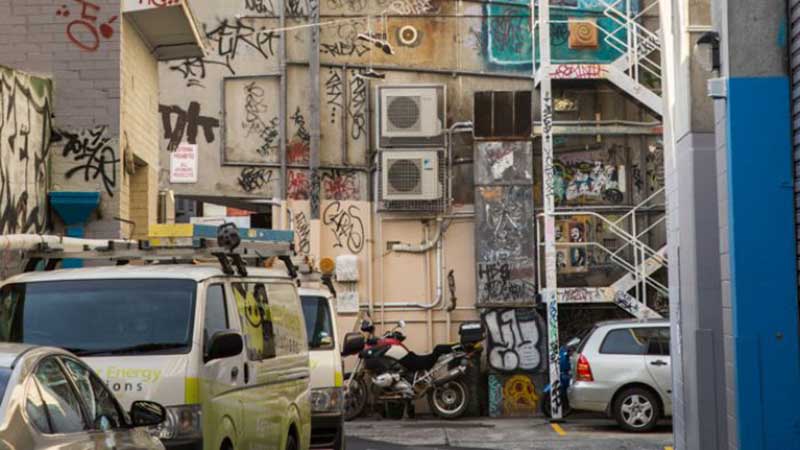
The name recalls Joseph Bidencope (1837-1915), tailor and mercer who had premises there. Bidencope was born in 1837 in Poland. In 1857 he signed as crew in the Trade Wind and sailed for Tasmania. Arriving in Hobart Town in February 1858, Bidencope was employed as a tailor by Henry Cook in Elizabeth Street. Soon he opened his own business in Collins Street, and later Murray Street. By 1862 the firm had become a well-known fashion house, with naval and military uniforms a continuing feature. The fashionable and the fastidious shopped exclusively at Bidencopes. A Freemason, sometime worshipful master of the Tasmanian Operative Lodge and an office-holder in the Grand Lodge of Tasmania, he was appointed a justice of the peace in 1902.
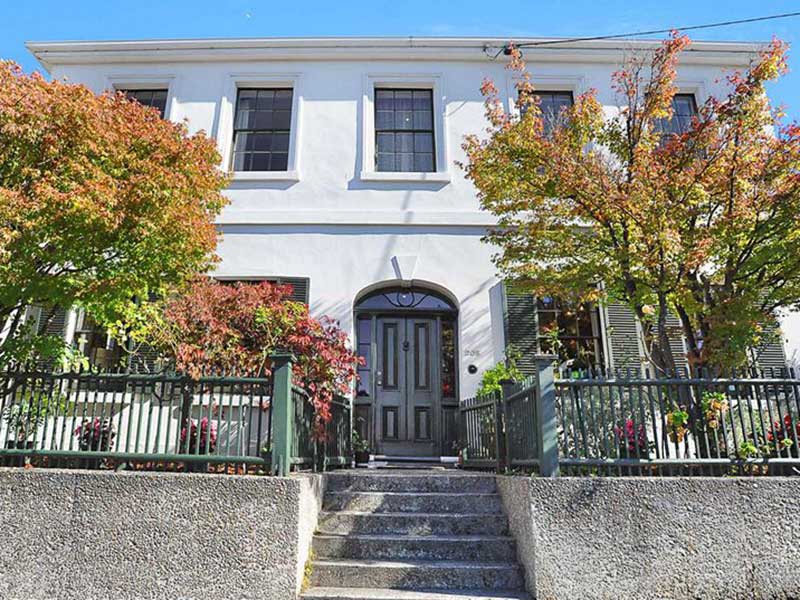
An excellent example of an early Colonial Georgian townhouse with an unusual simple fanlight above entrance. The two storey stucco Georgian residence occupies a corner site. It features five bays with central entry comprising four panel door sidelights and unusual fanlight. Decorated stucco keystone. Twelve pane windows. String course expressed. Mouldings to level two windows. Iron hip roof.
The name recalls Luke Richard Castray, Commissioner General who conceived the road link between Sullivans Cove and Battery Point.
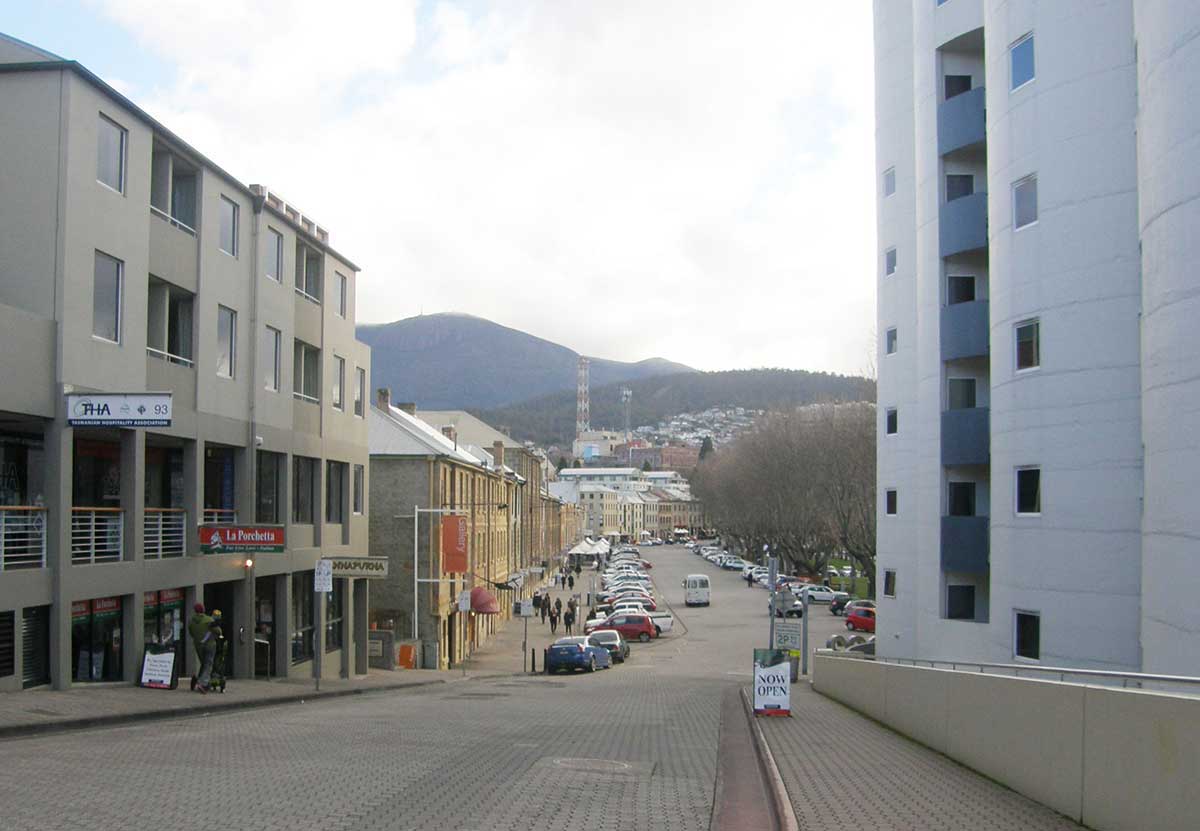
For around fifty years the Hobart Silos were used as a storage facility for grain, destined for export. Today they house thirty luxury residential apartments. The existing concrete walls provided the shell for a ten-storey structure incorporating the use of pre-cast concrete columns and in-situ concrete slabs.
The four 30-metre high concrete silos were converted at a cost of $15.2 million. The high-rise apartment block faces north across the Hobart docks and waterfront. The Silo’s building comprises of the ground floor being commercial tenancies that include restaurants, and clothing stores. The first to sixth floor comprise of single silo, single floor, two bedroom apartments. The seventh and eighth floor comprise of double silo, three bedroom, sub penthouse apartments. The ninth and tenth floors comprise of double silo, two level penthouses, that provide an opulent living lifestyle combined with magnificent views of the city and harbour.
Alongside and separate to the main structure stands a new four-level commercial building. Known as the Castray building it comprises secure car parking, office and / or retail space and eighteen family and studio hotel accommodation units. The structure consists of post-tensioned in-situ concrete slabs and over five hundred precast wall panels.
The name recalls a town in Spain which the Allied army led by the Duke of Wellington took on 17th June 1812 during the Peninsula War (1808-14). Probably named by surveyor George Frankland in commemoration of Wellington's great victory against the French in 1812. Frankland was surveyor-general of Van Diemen's Land, 1828-1838.

This row of buildings are accepted as the best waterfront Georgian warehouses in Australia. Nos. 47 to 89 were built between 1835 and 1860 and at that time had direct frontage to Hobart's 'New wharf'. Great architectural consistency is achieved through the common use of stone, the proportion and rhythm of fevestration and the horizontal linkage of sill lines and string courses. Although built over an extended period and buildings are irregular in height, proportion of openings and detailing is the same giving the group great consistency. Lining up of strings and sills gives the group horizontal direction. Nos. 21 to 33 were built in the 1840s.
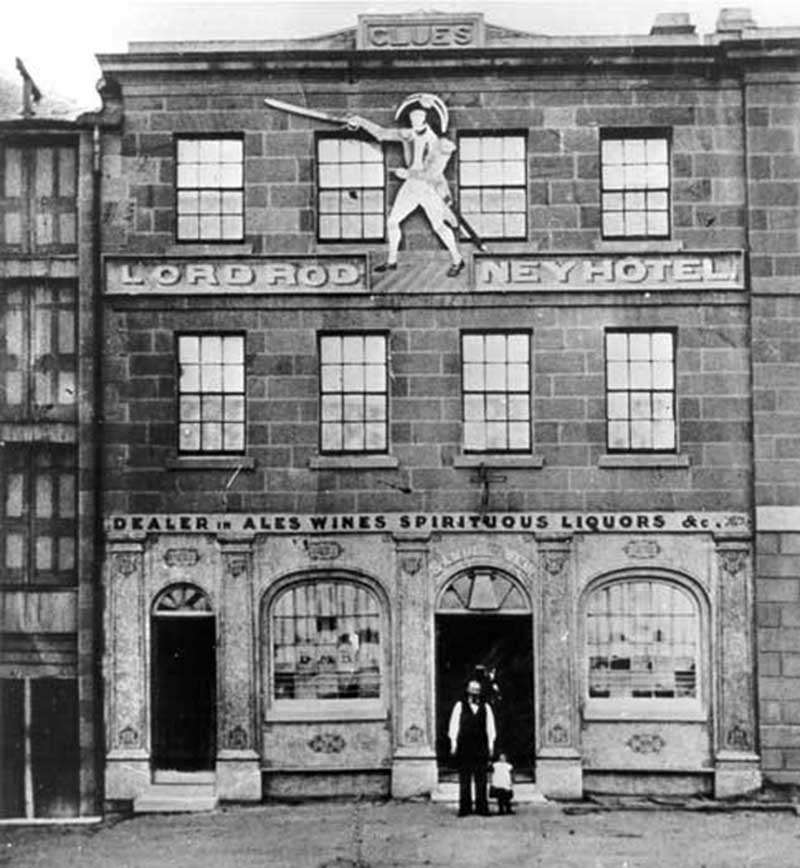
This elegantly proportioned three-storey building was erected by William Clues and his name appears on its parapet. He intended it to be a hotel of the first respectability and spared no expense in its construction. Clues licensed the premises as the Lord Rodney Hotel in 1845, named after a distinguished British naval commander. In the 1880s the licensee was Samuel Weir who was a bit of a character and on one occasion he was arrested for smuggling. He had been spotted acting suspiciously near the wharves after dark and on being approached was found to be in possession of a keg containing three gallons of brandy. Weir was unable to give a satifactory account of his circumstances and was convicted of trying to defraud Her Majesty’s Government of customs duties. The Lord Rodney Hotel closed in 1899 after it was purchased by ‘F W Moore & Co’, jam manufacturers. When the sign depicting Lord Rodney was taken down from the front of the building, newspapers reported that an old landmark had been lost.
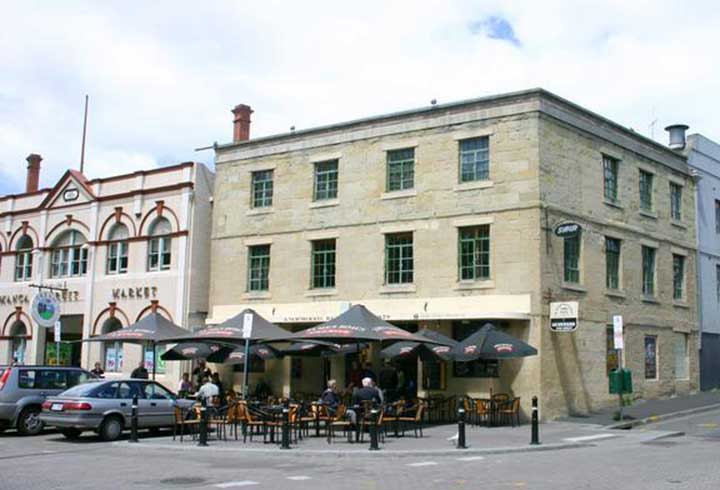
A three storey stone Georgian colonial building, now a hotel, with hipped roof behind a parapet. It has string courses at floor levels and equi-spaced twelve pane windows at upper levels. It has only recently been restored to present state from previous 50's style facade etc. Stonework now badly damaged, and little is original. Retains concrete canopy at 1st floor level. Essentially of streetscape value only. This three-storey stone building on the south-east corner of the Salamanca Place / Montpelier Retreat intersection has been a pub since 1835. Originally known as the Whalers Return, its name was changed to the Nautilus Hotel in 1864, changed again to the Lord Nelson Hotel in 1888. The pub has been known as Knopwoods Retreat, named after the Reverend Robert Knopwood, Tasmania’s first clergyman, who built a cottage nearby back in 1805 shortly after Europeans first arrived.
In August 1872, the pub was the scene of an unfortunate incident involving John Wooby. He had been drinking for most of the day and was in a quarrelsome mood when he arrived at the Nautilus Hotel. Wooby went into a room where some men were playing bagatelle (an indoor game similar to billiards) and bet one of them a shilling that he wouldn’t make a shot. Wooby refused to pay when he lost the bet and the man took Wooby outside and punched him in the face. Tragically, Wooby’s skull was fractured when he fell backwards and this led to his death the following day. The man was tried and found guilty of manslaughter but it was accepted that he had not intended to kill Wooby and the judge let him off with a ₤10 fine. Woobys Lane, a nearby laneway that provides access from Salamanca Place to Salamanca Square, is named after John Wooby.
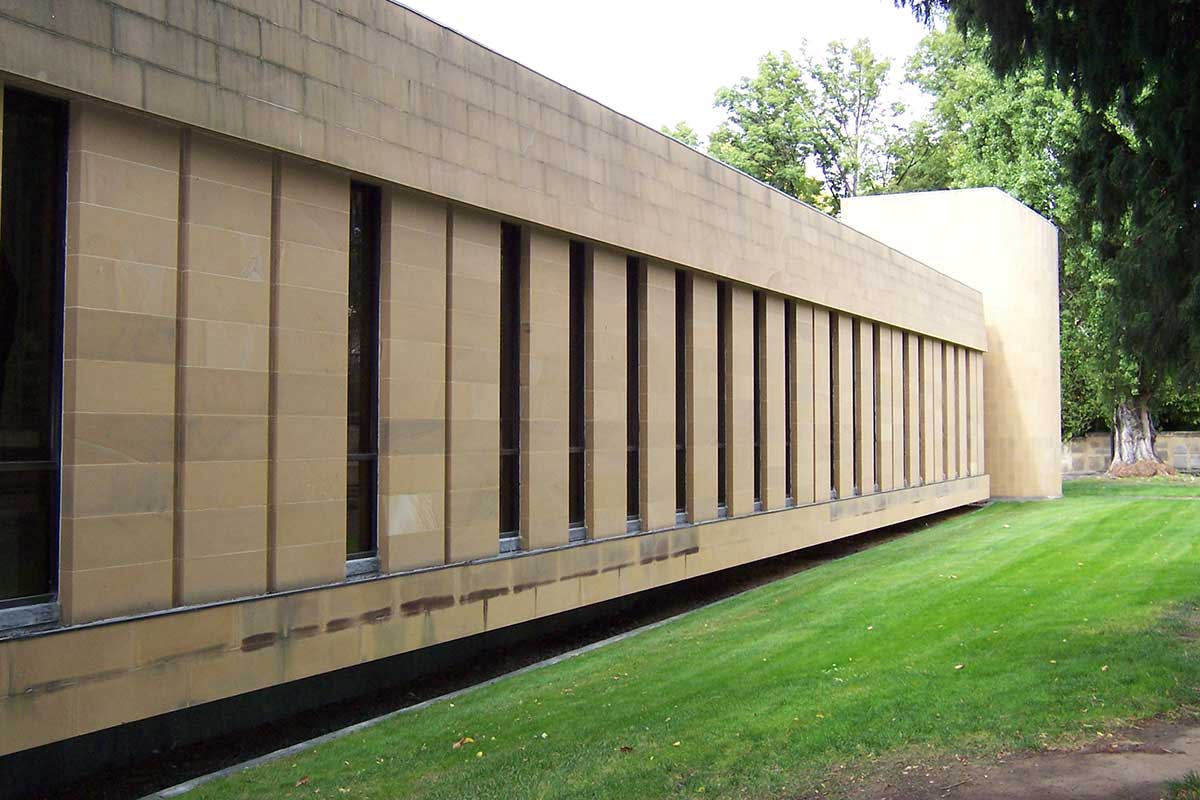
A recent addition to the streetscape of upper Salamanca place, its is a rare single-storey example of Stripped Classical Revival which blends in well with the many Georgian and Classical style buildings surrounding it. The complex was designed by British migrant architect Peter Partridge and built by the Tasmanian Public Works Department.
Named after the first official Colonial Secretary, Frederick Goulburn, who arrived in Sydney in 1820. His brother Henry was an official in the British Government and held various senior positions including secretary to Lord Bathurst. Named by either Gov. Macquarie or surveyor George Frankland.
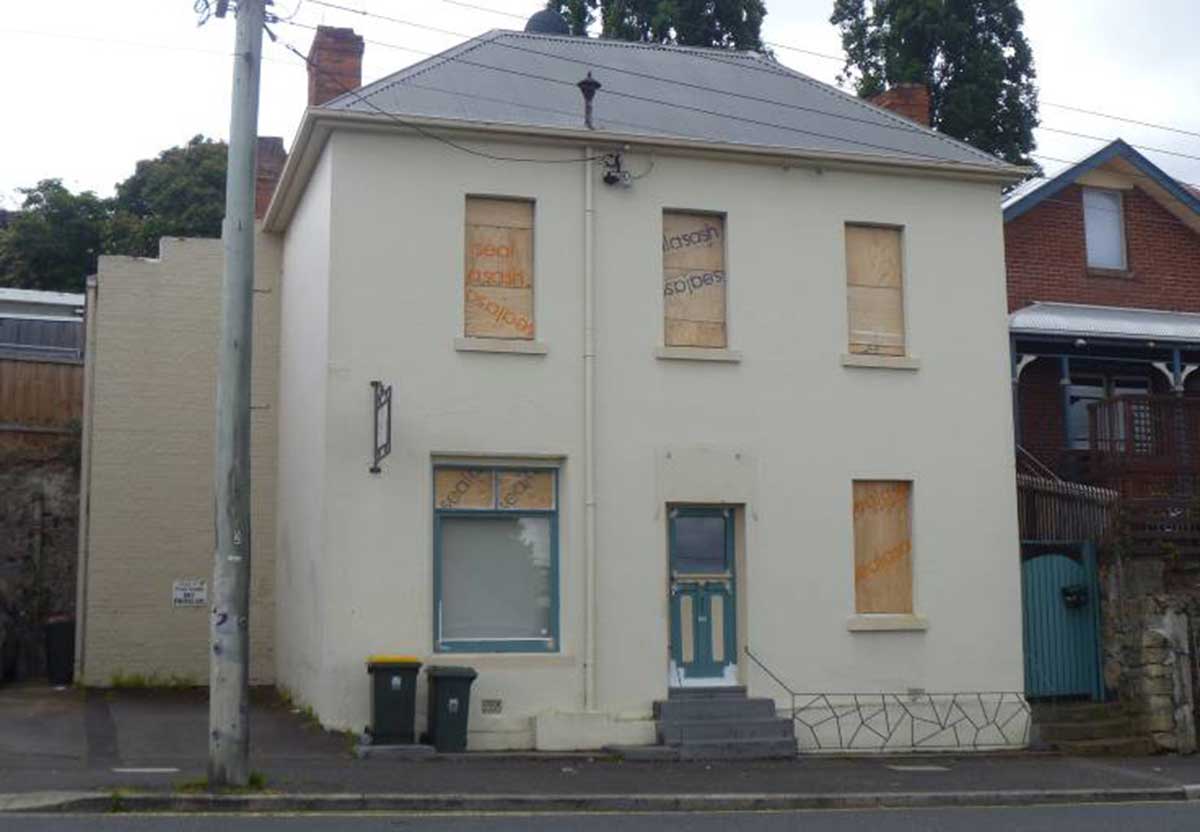
This distinctive Georgian building was first licensed as the Star Inn in 1839. In 1881, its landlord, Michael Normoyle, was charged with being intoxicated on his own premises but the case was dismissed on account of insufficient evidence. Normoyle continued to conduct his house in a disorderly fashion and the following year he was charged under an obscure provision of the Licensing Act which made it illegal to receive payment for alcohol by anything except the current coin of the realm. It was alleged that Normoyle had kept tradesmen drinking at his house after they had ran out of money and had then settled their accounts by getting goods from them. Once again the prosecution failed when the Police were unable to present witnesses. However, when Normoyle applied for his annual licence renewal, even though he had no convictions recorded against him, it was refused on the grounds of his bad character. The Star Inn was delicensed in 1918 and subsequently became a private residence.
Originally known as St Patrick Street. Like its twin in Launceston, it was named to honour Irish born Father Phillip Conolly (1786-1839) whose work as a Catholic priest brought him immense respect in the community. The name recalls St Patrick (604-742), the Patron Saint of Ireland.
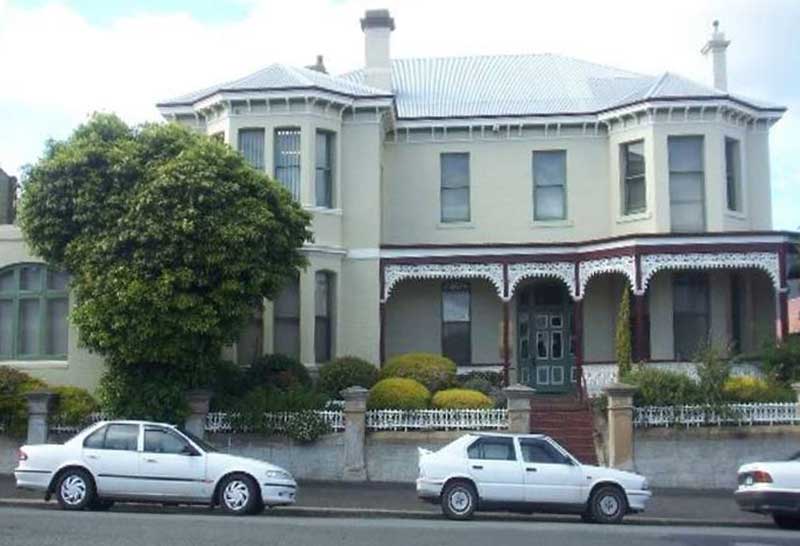
A large and prominent Victorian Italianate mansion with a projecting bay window, bracketed eaves, a verandah on two sides with cast iron lace work and a minor bay window on the southern side. The building has stucco detailing such as quoins, mullions and string courses. The building was constructed in 1897 by a Mr Fred H Crisp, a timber merchant and saw miller. By the early 1920s, Ingomar changed from being a private residence to a private boarding establishment. In order to accommodate additional guests, a loft was built in the roof in the late 1930s.
Due to Ingomar’s proximity to sporting facilities, it was well patronised by sporting groups. The popularity of Ingomar saw the North Hobart Football and Sports Club purchase the Hotel. In 1976 the Ingomar was sold to the Tasmanian Teachers Federation (now the Australian Education Union). The TTF continued to run the Ingomar as a hotel. Ingomar was then leased as a school building, housing the Lambert Cottage School. Later, the ground floor was the home of the Tasmanian branch of the Australian Labor Party.
Named by Gov. Lachlan Macquarie after his wife, Elizabeth Henrietta Macquarie (nee Campbell), as was Campbell Street.
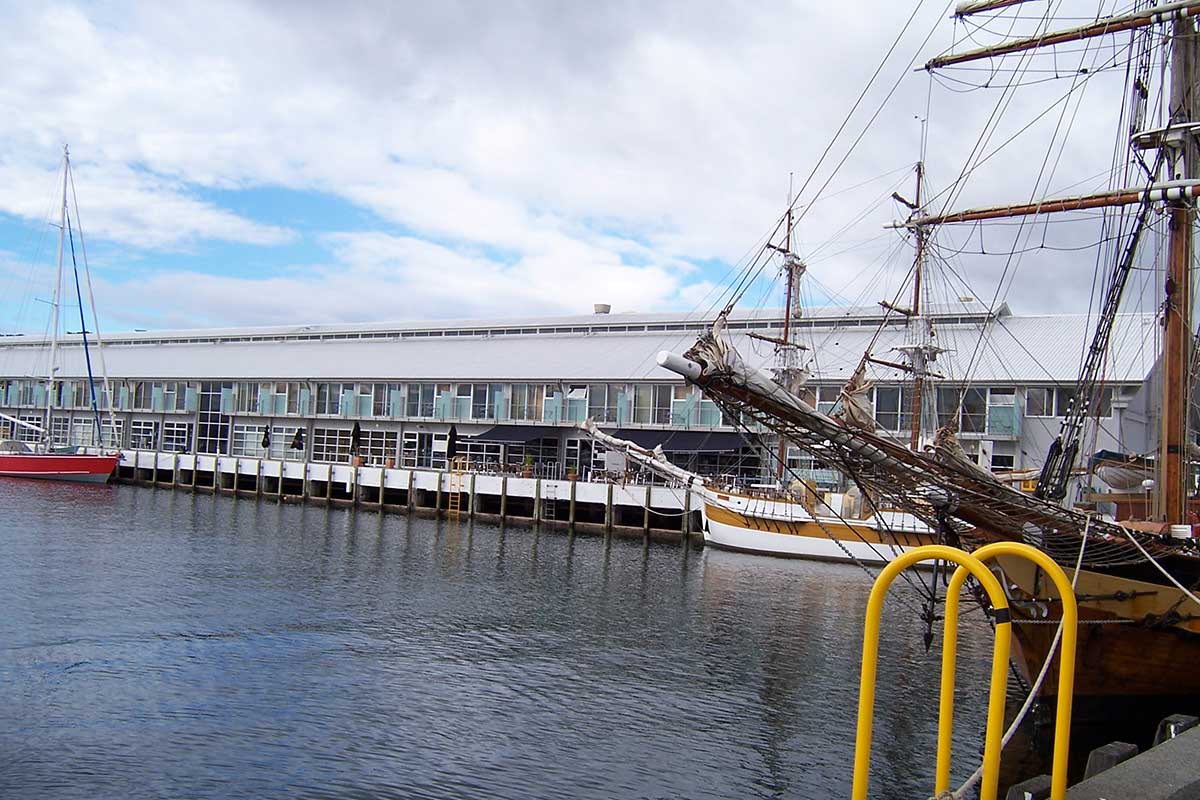
This pier replaced the former Argyle Street Pier (1875) and Elizabeth Street Pier (1876). It was designed by HR Hutchison in 1932 and was believed to be the only completely reinforced concrete pier and shed in Australia at that time. The new structure, 152 metres long and 36.5 metres wide, was constructed at a cost of $75,000 by Cheverton & Gray, starting in September, 1932, and was opened for traffic on 26 June 1934 by the Governor, Sir Ernest Clark, and Lady Clark. The shed, with an area of 2,627 square metres, had reinforced concrete walls and asbestos-cement roof. The longest pile is 32.6 metres long, weighs 27 tonnes and is driven 15.8 metres into the sea bed. During the Tasman Bridge emergency (1975-77), this pier was used as the city passenger terminal, with four ferry berths constructed on the pier. The shed was converted to an apartment style hotel, convention rooms and cafes in 1997 with the deck, columns and roof line being retained.
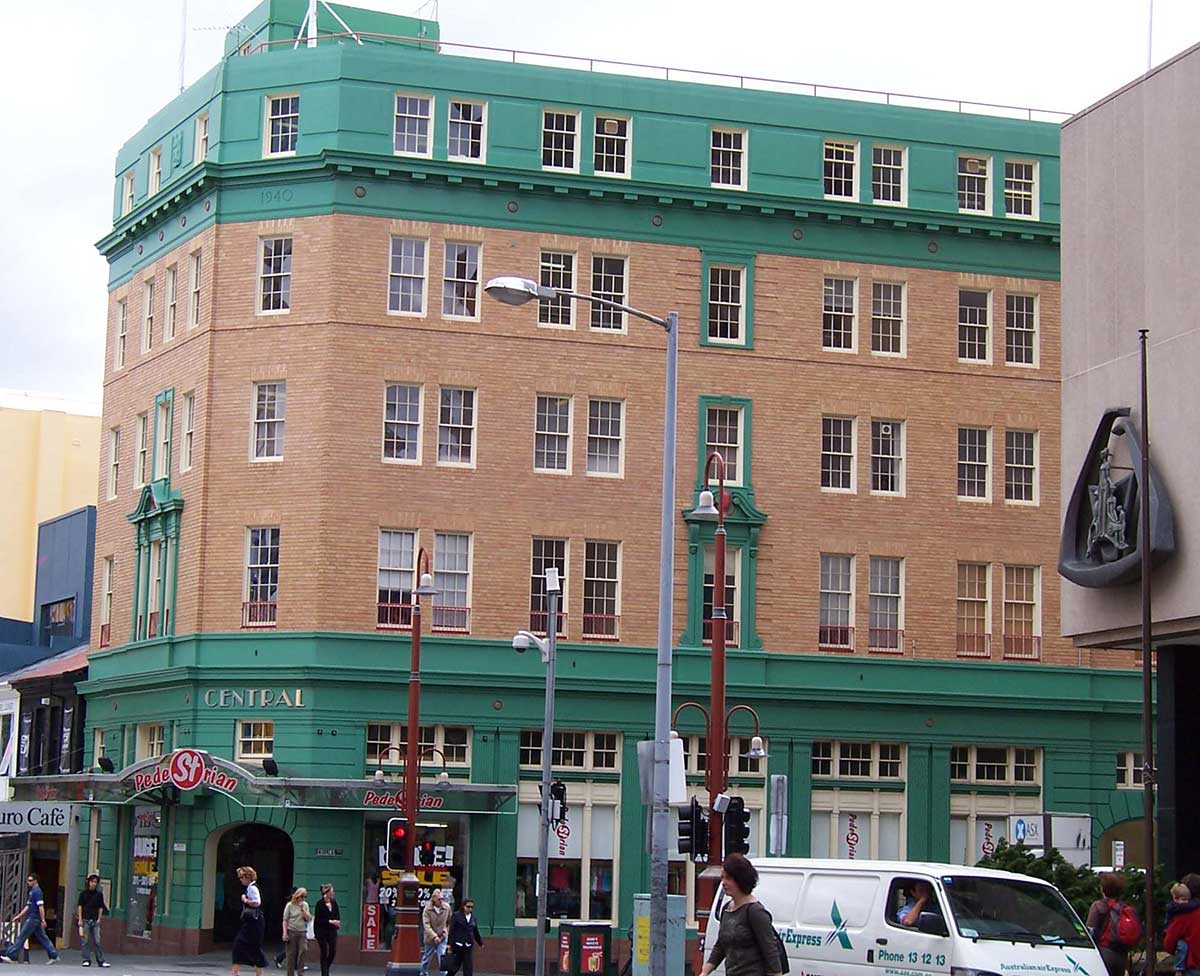
A fine but rare example of the Georgian Revival style in Tasmania. It is surprising that the style was not more widely used in Hobart, given the number of Colonial Georgian buildings, that ones such as this complement architecturally. Former the Bank of Australasia, the design was produced by A and K Henderson of Melbourne. The bank occupied the ground floor and the rest of the building was let as offices and professional rooms. The building has survived with few changes. The main entrance has been moved to the corner and the ground floor is now occupied by Dome Café.
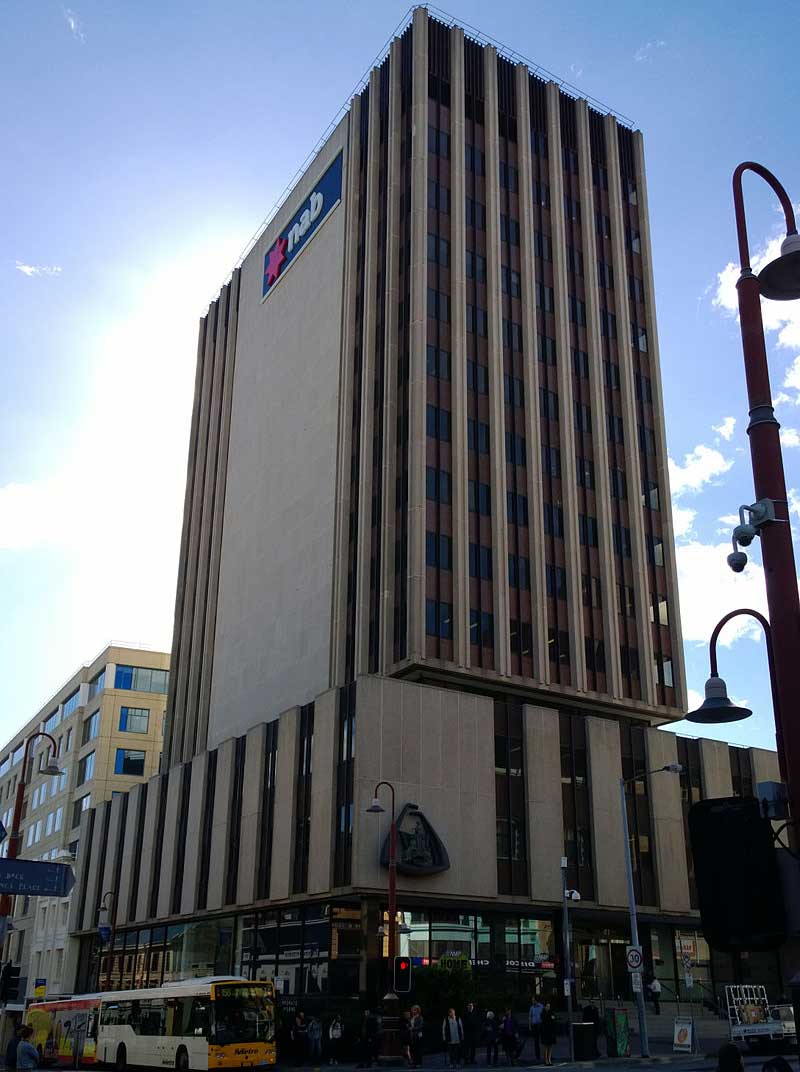
An example of the International style from the latter years of its popularity when there was a move away from the floor to ceiling glass 'curtain wall' effect. Solid walls of faced concrete were utilised, often on northern faces of a building, to reduce glare and heat from direct sunlight. The AMP Building, which the new tower was named, became Hobart's tallest building in 1968 until the construction of the Wrest Point Hotel Casino in 1973. In 2011, the primary tenant of the building changed to the National Australia Bank (NAB), and subsequently the building was renamed NAB House. NAB House remains the second-tallest building in Tasmania, and a prominent landmark in Hobart City.
architecturally. Built by Hansen Yuncken Pty Ltd in 1968. Height: 58 metres. 14 floors.
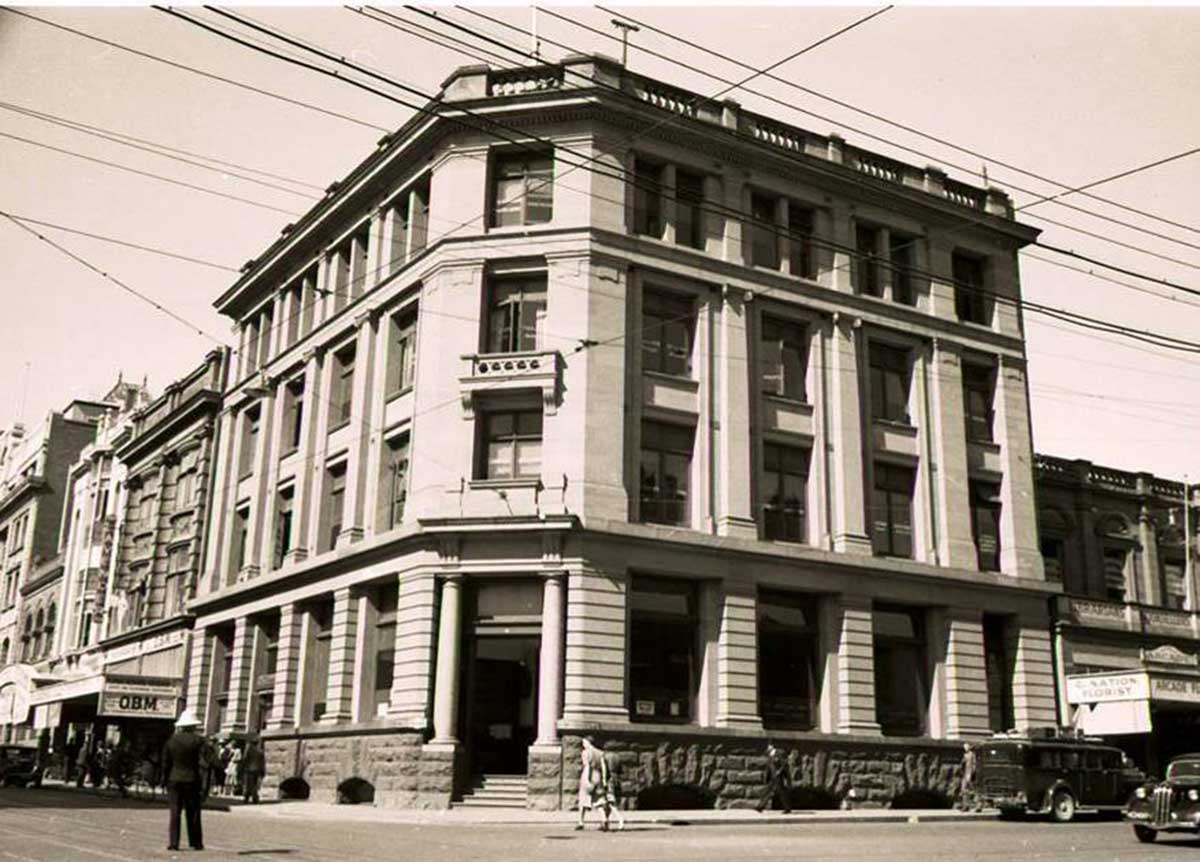
These dignified and distinguished premises were designed by A and K Henderson of Melbourne and were built in 1917-18. A newspaper article proclaimed that they were an outward indication of the material wealth of an important and fast expanding capital and seaport. The building comprised a basement, ground storey and three upper floors. The ground floor was occupied by the bank while the first, second and third floors contained 36 offices for letting. The roof was flat and had a caretaker’s cottage on top of it. The building was equipped with a fast-running automatic button control lift for rapid communication between the floors. All of the beams, columns and floors were made of reinforced concrete, and the floors were covered with thick linoleum, glued down to the concrete, so that the premises were practically unburnable. The strong rooms were constructed with thick concrete walls interlaced with heavy railways rails and were confidently declared to be absolutely burglar proof.
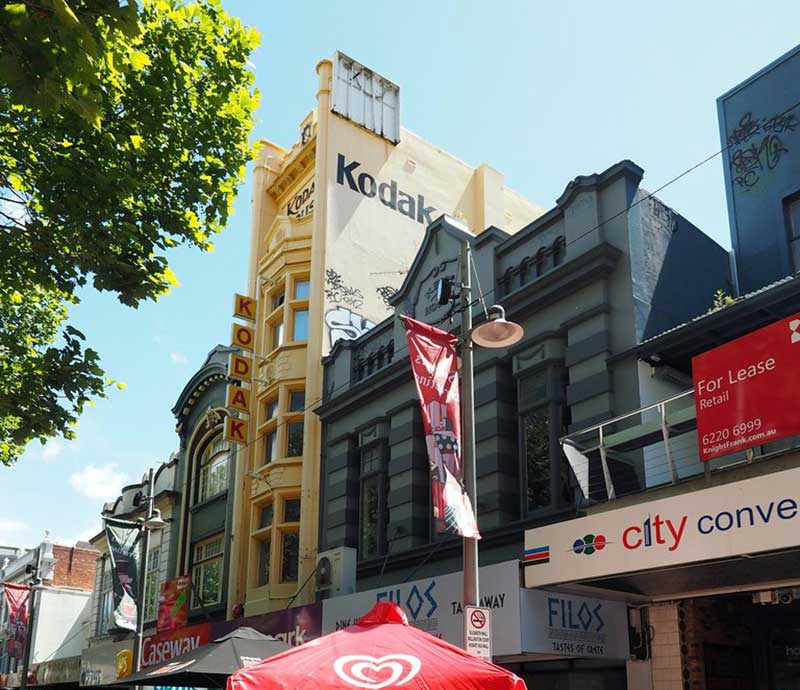
This building towers over its neighbours and this, combined with its distinctive stylised architecture, gives it landmark qualities. The ever-increasing popularity of photography had compelled Kodak to establish centrally situated premises in 1924. The multi-storey design made the most of the narrow street frontage and the use of reinforced concrete rather than conventional brickwork saved space by reducing the thickness of the walls. There was a shop on the ground floor with developing, printing and enlarging rooms on the upper floors. An automatic lift was provided.
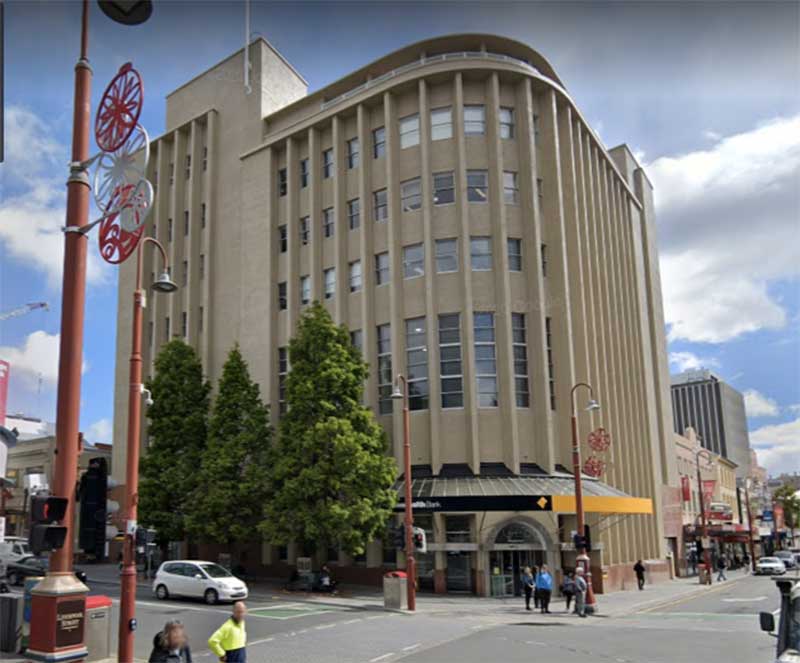
Excavation for the basement levels of this mammoth structure commenced in 1949 but shortages of labour and building materials in the post-war period hampered progress and the works were not completed until 1954. There were so many new Australians of different linguistic origins employed on the construction site that it was compared with the Tower of Babel. The building required 12,000 tons of concrete, 20,000 yards of plastering and 30 miles of electric wiring.
The finished structure had nine floors, including two below ground level. The entire building was used by the Commonwealth Bank, with the fourth floor devoted to staff amenities including a cafeteria, kitchen, dining room, rest and recreation rooms, and a library. The bank’s official opening was attended by more than 1,500 people. It was proclaimed as a palace of commerce that would provide banking services to the city for many generations. The new bank was said to be Hobart’s equivalent to New York’s Rockefeller Institute Building. The premises were formally opened when the bank’s governor pressed a button which electrically opened the bank’s two main sliding doors.
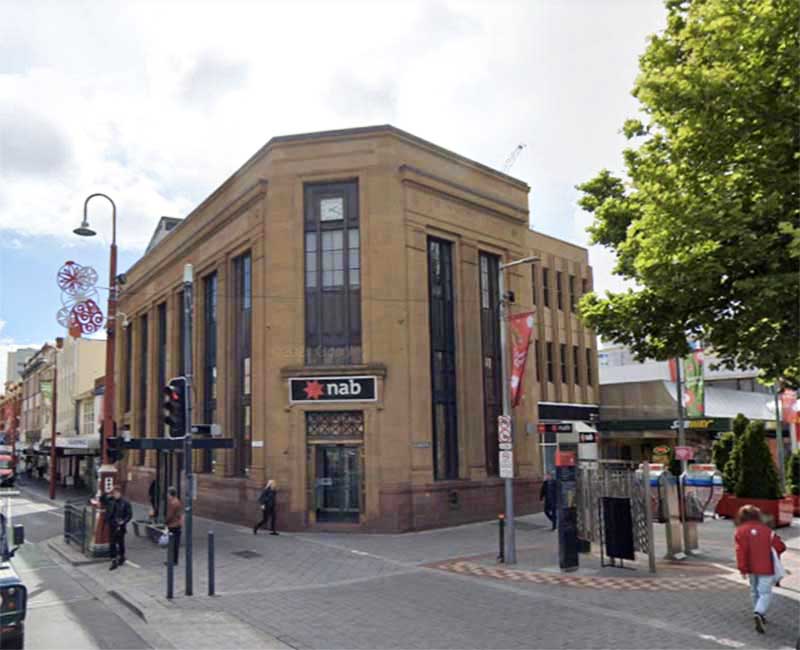
The architects of these premises were A and K Henderson and partners of Melbourne, and the construction work was carried out by Hansen and Yuncken Pty Ltd. The stone used in the building was all quarried in Tasmania, but had to be shipped to Victoria for cutting and polishing, and then returned to Hobart. The ceiling over the second storey was designed as a floor, in case it was decided to increase the height of the building in the future.
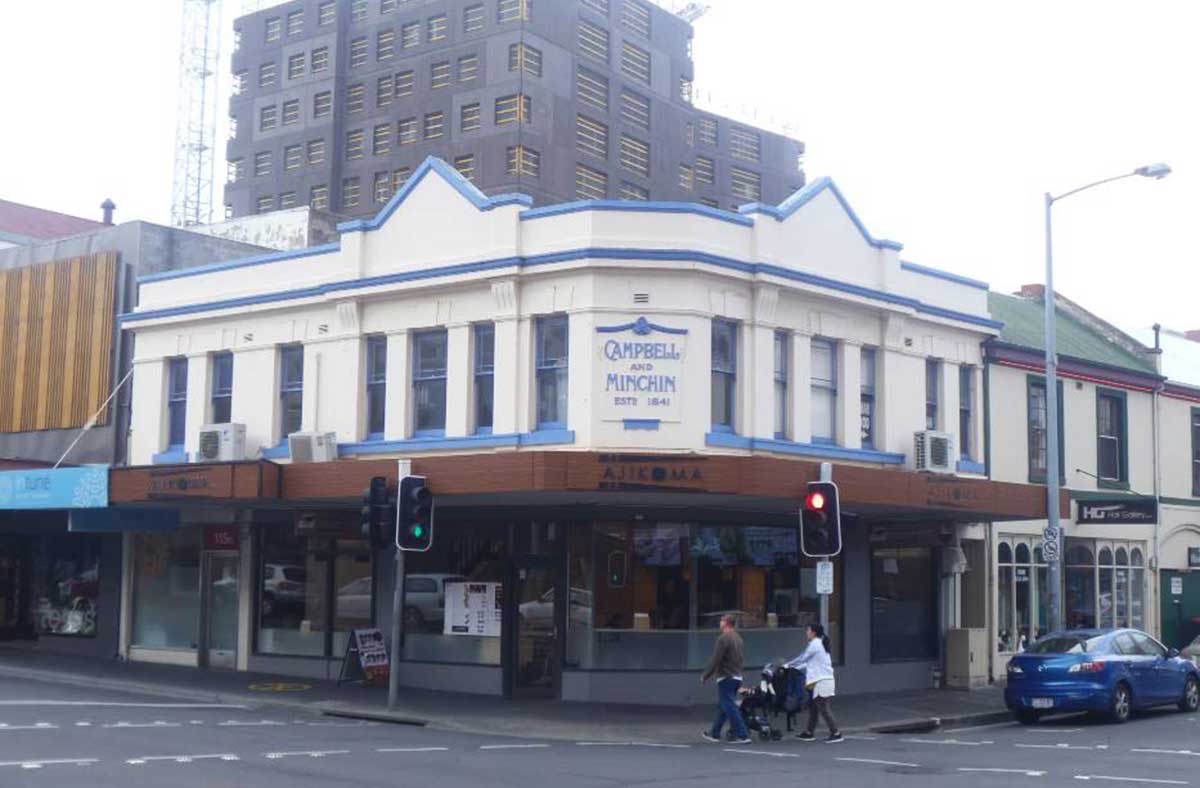
This corner used to be occupied by a public house. The Verandah Wine Vaults opened there in 1831 and its name was changed to the George and Dragon in 1851. There was a large yard at the rear of the premises that was used by visiting circuses and in 1876 there was a show that featured the ‘largest lion in the world’ and a pig with eight legs, as well as acrobats, a tightrope artist and plenty of ‘jugglery.’ The George and Dragon was closed down in 1919 and the property was purchased by Campbell and Minchin, a saddlery firm which had been established in Hobart back in 1841. The new owners arranged for alterations and additions to rehabilitate the old hotel into three modern shops with offices above. Saddliers Campbell and Minchin moved into the shop on the corner. In addition to saddles, collars and harnesses, they also sold buggy and carriage accessories such as lamps, whips, cushions and ‘everything that makes for the better appearance and comfort of the driver.’
The name recalls Lieut-Gov. David Collins, who first attempted settlement of the Port Phillip District in 1803. His colony, on the Mornington Peninsula, was shortlived, and within a year had moved to Ridson Cove, Tasmania (near present day Hobart). Collins, credited as the founder of Hobart, was Governor of Victoria 1851-1854.
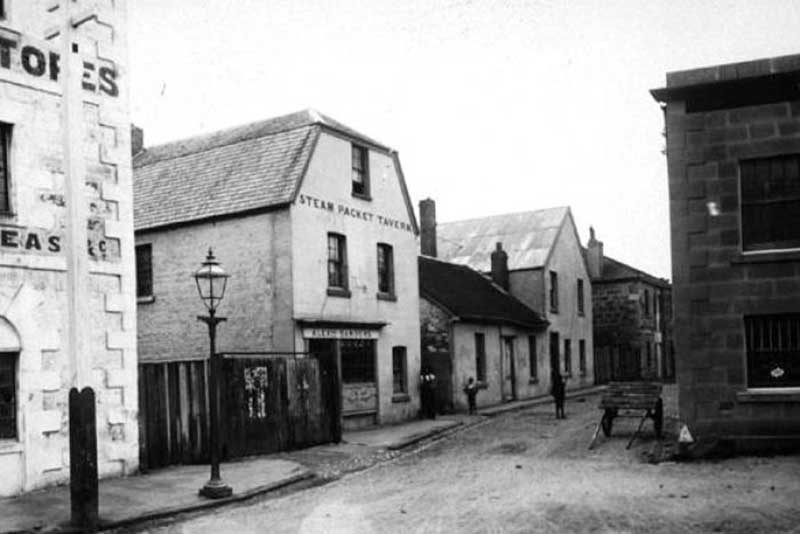
The area to the east of Campbell Street and south of Collins Street was known in the colonial days as Wapping, so named because of its similiarity to the Wapping district of London. The settlement sprang up around Hobart's early wharf at Hunter Street and endured until it was almost obliterated by industrial and commercial pressures of the mid-20th century. Its profile was one of poverty and prostitutes, a community comprised of Hobart's poorest of the poor, working class people who were employed by the nearby factories — jam, tanneries, ice, soap, gasworks and a slaughter house
Wapping had its own Ragged School, a Hobart version of the free education which charities ran in Victorian England. The name of the street on which it stood - Ragged Street - gives the only hint today of life in this poorer area of early Hobart. It is believed the former convict Ikey Solomon, believed to have been a Wapping resident, was the inspiration for one of Charles Dickens' famous characters, his Oliver Twist character, Fagin, who lived in London's Wapping. Solomon's shady reputation as a trainer of pickpockets and receiver of stolen goods preceded his arrival in 1820s Hobart.
The district's long association with public transport began in 1875 with the construction of Hobart's railway station and workshops. Later, a tram depot was also established there. The connection is reflected in the name of Terminus Street, which formed the back entrance to the tram depot.
More >
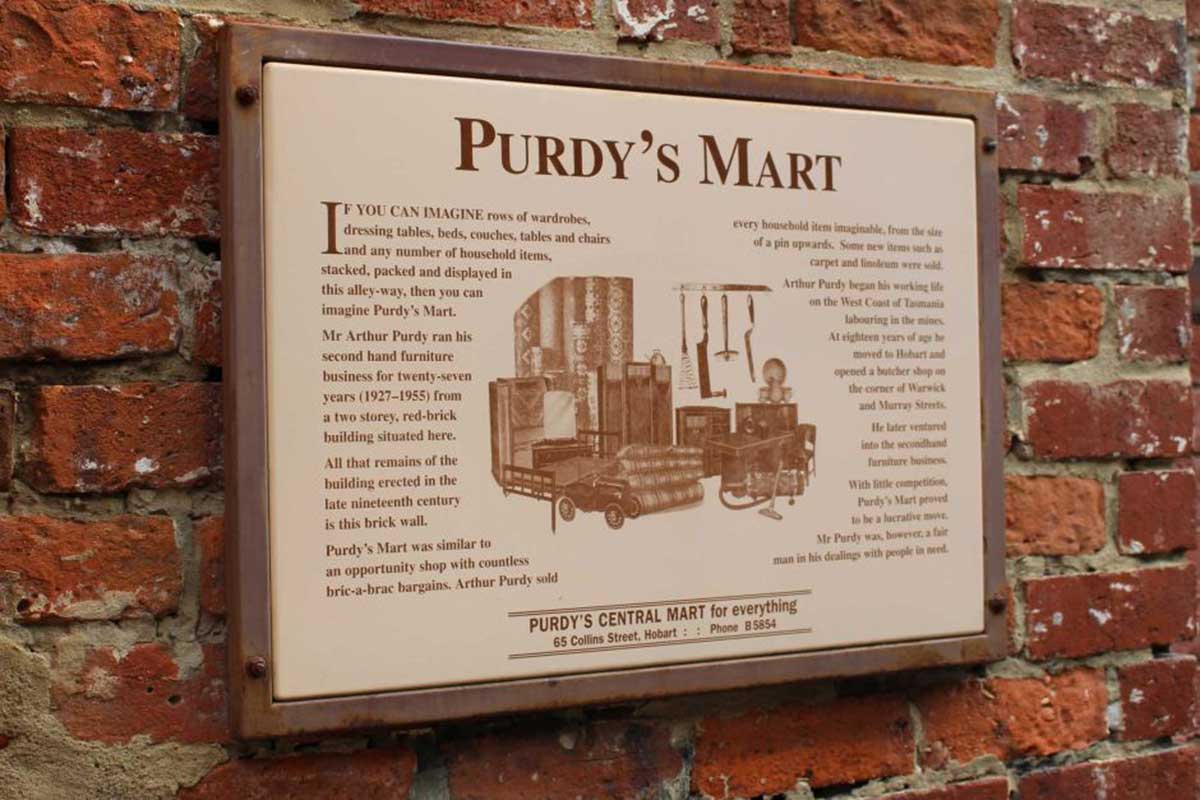
Purdy's Mart is a small laneway off Collins Street which recalls the name of a second hand furniture store that traded here for 27 years between 1927 and 1977. Arthur Purdy ran the store from a 2-storey red brick building. All that remains of the building is a brick wall. The shop, which overflowed into the lane, was full of every household item imaginable.
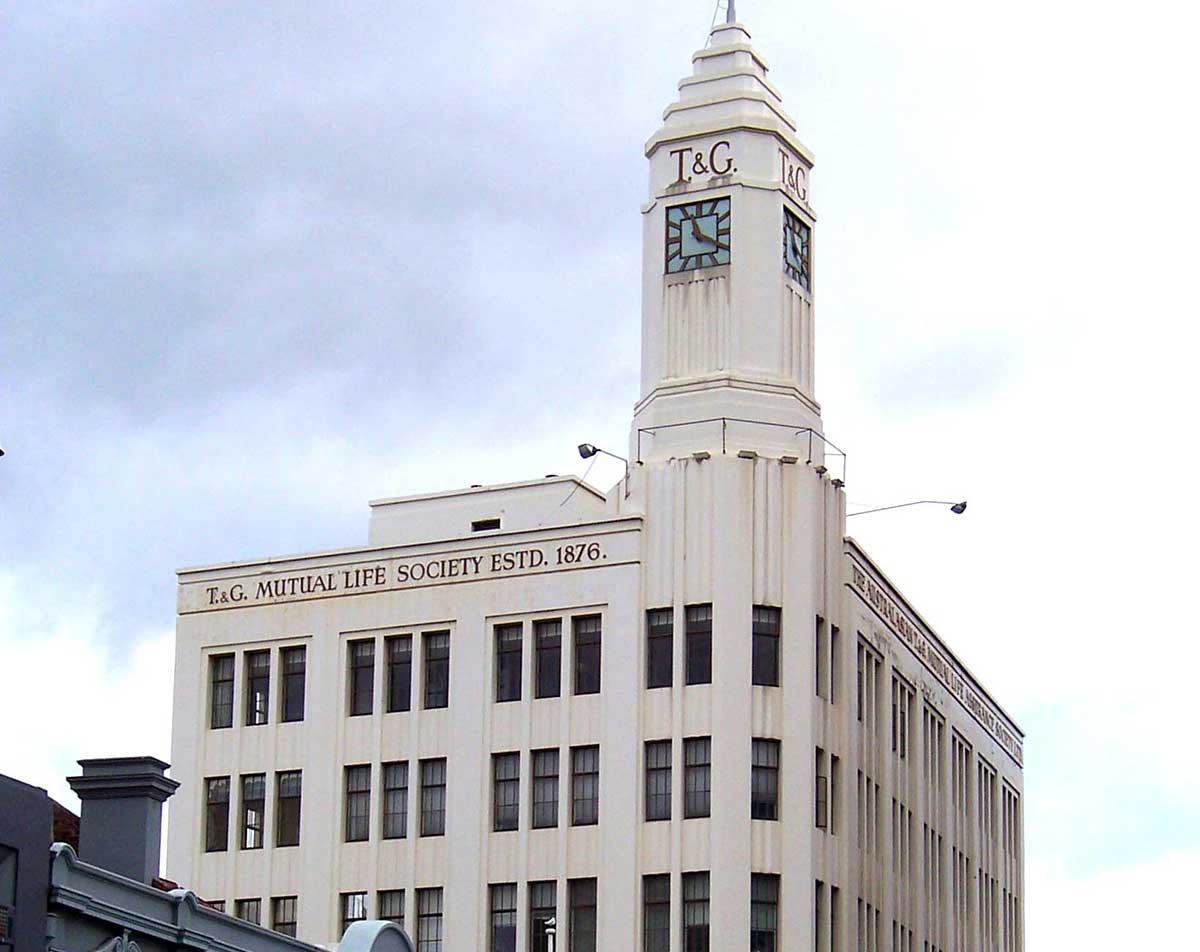
Six storey building with rendered brick facades modulated by alternate groups of windows with wide piers. It also features a distinctive stepped tower. The Society had a policy of providing its own premises in all capital cities of Australasia. The designs of T. & G. Buildings across Australia, New Zealand and some provincial areas, progressed with the architectural ideals of the day, together with a business philosophy expressed through the built form. Pinnacle towers were a common feature, symbolic of strength and able to be seen from a distance, and featuring the initials "T & G". A canopy overhanging the footpath is also a consistent element of the Society's buildings. The buildings were used to promote the essence of life assurance - tradition, prosperity and peaceful serenity for each generation. Architect: A. & K. Henderson, Melbourne.
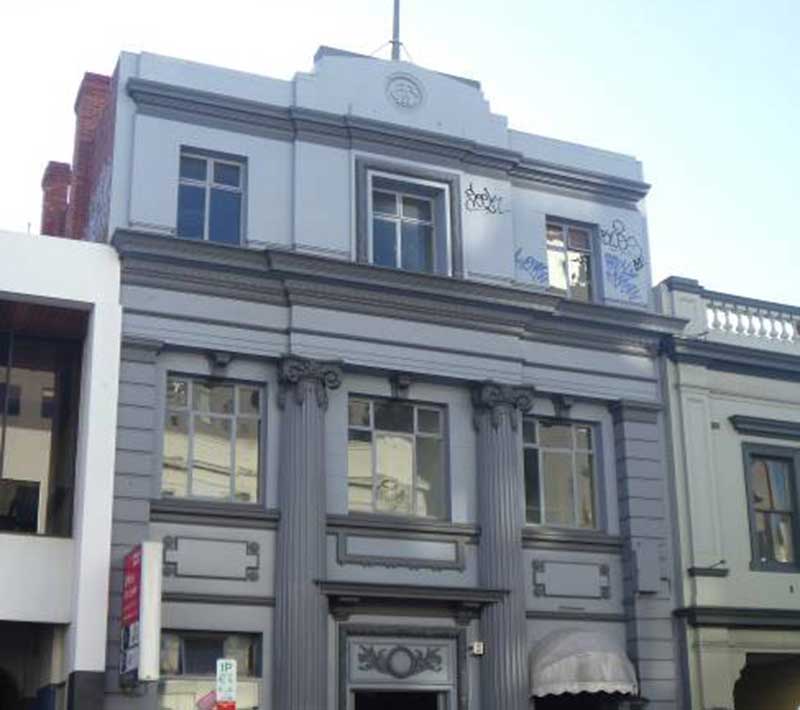
These premises, built for the Commercial Travellers Association Club, were opened in 1929. The ground floor contained a very spacious bar with blackwood panelling on the walls and a wide fireplace. A large reading room possessing every requirement for comfort was provided on the first floor along with a number of card rooms. There were billiard tables in the basement and a suite of rooms for the resident steward on the second floor. The Commercial Travellers Association of Tasmania had been founded in 1900. Commercial travellers were essentially travelling salesmen but when the Governor of Tasmania had laid the foundation stone for the building, he described them as ‘ambassadors of industry’ and ‘men of personality, character and persuasiveness.’Although the Association no longer exists, its initials are still proudly displayed on the building’s parapet.
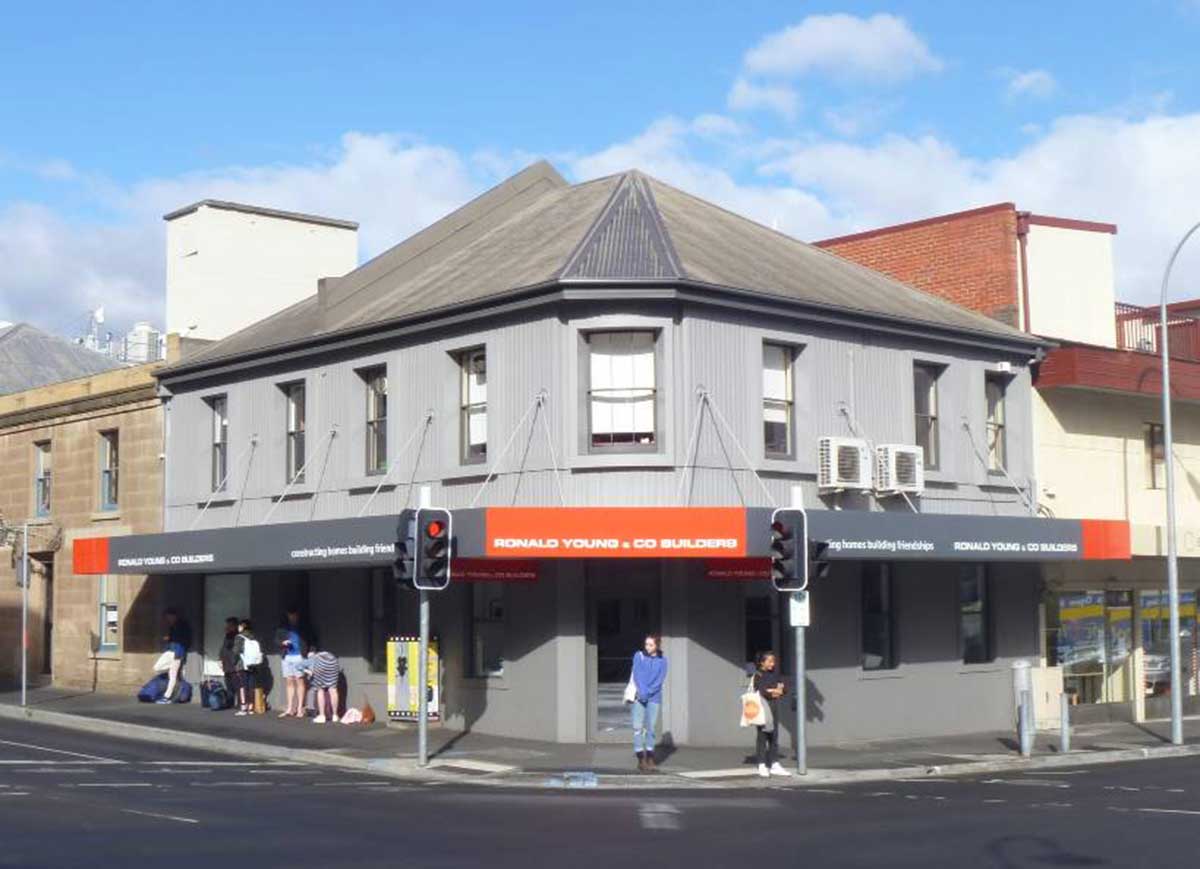
These premises were first licensed as the Boar’s Head in 1845 but the name was changed to the Golden Gate the following year. The pub’s name was changed again in 1868, when it became the Turkish Bath Hotel. A few months earlier the Turkish Bath Company had opened a ‘luxurious bathing establishment’ on the south-west corner of the intersection.
Frederick Brown, a former employee of the Tasmanian Steam Navigation Company, became the hotel’s licensee in 1887 and changed its name to the City of Hobart Hotel. The new name commemorated one of the company’s steamers which had operated regular services between Tasmania and the Australian mainland. A large painting of the City of Hobart steamship was displayed above the hotel’s entrance. The hotel was delicensed at the end of 1919 and was subsequently converted into shops. For many years the shop on the corner was occupied by a Chinaman called Wing Shing.
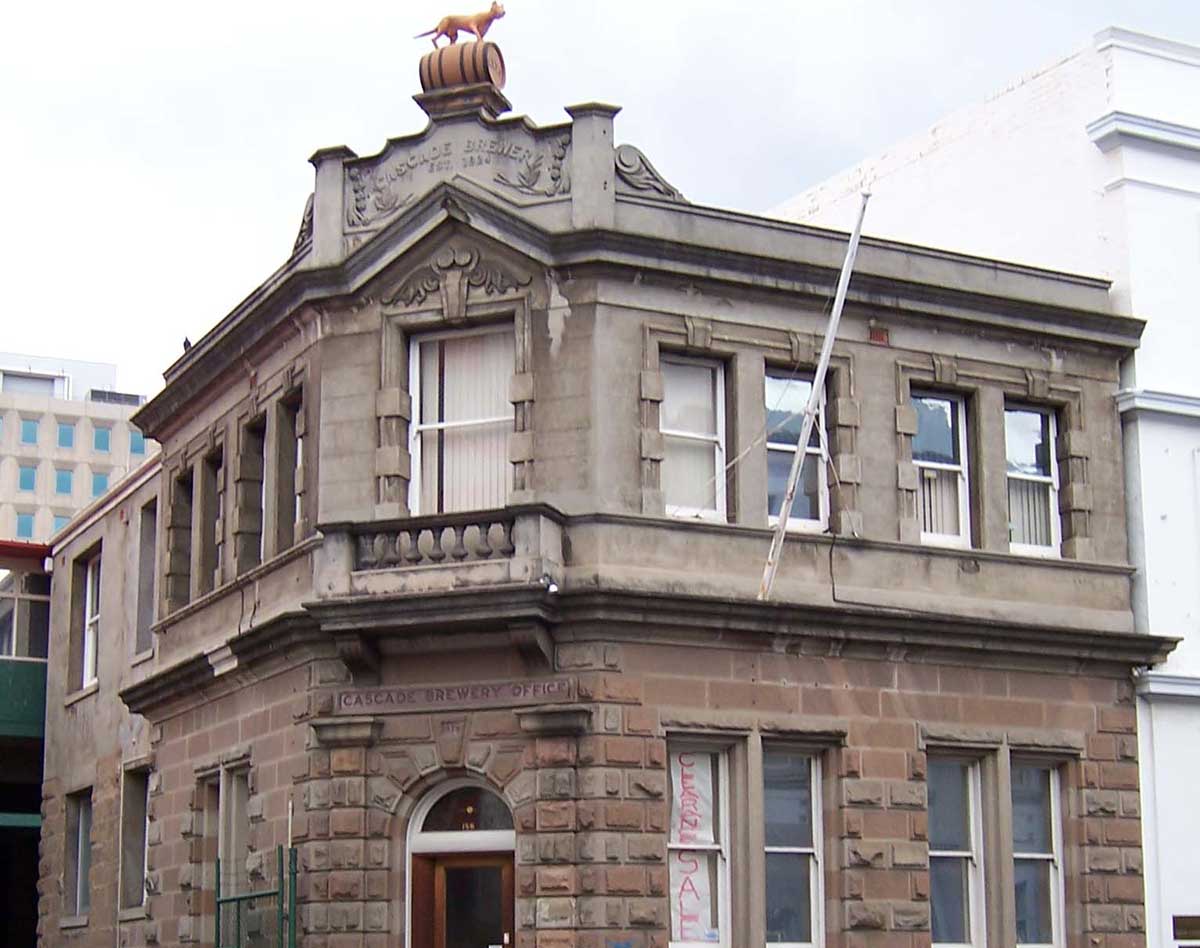
This two storey rusticated sandstone office building is in the Victorian Free Classical style. The main entrance is situated within the splay corner which fronts onto Collins Street. Either side of the main entrance are two engaged stone pillars, and an arch comprising voussoirs and a keystone are located above the fanlight. Pairs of double hung single-paned windows dominate the building. Statues of the company's symbols - the now extinct Tasmanian Tiger and a beer barrel - are mounted at roof level above the main entrance.
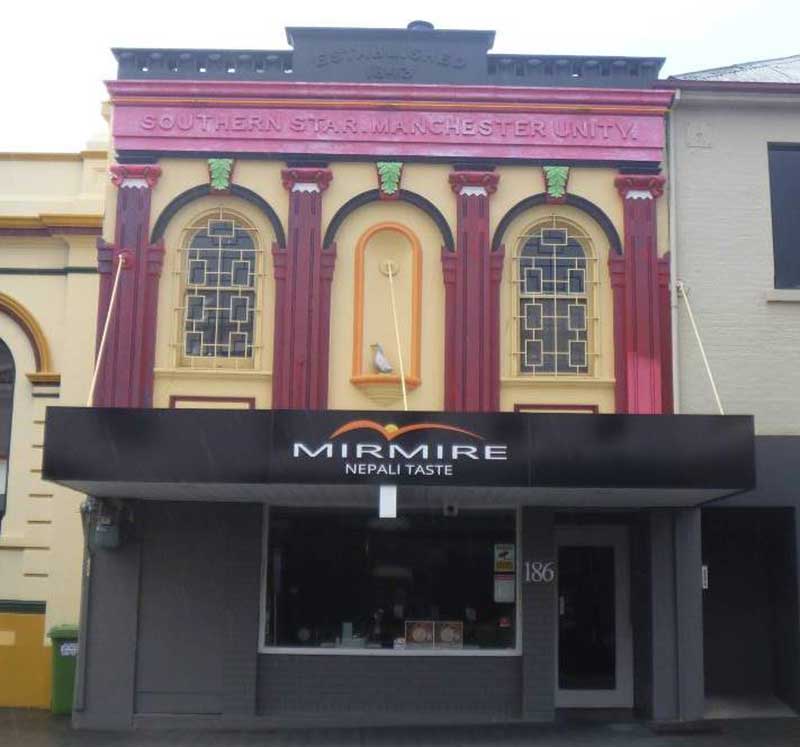
In the days before the state-financed welfare, some working men came together to form friendly societies. Each member paid subscriptions into a central pool from which sickness benefits or funeral expenses could be paid out.Some of the friendly societies had unusual names, such as the Independent Order of Odd Fellows of the Manchester Unity. The first branch of the Manchester Unity in Hobart was established in 1843 and was known as the Southern Star Lodge. By 1876 more than 140 members had joined the lodge and it decided to purchase its own premises so that it wouldn’t have to hold its meetings at public houses. The front facade was remodelled in an elaborate Romanesque style and the words ‘Southern Star, Manchester Unity, Established 1843’ were displayed on the parapet.
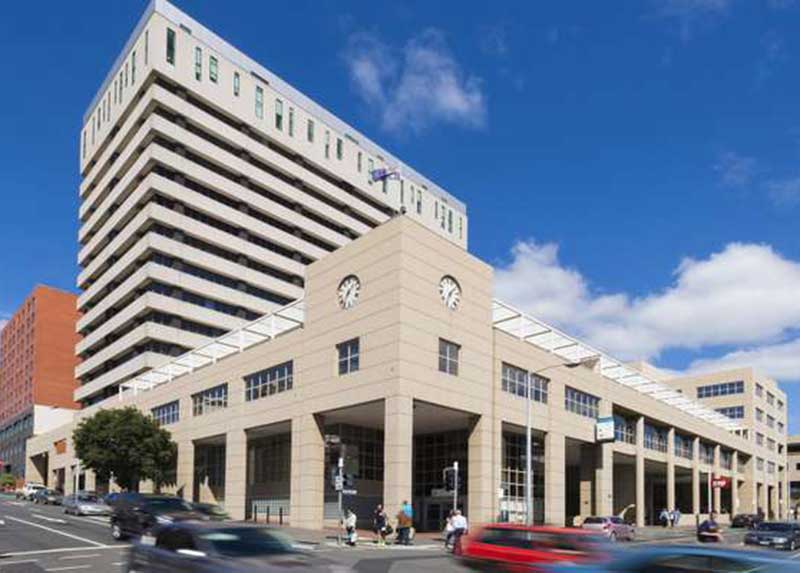
An iconic Post Moderne office building in Hobart's central business district, it is known as the Commonwealth Government Centre. Construction of the Tower building commenced in 1969. The 13 floor building was officially opened on 22nd February 1974 by the Prime Minister, Gough Whitlam. In the early 1990’s, three podium buildings were constructed around the existing Tower building: Blocks 1, 2 and 3 provide an additional 8,500m? of quality office accommodation. The 52 metres high building has 16 floors, 83 secure under cover car parks and a further 12 open air parking spaces.
Named by Gov. Macquarie in 1810 on his first visit to Hobart in honour of Robert Banks Jenkinson, Earl of Liverpool. Jenkinson was Home Secretary between 1804 and 1806 and Secretary of State for War and Colonies between 1807 and 1809. He was responsible for appointing Macquarie as Governor os New South Wales.
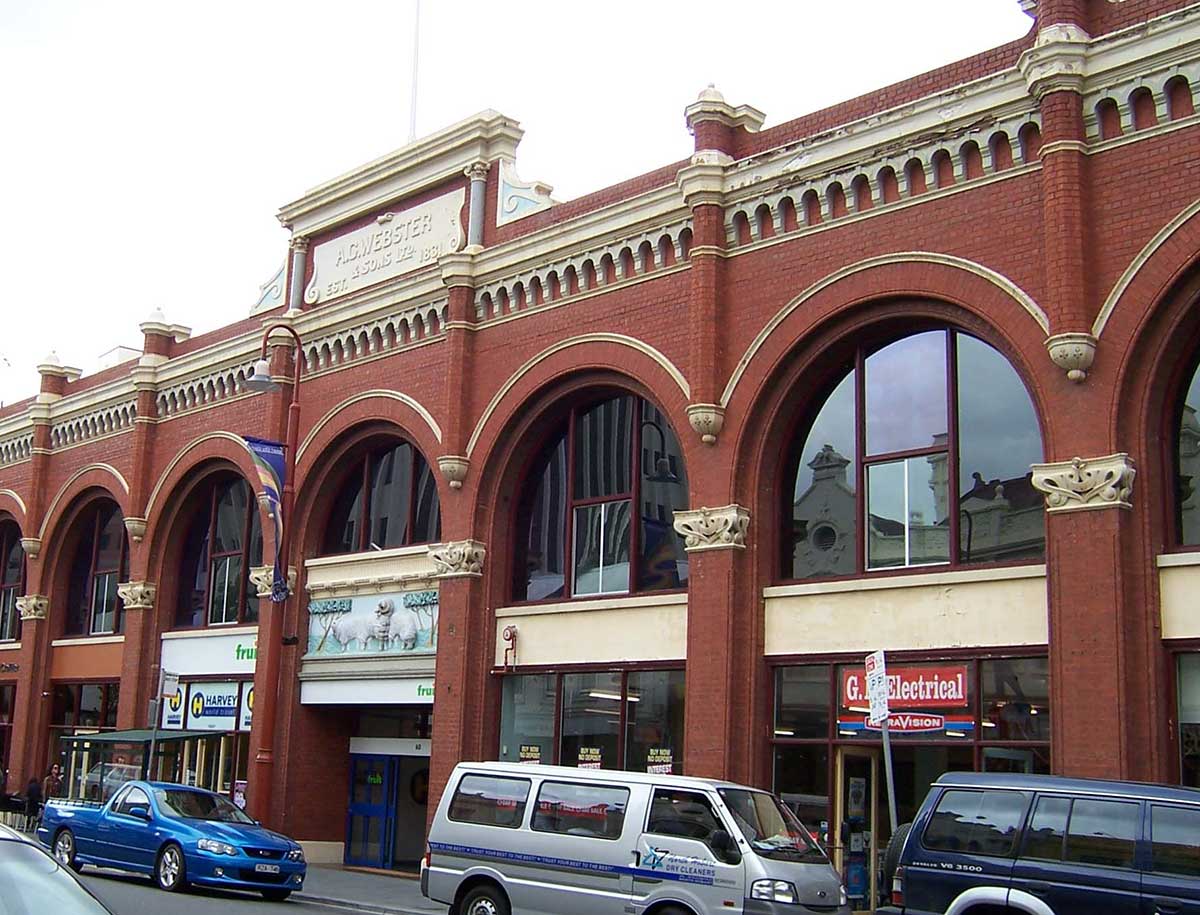
A two storey red brick building erected as the headquarters of the Tasmanian Wool and Agricultural Company. It consists of wide two storey arched bays and intermediate piers with bonded pilasters and a terminating corbelled parapet. There are egg and darts mouldings below the cornice and the central entry has a merino sheep bas-relief spandrel over painted pilaster capitals and a parapet trim.
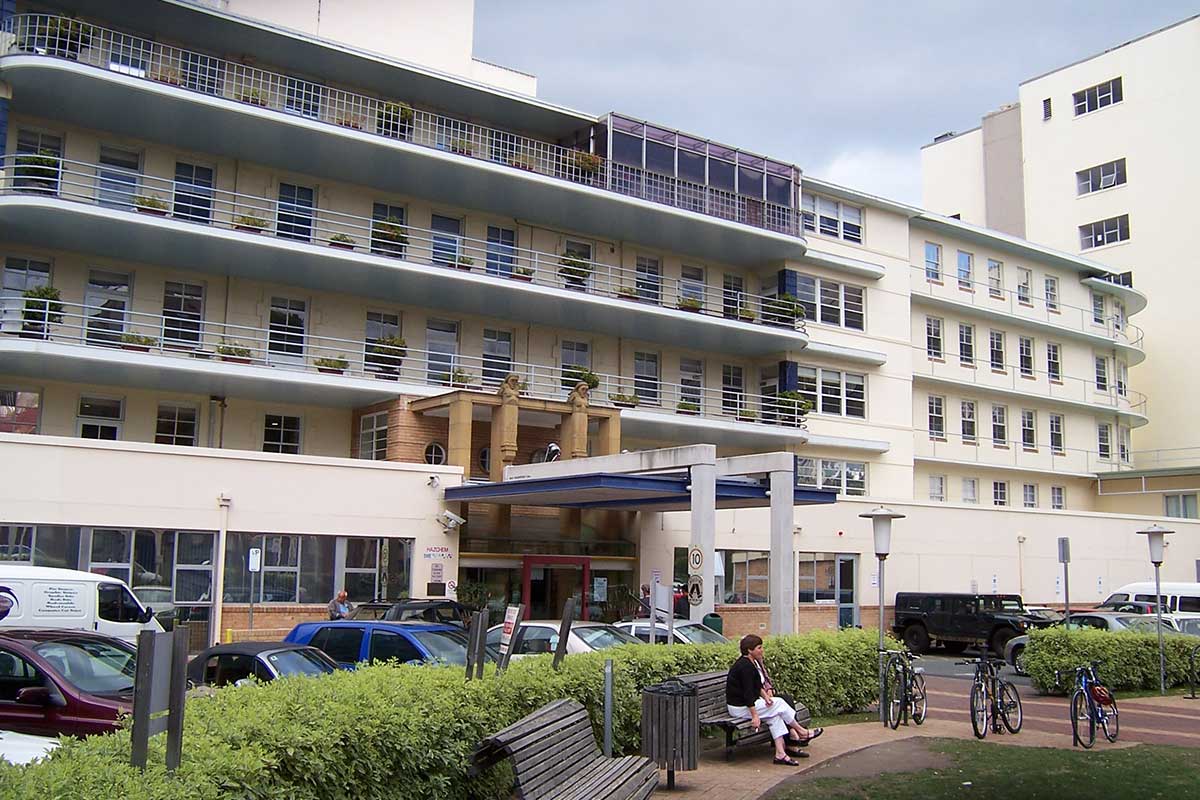
One of the finest examples of the Moderne Idiom on a large scale public building in Australia, frequent additions and alterations have overwhelmed the integrity of the elegant, streamlined original building. Architects: Leighton Irwin (Melbourne).
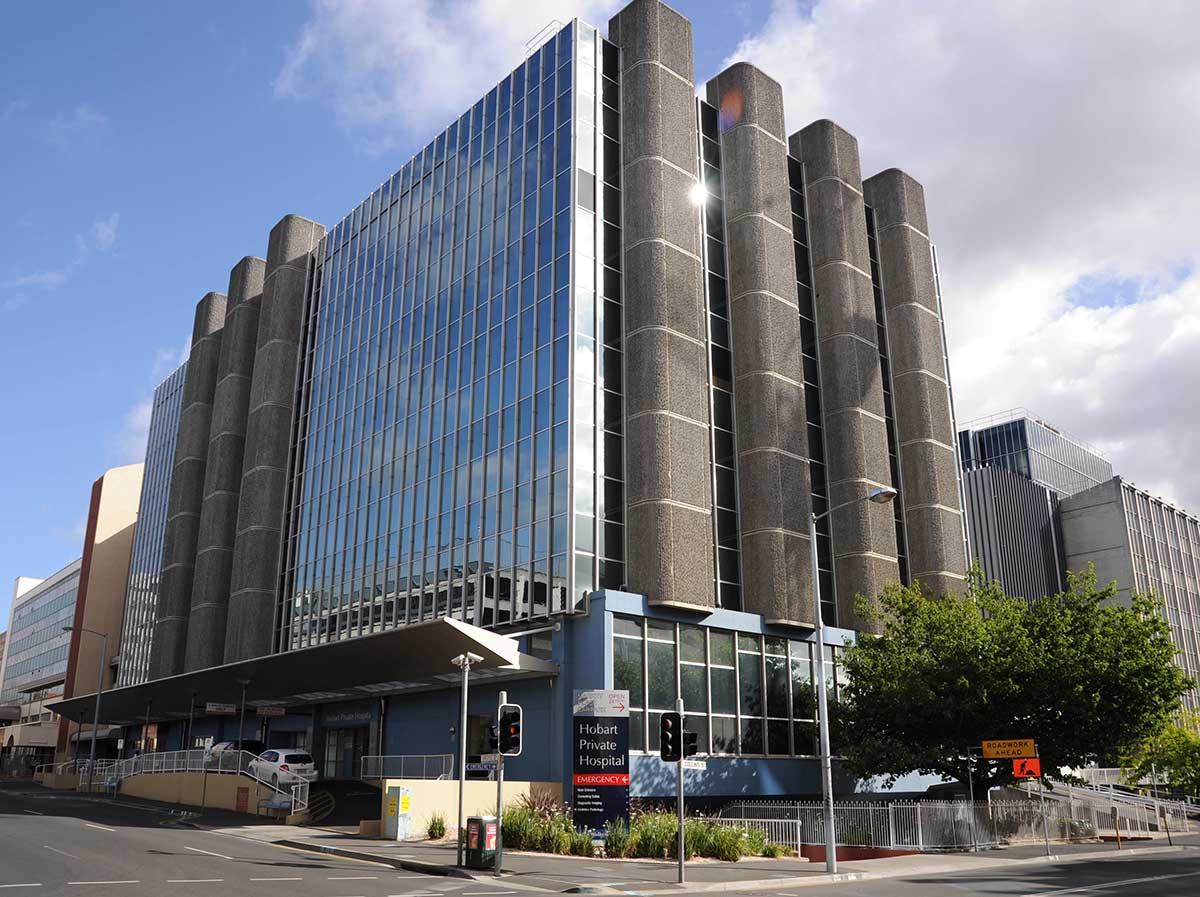
The hospital was built as a new wing of the Royal Hobart Hospital. In 1980, the Queen Alexandra maternity hospital building in Battery Point (1902) was deemed too antiquated for modern health care services, and was closed. The Queen Alexandra hospital was moved to the new wing attached to the Royal. In 1999, the Queen Alexandra wing was closed and sold off to a private consortium, who re-opened the site as the Hobart Private Hospital.
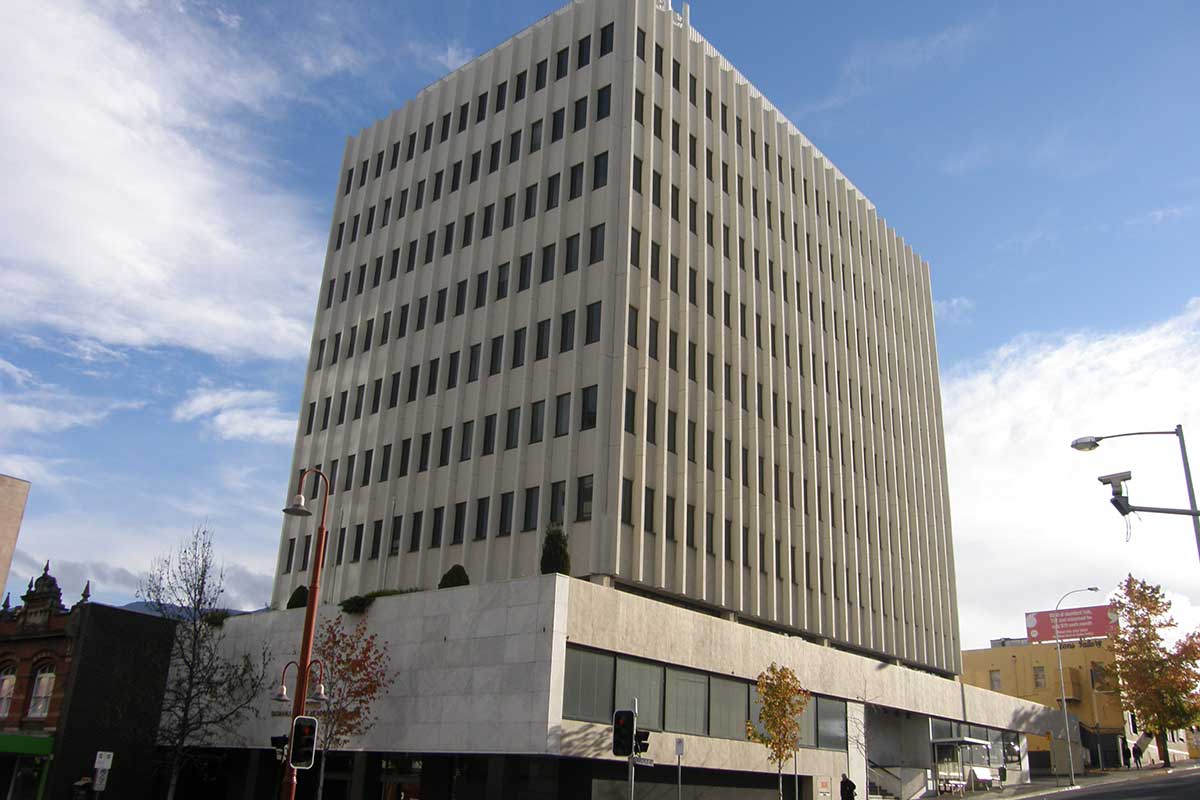
One of a number of medium-height office buildings erected in the late 1970s/early 1980s which had a dramatic effect on the Hobart skyline. The lower entrance of the building is clad with marble and sweeps around the corner of the building in a horizontal fashion, which emphasises the vertical banding of the rest of the building. With 9 floors, it is a typical Hobart high-rise building that lacks the height factor of such buildings in other capital cities around Australia.
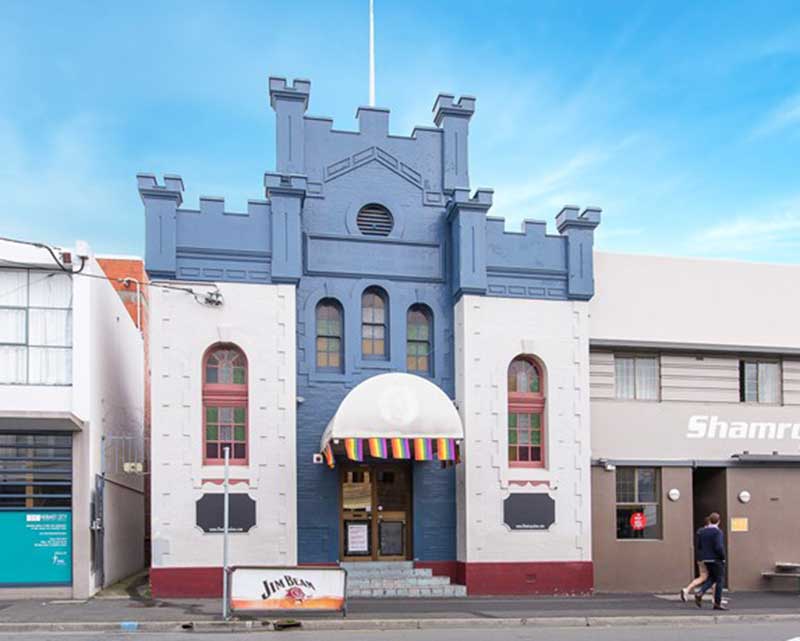
This turreted building was erected in 1910 to serve as the Hobart headquarters of the Salvation Army. William Booth had established the Salvation Army in London in 1865 with the object of bringing salvation to the poor, destitute and hungry. The Army quickly spread throughout the Commonwealth and around the world, reaching Tasmania in 1883. A distinctive feature of the organisation was its use of military terminology. The Salvation Army Citadel in Liverpool Street contained a hall capable of seating 450 soldiers. The building had been designed by Lieut-Colonel Saunders and its construction was organised by Brigadier Hammond, with Ensign Winton in charge of collecting donations from the public.
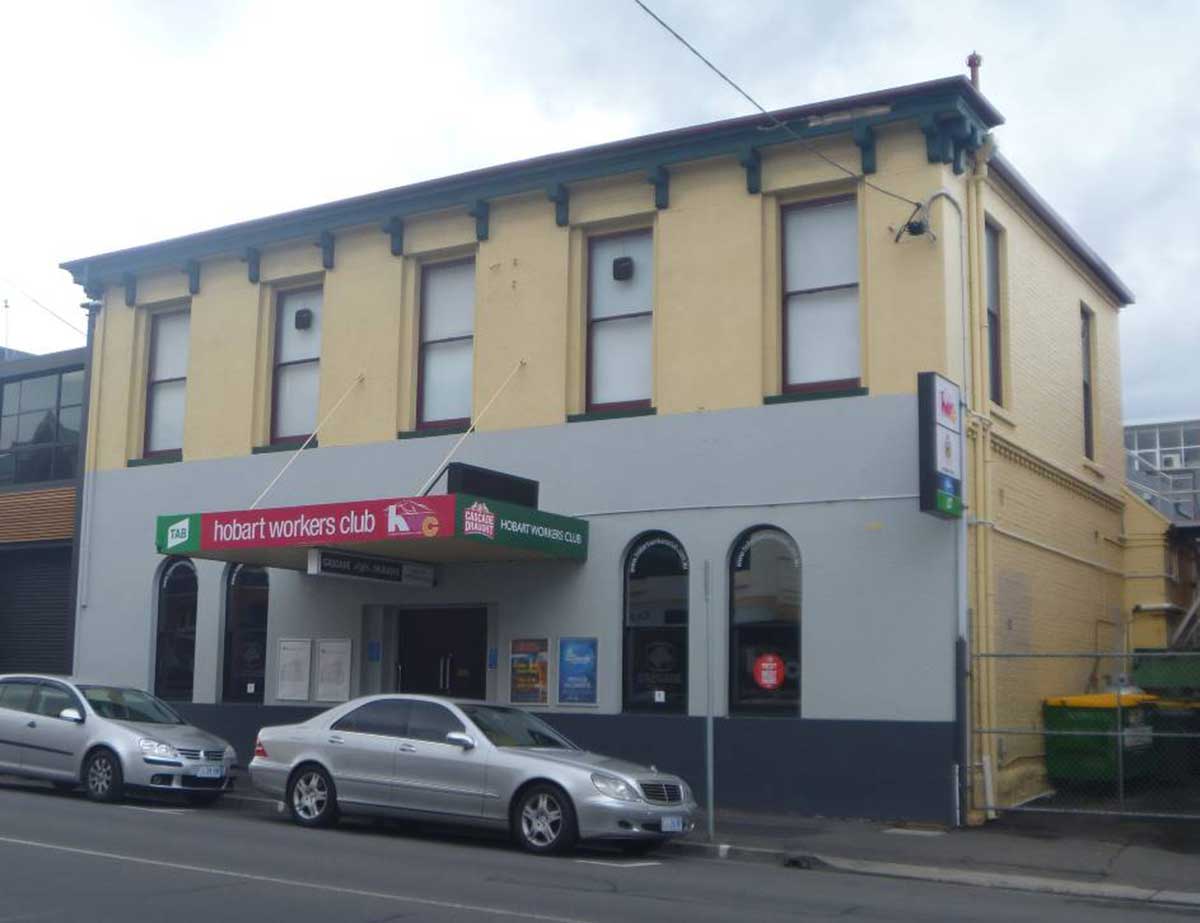
The Hobart Working Men’s Club was formed in 1864 to provide an alcohol-free venue for the social recreation of the labouring classes. The club house in Liverpool Street was built in 1867 following a ₤1,000 donation from a generous philanthropist who wished to remain unknown. The club opened every evening from 6 until 10 o’clock and the entrance fee was six pence. A library and reading room contained newspapers, periodicals and entertaining books. Facilities were afforded for playing draughts and dominoes but there was to be no gambling. There were also billiard tables and some of the members became very expert with the cue. The premises became licensed in 1936.
Named by Gov. Lachlan Macquarie in honour of his direct superior, the Secretary of War and the Colonies, Henry Bathurst, 3rd Earl of Bathurst (1762-1834), the 3rd Earl of Bathurst. Secretary of State for the Colonies and member of parliament for Cirencester in 1783, Bathurst was Lord of the Admiralty from 1783 to 1789, Lord of the Treasury from 1789 to 1791, Commissioner of the Board of Control from 1791 to 1802. He held many other offices until his death 27th July 1834.
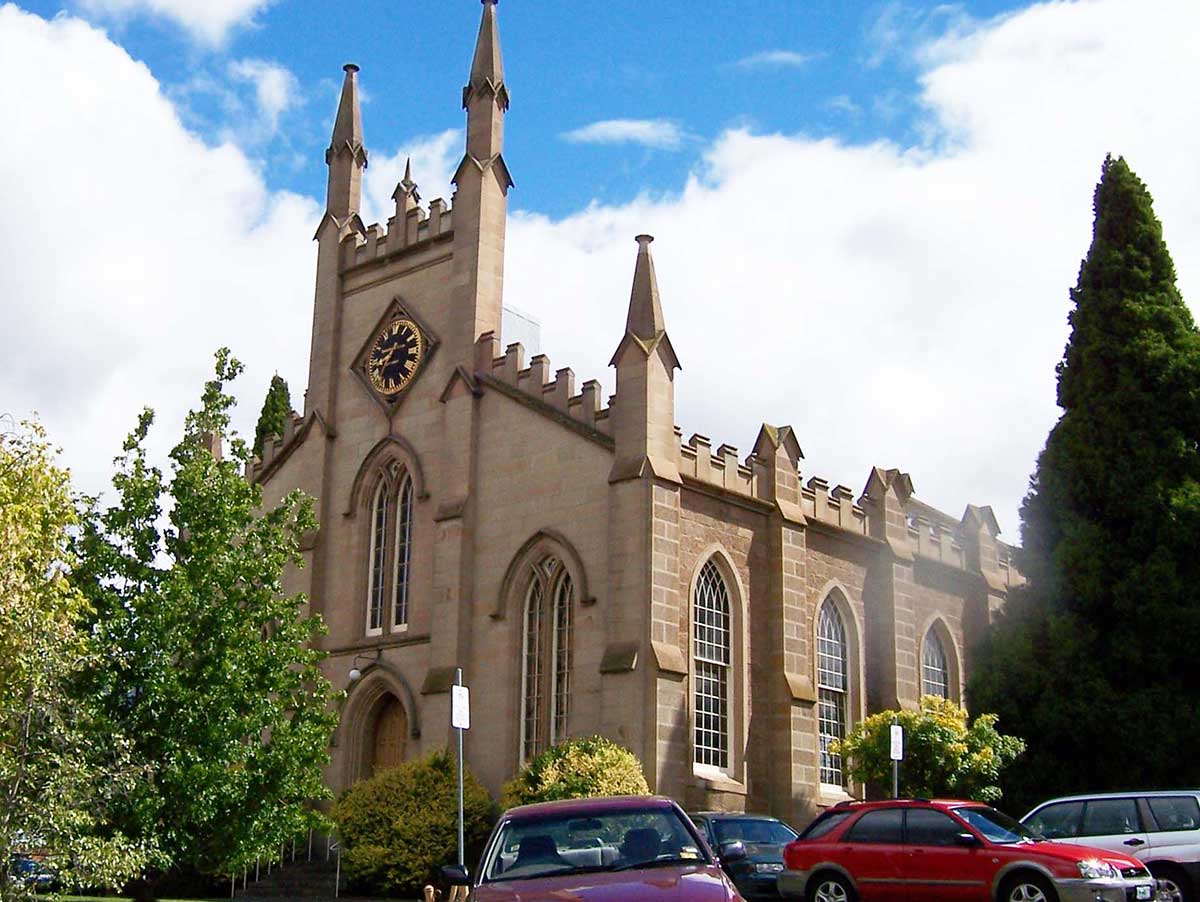
Formerly St Andrew's Church, it is an early Georgian Gothic stone church, designed by J.E. Addison and built by his firm, Jackson & Addison. It features a central tower-like parapet and four small spires. The parapet crenellations surround the building. The structure was extended 3 metres in 1860 to accommodate a new organ. Its neighbouring hall is a simple Colonial sandstone chapel of coursed undressed brickwork, built in 1824 and attributed to W. Wilson. It was the original church. Its foundation stone was laid by Lieut. Gov. Arthur on 2nd March 1824.
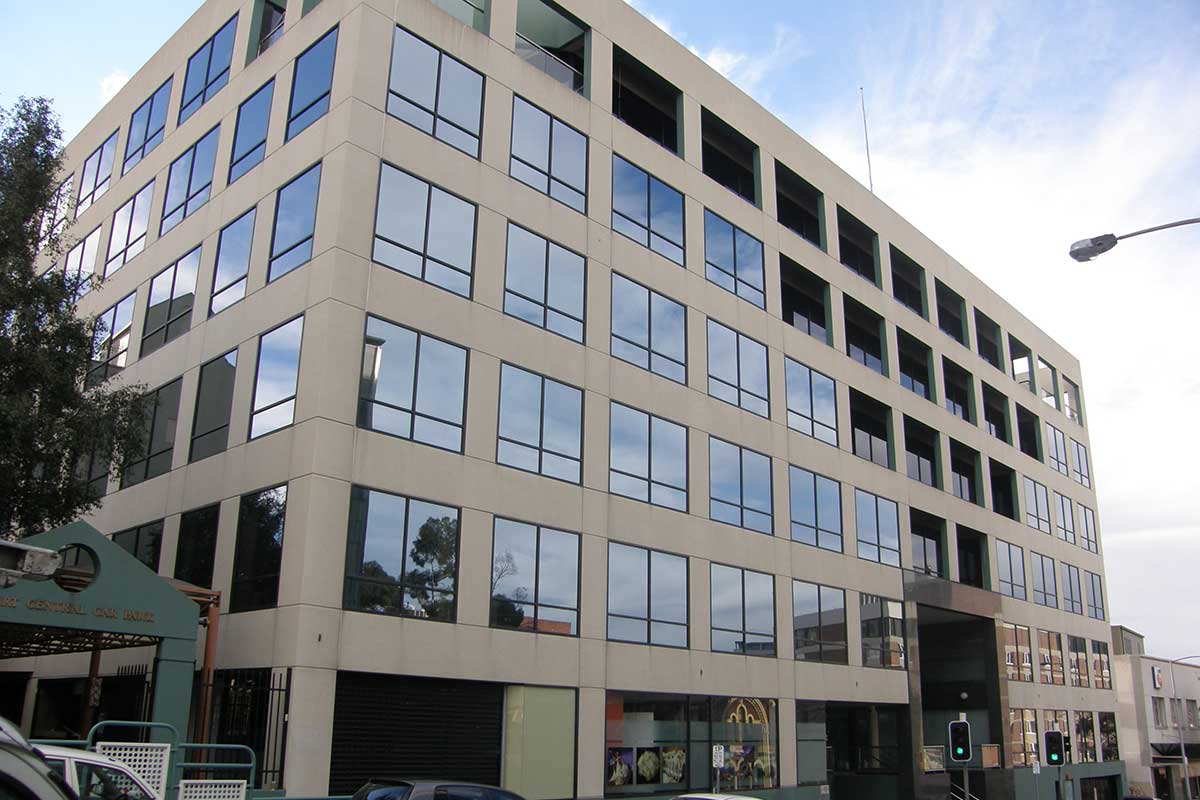
A low rise Post Moderne office building, very similar in style and design to the MBF Buildings, which was built around the same time.
6 floors.
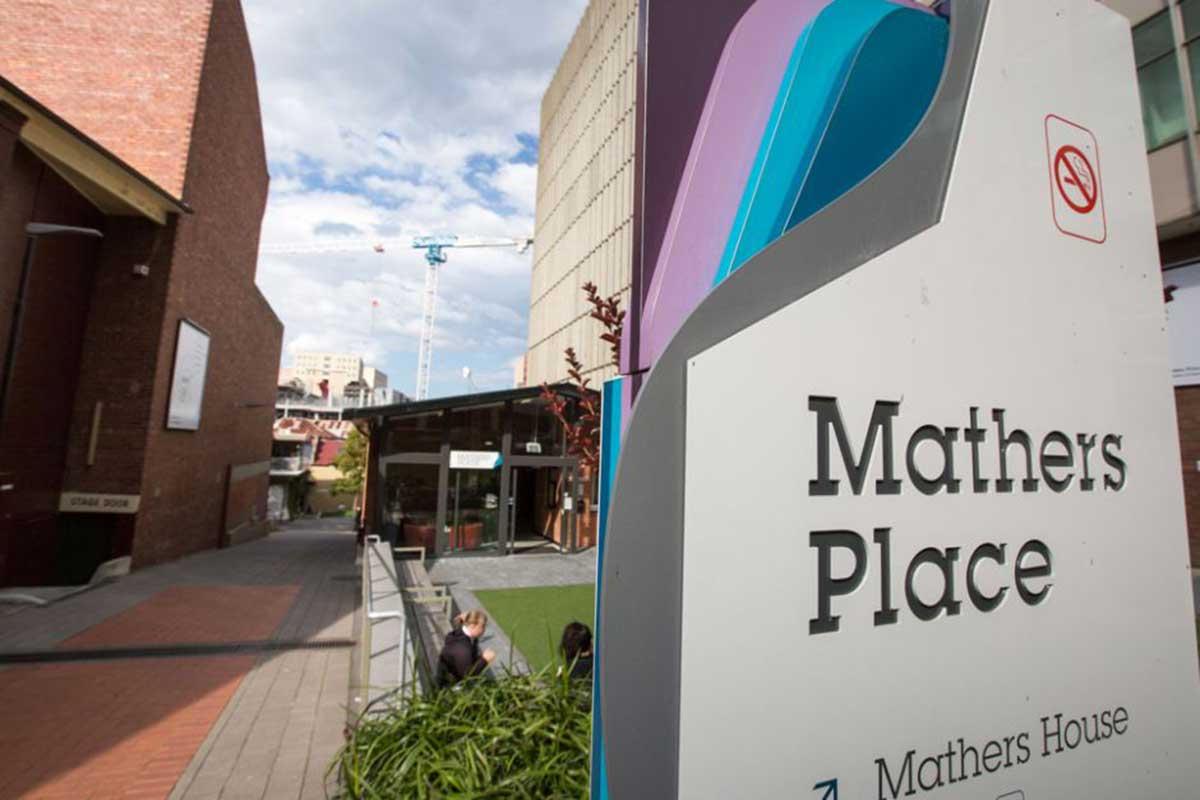
Mathers Lane recalls Robert Mather (1782–1855), who arrived in Hobart on 10 September 1822. He set up in business at the corner of Elizabeth and Liverpool Streets, selling goods and implements. In 1823 he was appointed a foundation trustee of the Wesleyan Church. In 1824 he held some 2000 acres (809 ha) which he called Lauderdale. Mathers House offers a range of programs and activities for older people.
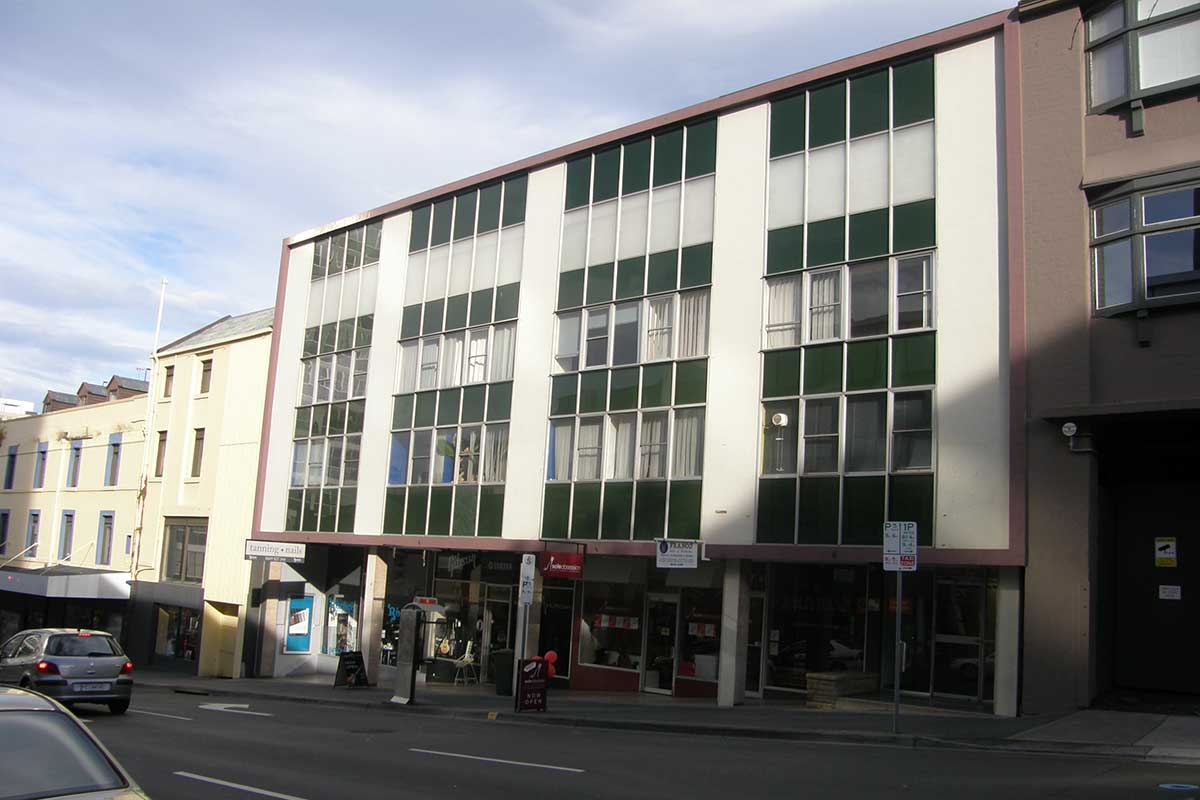
A scaled down version of an international style office building, but still featuring the curtain wall effect on its street frontage. Five plain vertical concrete strips separate the "curtains".
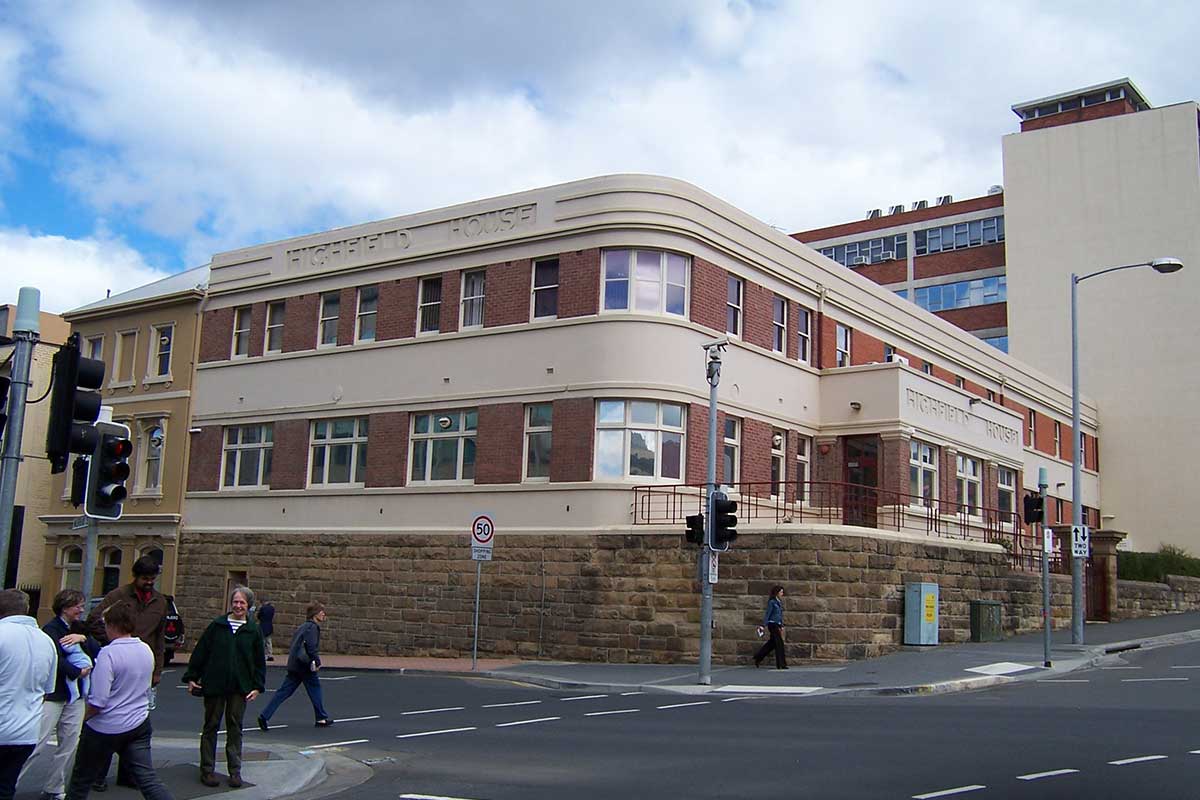
A red brick and cream finish Art Deco building in central Hobart. Its design style is similar to the Technical College building in Hobart. The cream bands and the curve at the corner really lift it above the ordinary. The Government owned 2 storey building has been empty since 2008.
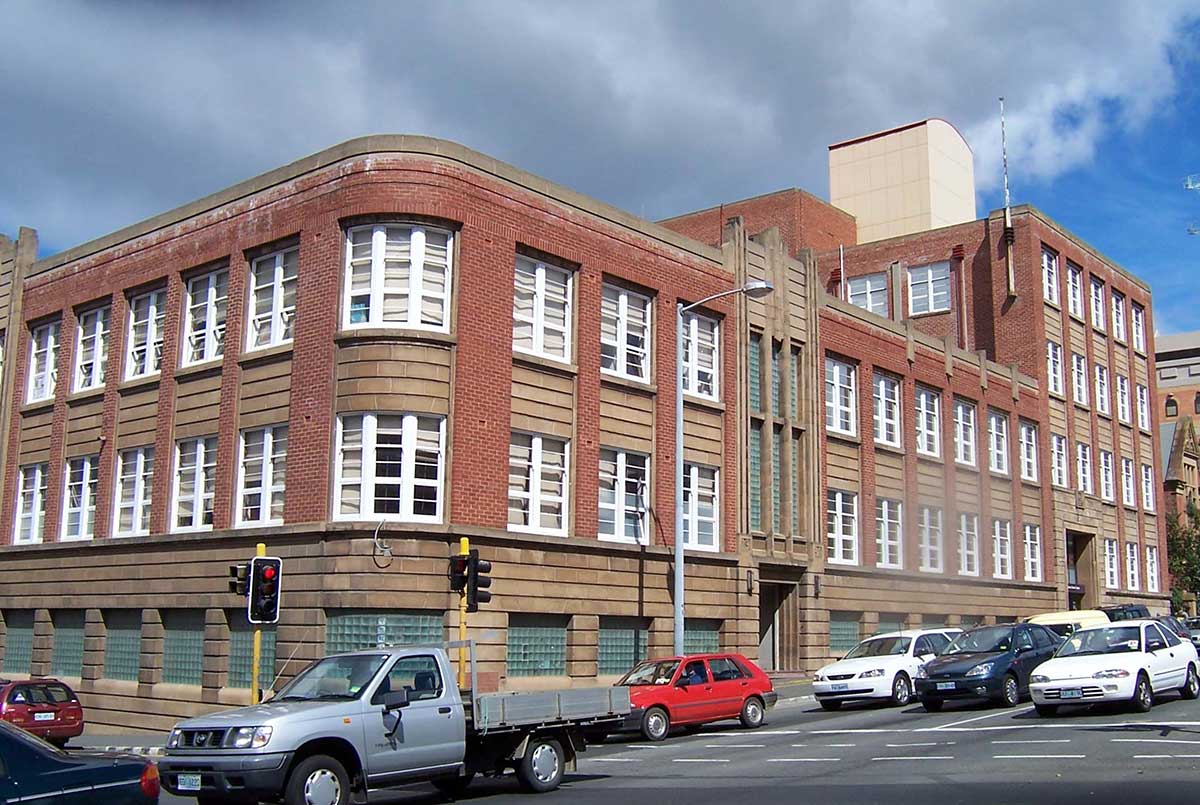
An impressive building which sweeps around the corner. The building has many interesting features, including a wall above the entrances of square cube glass on both of it's North and East facing entrances, as well as an interesting combination of brick and sandstone being used to create the building. It was designed by Sydney W T Blythe, who designed many Government buildings throughout Tasmania, one of his most recognisable being the massive Ogilvie High School.
Named by Gov. Lachlan Macquarie in honour of Capt. John Hunter, Second Captain First Fleet vessel HMS Sirius, and Governor of NSW, 11th September, 1795 to 27th September, 1800.
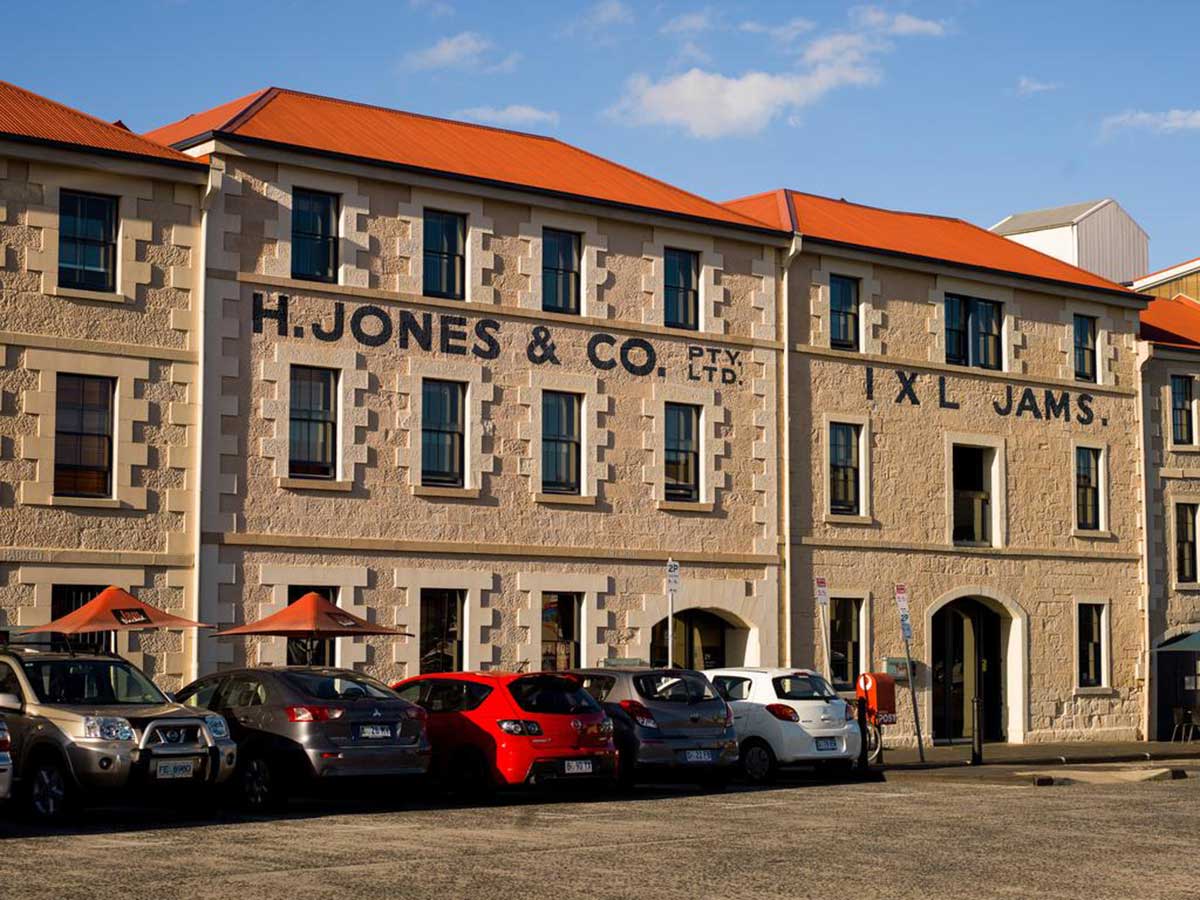
These stores, built for Henry Jones' famous IXL Jam manufacturing company, are part of one of Australia's finest harbourside colonial warehouse streetscapes. The nine connected, mainly three storey stone buildings were constructed with ron roofs, arched goods entrys and Georgian windows. The buildings include two cold stores of neo renaissance detail and a sixteen bay brick warehouse with three storey high arches with giant order of bonded pilasters and bracketed cornice. Nos. 31 and 33 were built in the 1820s by William Bunster. In 1827, No. 31 was the Commercial Inn.
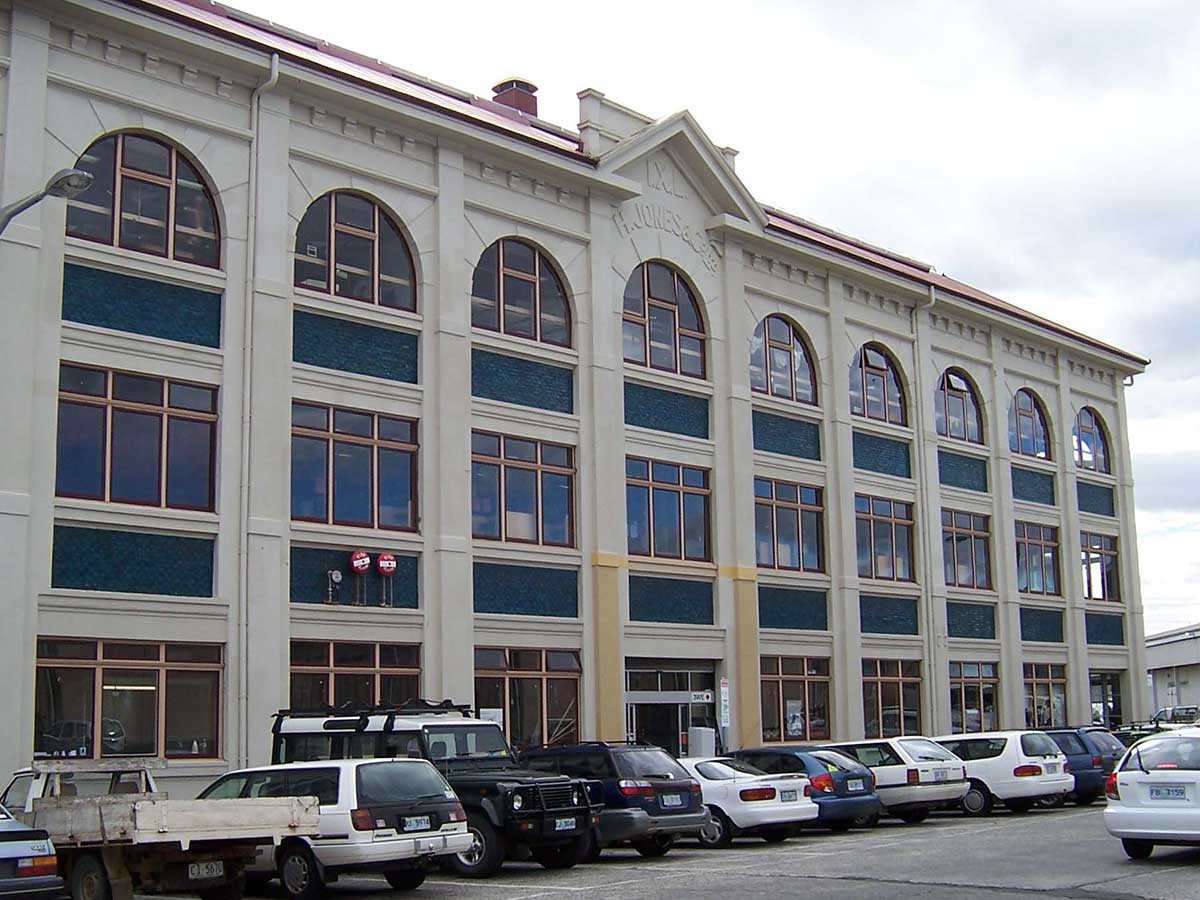
Built in Federation Warehouse, style, this warehouse building was custom built as part of the waterfront warehouse facilities of H Jones & Co's IXL buildings on Hunter Street. The company was first established by Henry Jones in the iconic warehouses next door in 1891. It was derived from Jones' employment with George Peacock's jam factory from 1874.
Named by Gov. Lachlan Macquarie, either after the place where he grew up - County Argyll, Scotland - or the Duke of Argyll, head of the clan Campbell, his wife's family.
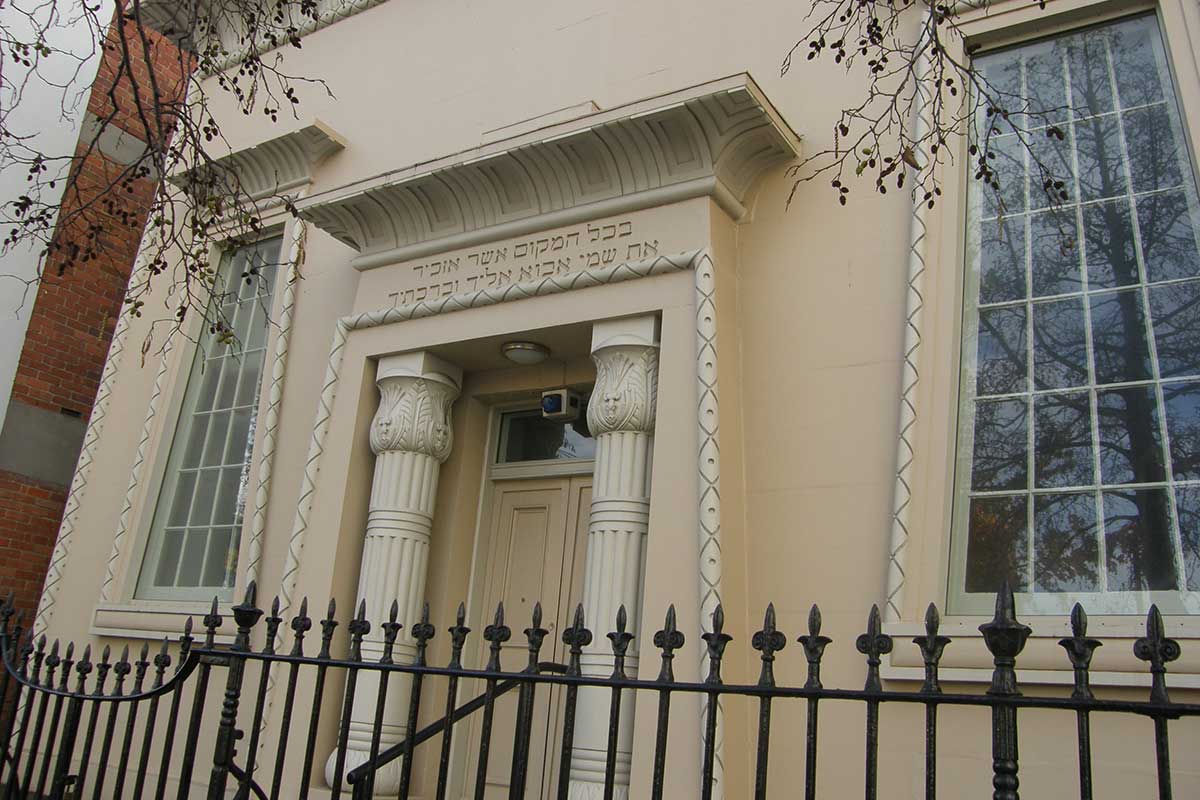
A single storey building designed by James Thomson, it is the oldest place of Jewish worship in Australia. It is a rare example of Regency Egyptian Revival style.
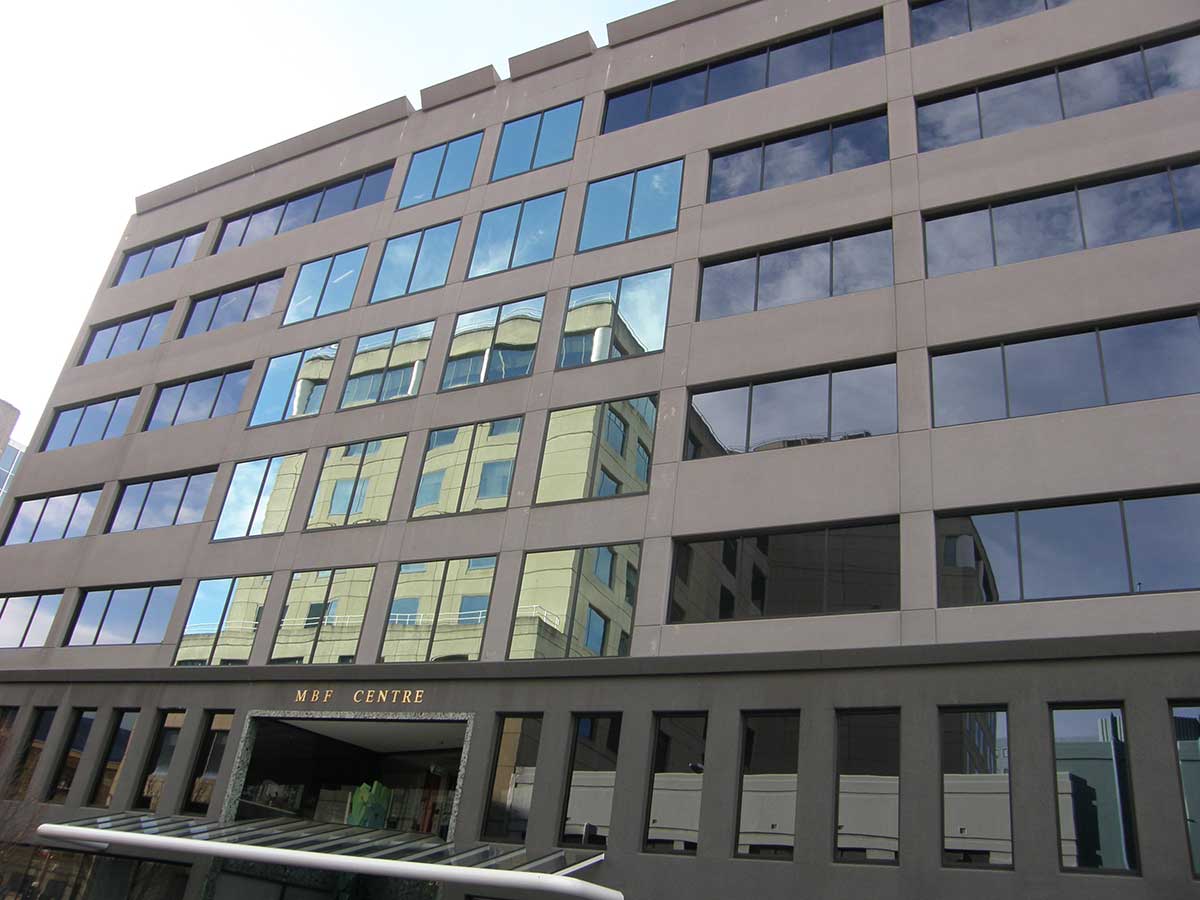
A low rise office building, that is home to the Medical Benefit Fund. It is typical of early Post Modern archirtecture, a simplistic design featuring large windows and limited decoration and ornamentation, whilst retaining the sleek look of the style. Height: 28.5 metres. 6 floors.